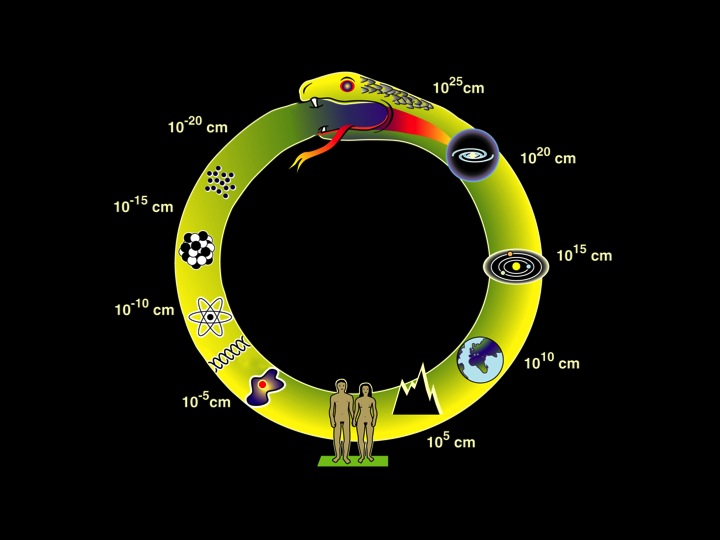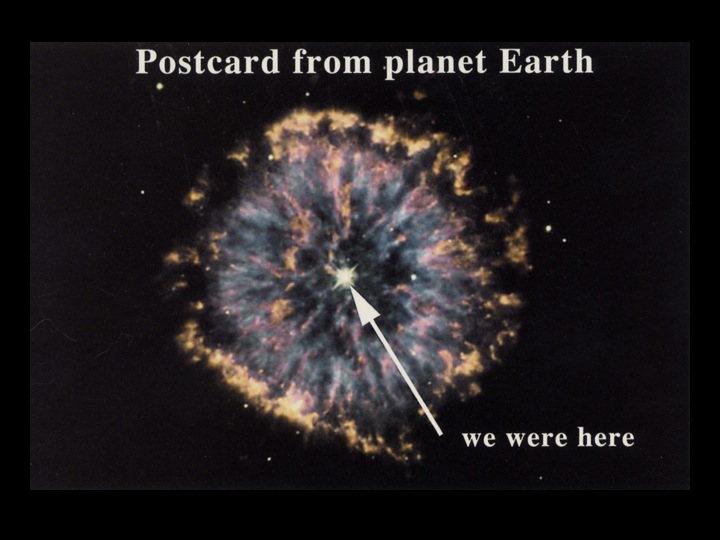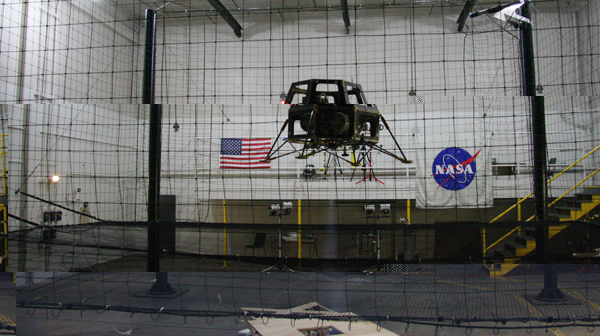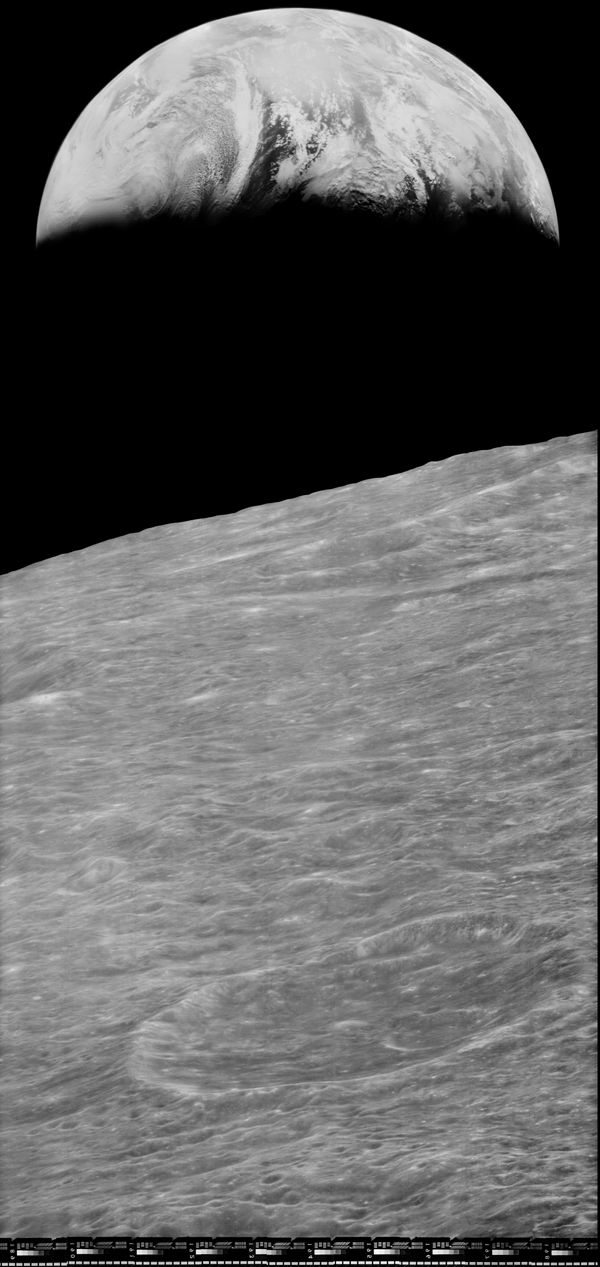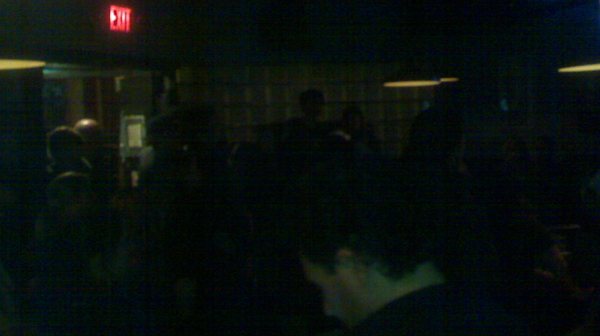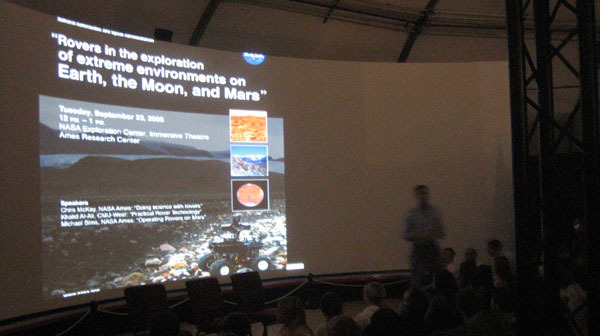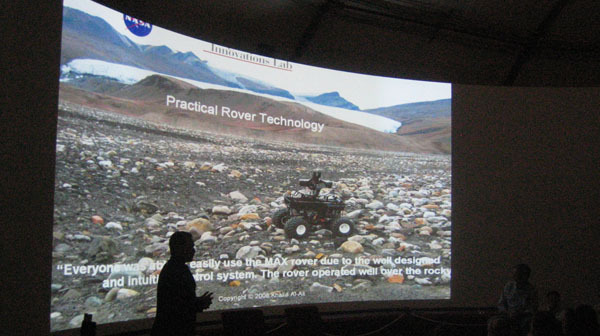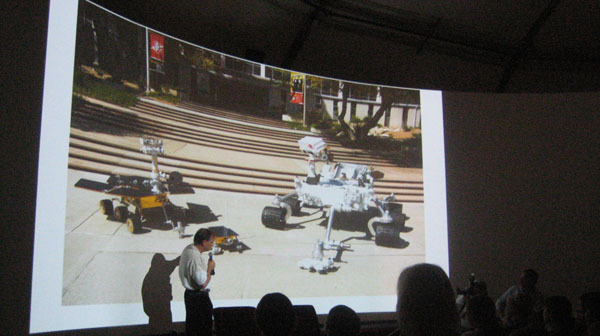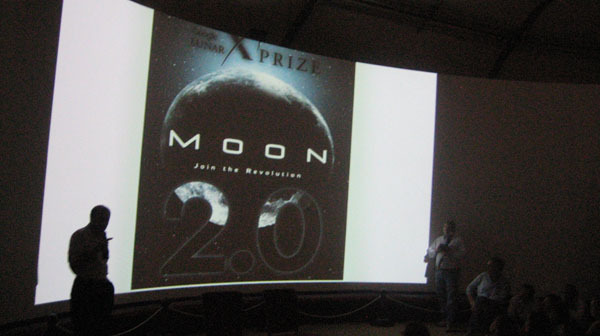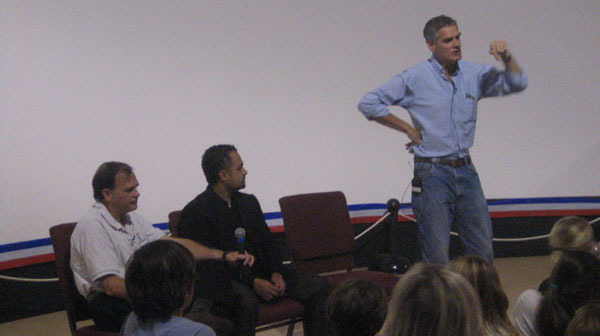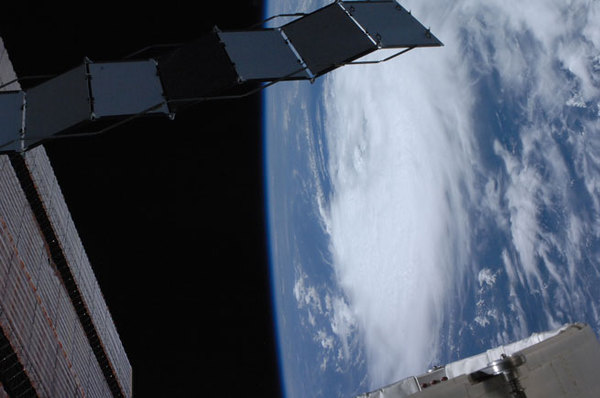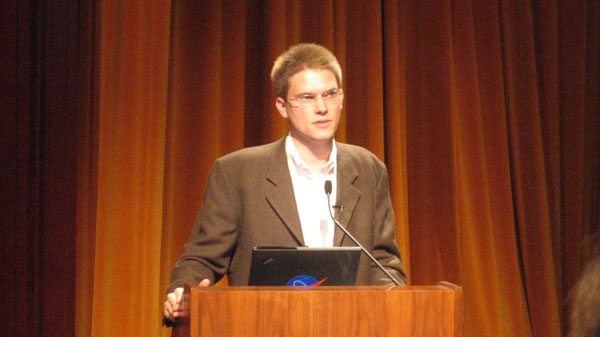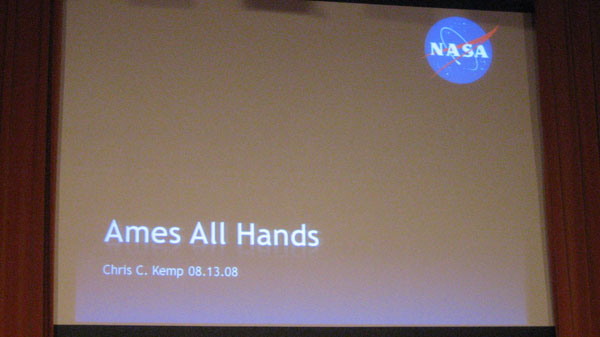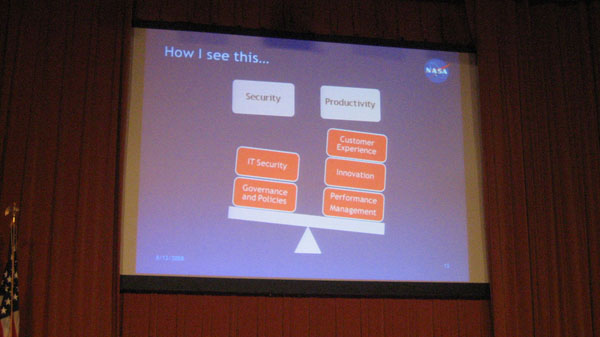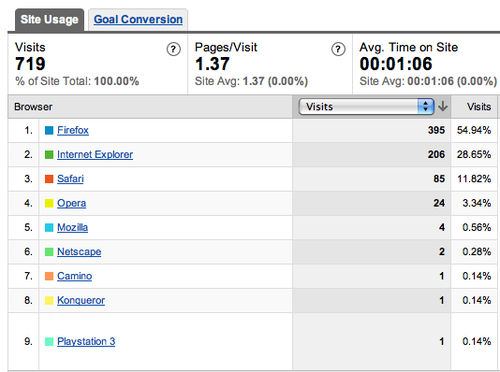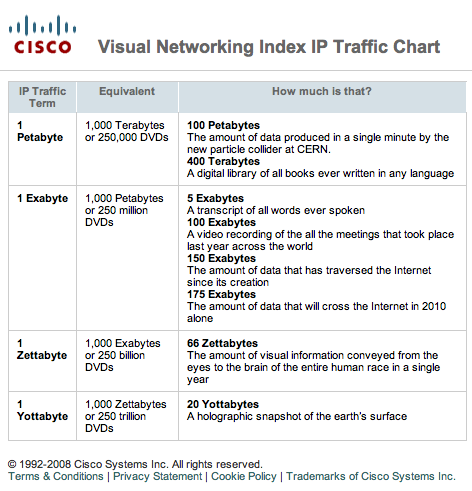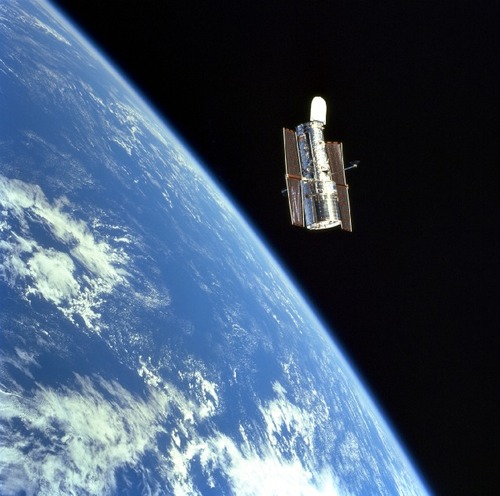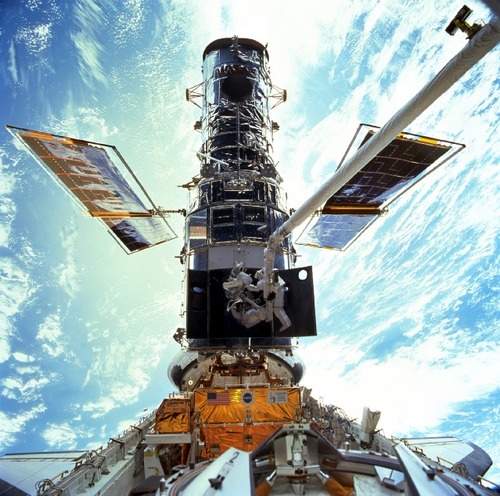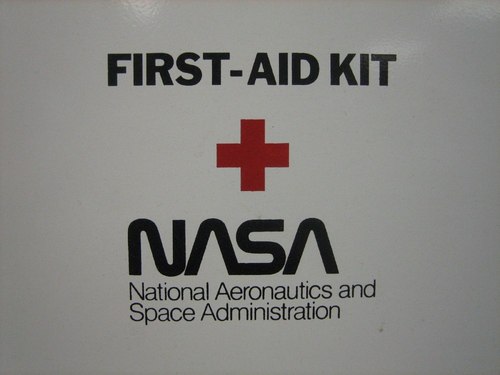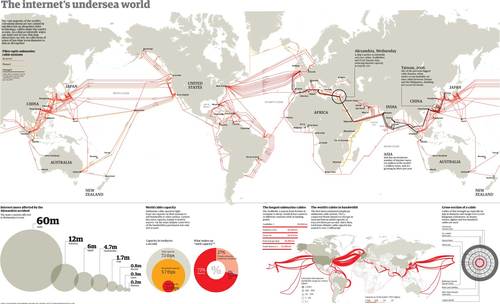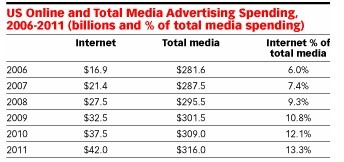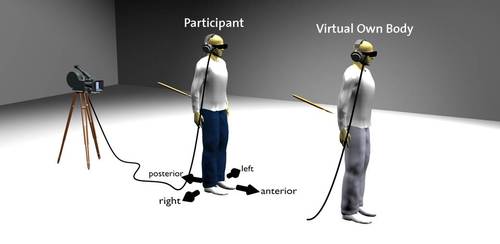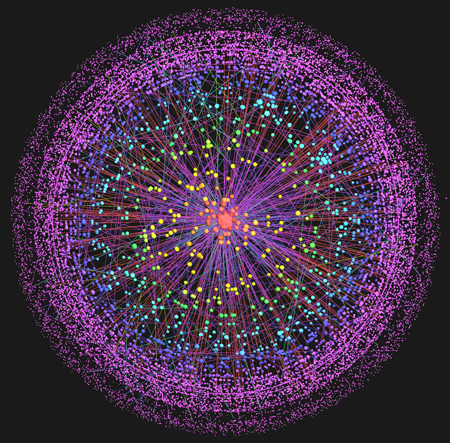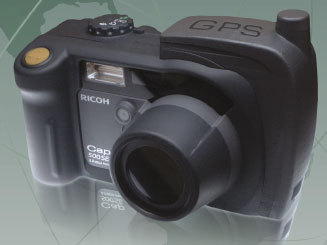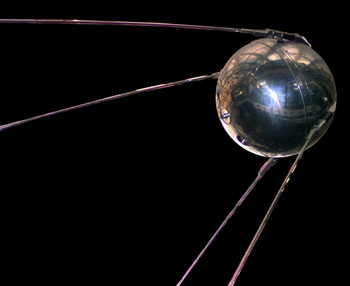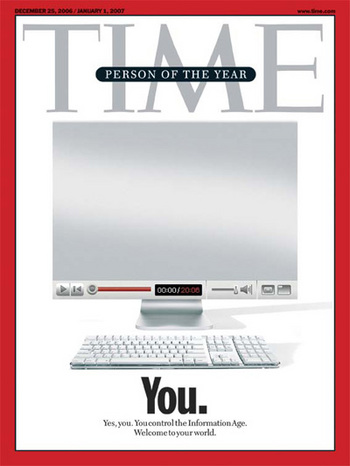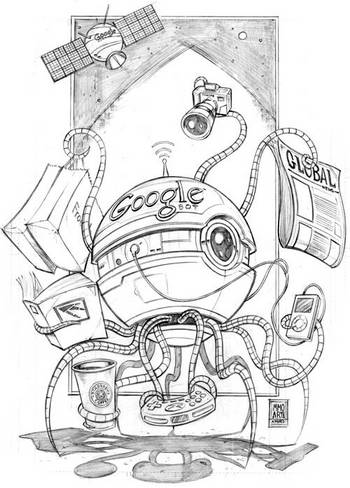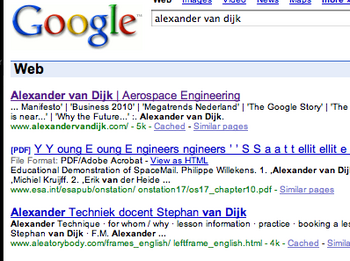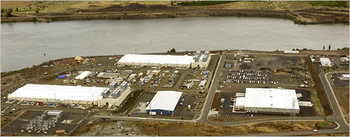This is the global brain archive | Back to Main
tobearchived after 6 years
Posted on Monday, September 17, 2012
After exactly 6 years (first post) its time to archive this blog. I've had a great time keeping a trail of my online journeys over these past 6 years and it served me well in my worldly travels, but its time for a new itinerary. I will keep the content up for the Google but I won't be posting here anymore. If you're interested in staying connected, follow me on Twitter @tobedetermined until I find a new home to share my current and future travels.
The medium of the self is the message
Posted on Saturday, May 14, 2011
Good video. Its the same folks that did this experiment back in 2007.
Part I
Part II
(via)
How has the Internet changed the way you think?
Posted on Monday, October 11, 2010
Ran into some excellent quotes in the responses to the yearly Edge.org question:
And he had picked up on McLuhan's idea that by inventing electric technology we had externalized our central nervous systems — that is, our minds — and that we now had to presume that "There's only one mind, the one we all share." John Brockman
The Internet is virtualizing the universe, which changes the way I act and think. "Virtualization" (a basic historical transition, like "industrialization") means that I spend more & more of my time acting-within and thinking about the mirror-reflection of some external system or institution in the (smooth, pond-like) surface of the Internet. But the continuum of the Cybersphere will emerge from today's bumpy cob-Web when Virtualization reaches the point at which the Internet develops its own emergent properties and systems: when we stop looking at the pixels (the many separate sites and services that make up the Web) and look at the picture. (It's the picture, not the pixels! Eventually top-down thinking will replace bottom-up engineering in the software world—which will entail roughly a 99.9% turnover in the current population of technologists.) David Gelernter
I began to develop a theme that has informed my endeavors ever since: New technologies beget new perceptions. Reality is a man-made process. Our images of our world and of ourselves are, in part, models resulting from our perceptions of the technologies we generate. John Brockman
Ned Hall once pointed out to me that the most critical inventions are not those that resemble inventions but those that appear innate and natural. Once you become aware of this kind of invention, it is as though you had always known about it. ("The medium is the message." Of course, I always knew that). John Brockman
The Internet is the infinite oscillation of our collective conscious interacting with itself. John Brockman
Maybe click-dreaming is a way for all of us to have the same dream, independent of what we click on. Kevin Kelly
We are midway between atoms and stars
Posted on Wednesday, August 4, 2010
Magical Bruce Sterling Keynote on Augmented Reality as Industry
Posted on Friday, August 21, 2009
His keynote at the official Layar Reality Browser launch in Amsterdam. Easily one of the best presentations of this year. Embedded below.
Go Kepler
Posted on Saturday, March 7, 2009
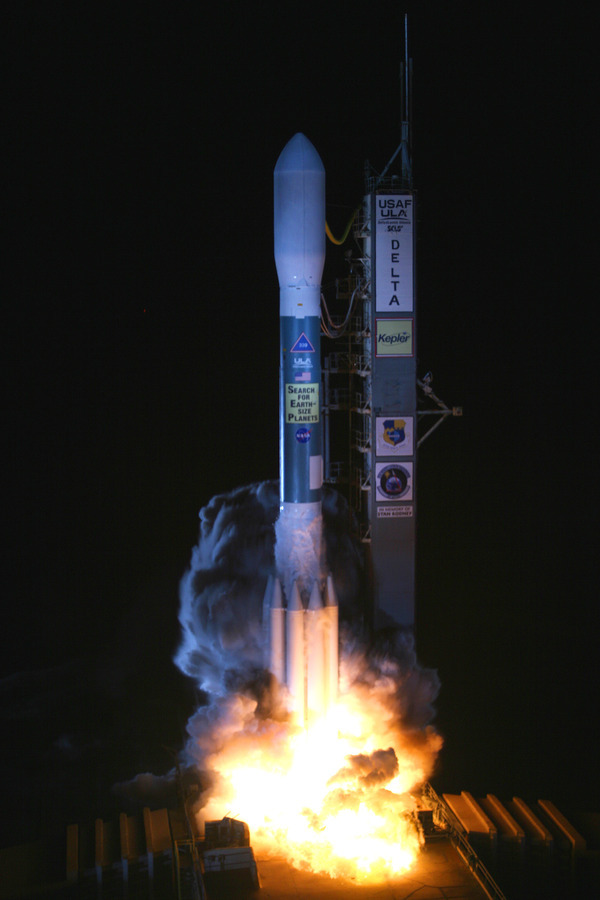
Apparently this is a real image. More at the spacecraft's twitter feed.
Eating Your Own Dogfood
Posted on Thursday, January 15, 2009

Its a question that has stuck with me for a while: how to get NASA to eat its own dogfood. (((and what would that actually mean in the context of a space agency?)))
(((btw, the 3 ((( thingie I stole from Bruce Sterling's Beyond the Beyond blog. Its like meta discussing your own blogpost...)))
There are different takes on this, and not having had the time to think things completely through sofar (and suspicious whether I'll have it in the near term), i'll just post some thoughts here and plan to come back to it at a later stage and possibly in a different shape and form. (((FYI, I find my twitter updates these days greatly outnumber the number of blogposts I manage to write and am happy about actually going live (there is an increasing number of unfinished blog posts in my movabletype blog webapp), so for all you ~50 readers of this blog, if you're really interested in my irregular updates and ramblings, why don't you take the red pill and subscribe to my twitter feeds on tobedetermined and NASA_Ames_Web because that's where you'll find an up-to-date and engaged research record of implementing the ideas that have been floating around on this blog since 2006, i.e. moving towards a merger of outer space and cyberspace...because make no mistake: its happening, and its happening right here, at NASA Ames Research Center.)))
Part I: eating your own dogfood is a term commonly used in the sofware business when employees of a company use their own tools and thereby create a feedback loop wherein the builders of tools also get to be the users of those same tools, leading to a much faster iterative usability loop and a very efficient way to speed up the evolution of a tool. From what I heard, Google even uses the term 'dogfood' for their internal products. In the case of NASA, one tool in case that would greatly benefit from people eating their own dogfood is its web publishing and communication tool, commonly known as The CMS.
Part II: Following a talk on synthetic biology a month or so ago at the Long Now series, I finally managed to get a tour of the labs here at Ames where scientists work on the future of space exploration. In particular, John Cumbers, Graduate student synthetic biology from Brown University, showed me and Delia Santiago around at his office and labs where he works on cultivating and studying organisms for potential application in space exploration (think: biological fuel generation, etc). The underlying objective here is that space exploration will not get anywhere if we stay stuck in the paradigm of carrying everything we need from the Earth. Launch costs are prohibitively expensive if we need to prepare for a trip by taking every bit of consumable with us upon embarking on the trip (((the Columbus metaphor comes to mind but I am going to skilfully navigate around this outdated metaphor))).
John is particularly interested in applying synthetic biology in realising Biological In Situ Resource Utilization (BISRU), something that has the potential to get us to places where we can build on our own consumables "off the land". One example he gave was testing it out on a comet 2 years away from Earth, with a 2 year return cycle. The labs here at Ames are fascinating, GATTACA comes to mind but in a different context.
The field of synthetic biology is still so new there are no good text books on the subject (((here's a good primer))). They do have conferences about it though.
Below are some images I made while following John around (more at Flickr). Most interesting, the book with the yellow dots is actually a real-life catalogue of genetic building blocks, called the 'Registry of Standard Biological Parts'. Whoever is building genetically engineered organisms can use a piece of pre-fab genetic code from this catalogue by dipping a pipet on the yellow spot, thereby subtracting some specific DNA sample. Its like LEGO, but the biological version of it. Welcome to the future...
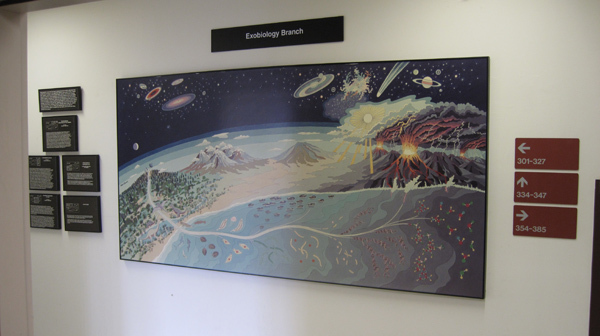

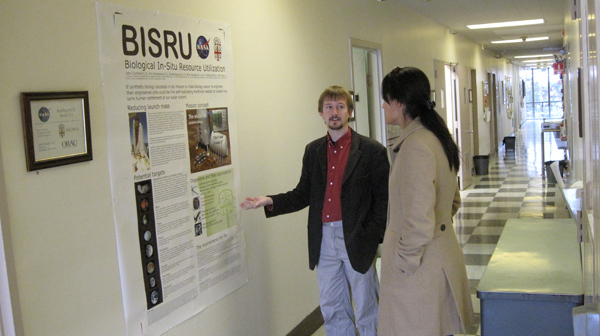
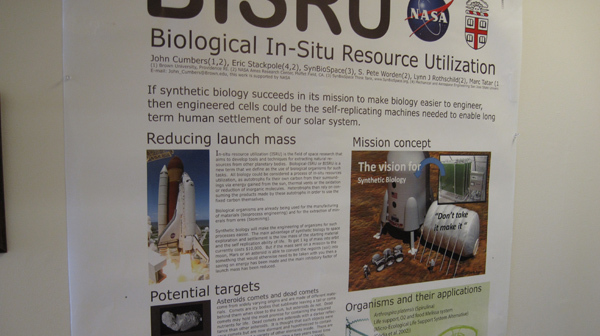
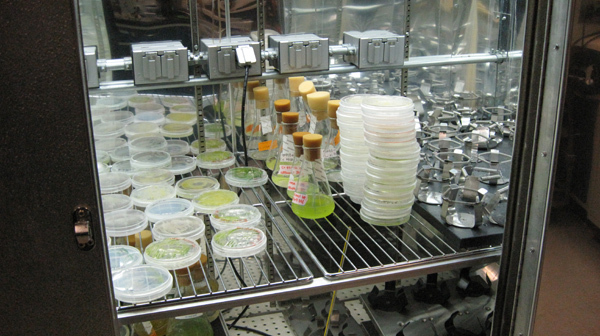

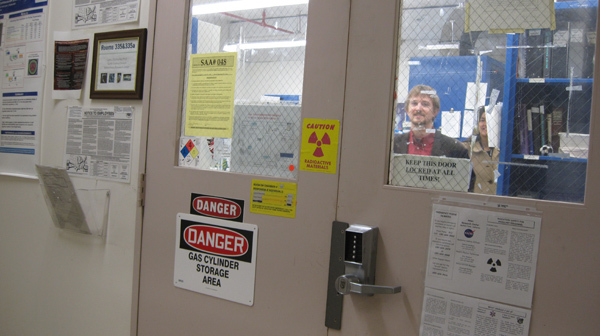
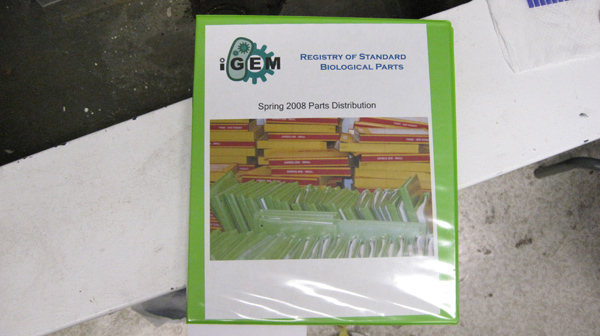
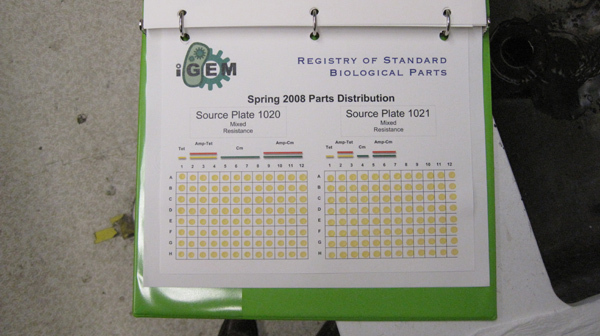
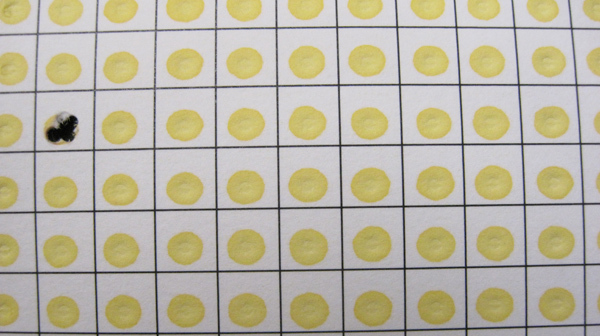
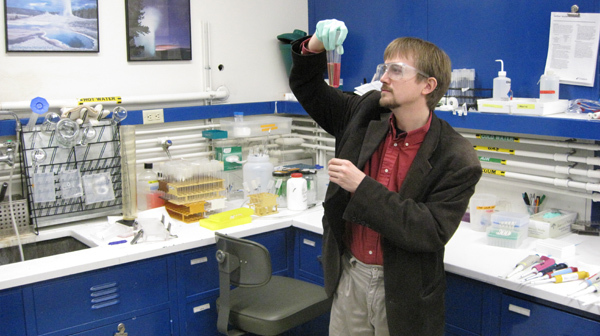

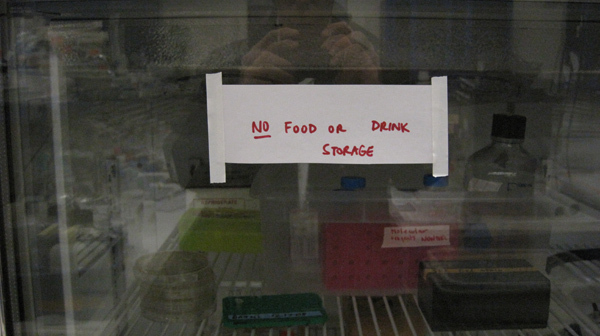
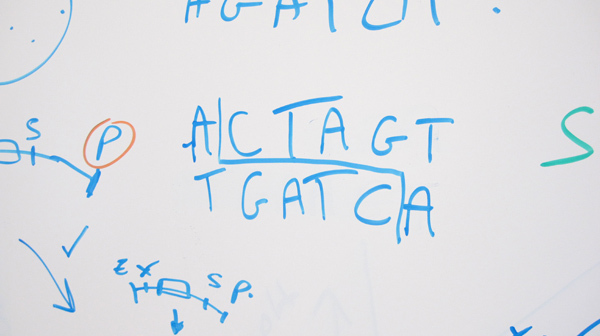
The Future of Human Spaceflight
Posted on Sunday, December 28, 2008
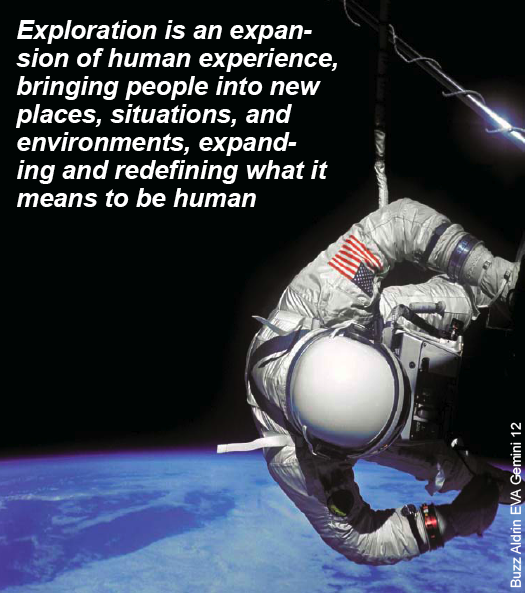
Screendump from report
The title of a white paper recently issued by the 'Space, Policy, and Society Research Group' based at MIT. Some quotes from this (worth reading) 15-page report:
This report addresses the future of human spaceflight, that is physically placing humans in space and on other planetary bodies.
A primary objective of human spaceflight has been, and should be, exploration. Exploration, of course, is a keyword in the Bush vision and in NASA’s own terminology. Yet while the word is often used, it is rarely specified beyond lofty rhetoric and allusions to curiosity and frontiers. What is exploration, and why explore?
First, it is worth considering what exploration is not. Some argue that “exploration is in our DNA,” that some fundamental, even genetic, human trait compels us as individuals and as nations to seek out new territory. The civilization that fails to expand geographically, the argument goes, will enter a state of permanent decline, always to be exceeded by other nations with more compelling wanderlust. We reject these arguments about essential qualities of human nature. No historical evidence, no social science evidence, and no genetic evidence prove that human beings have an innate, universal compulsion to explore. In fact, space exploration is radically different from the kinds of geographical expansion that have marked human history because of its high degree of technical difficulty, the environments’ extreme hostility to human life, and the total lack of encounters with other human cultures.
We define exploration as an expansion of the realm of human experience, bringing people into new places, situations, and environments, expanding and redefining what it means to be human.
Space continues to attract broad public interest, although it must compete for attention in an increasingly diverse, overheated, and unstable media environment. Young Americans increasingly see remote and virtual presence as equivalent to physical presence and may not accept older arguments about the importance of “being there.” Exploration in other realms, notably the deep ocean, faces a similar set of questions as engineers, scientists, and policy makers debate the appropriate mix of human and remote presence in our digital world.
Some Numbers from Michael T Jones' talk at AGU '08
Posted on Sunday, December 28, 2008
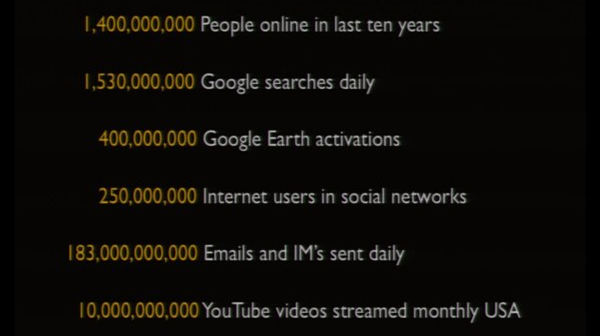
75 sweet minutes of Michael T Jones (Chief Technology Advocate @ Google) at the AGU earlier this month.
Another Peak Into the Future
Posted on Tuesday, December 9, 2008
Some of the sensors I blogged about in this post will likely come out of the Small Spacecraft Division here at Ames. (Click on the bottom image for a full-res closeup)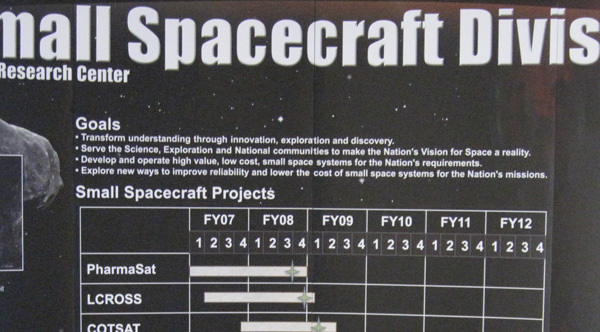
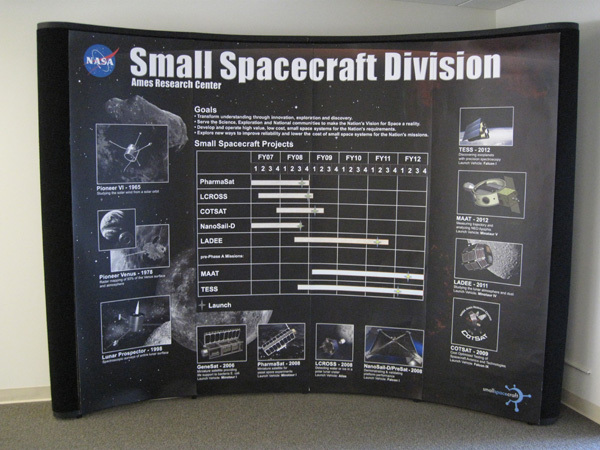
Click for full res version
Coming Soon to a Parking Lot Near You
Posted on Friday, December 5, 2008
Quite a hilarious video from Microsoft, embedded below.(via)
Web Meets Out-Of-This-World
Posted on Thursday, December 4, 2008
2 days ago I watched another two 30min. videos from last month's Web2.0 Summit 'Web Meets World'. One an interview with Al Gore, the other one an interview with Michael Pollan. Given this year's theme 'Web Meets World', both interviews revolved around discussions on how best practices and business models from the web and software world could be applied to re-invent and/or re-invigorate other industries 'in the real world': the outdated energy industry in Al's talk, the dysfunctional food industry in Michael's talk.
Reading a book on the Django Web Application Framework last night, I realised this question just as much applies to the space industry. Its something I remember Pete Worden (our current NASA Ames Center Director) being pretty vocal about back in 2006. Teaching at the ISU Summer Session in Strasbourg, he made a strong case for the need for standards to facilitate innovation in the space industry. Standards for the data coming back from space, standards for the telecommunication protocols used in space, standards in launch and operational systems. And since he's been here at NASA Ames, he spearheaded an initiative to implement that kind of modular thinking in the actual physical design of a spacecraft, the Modular Common Spacecraft Bus (image above). Its an ubergizmo-worthy system design that can be used both for orbiter missions as well as for lander missions and that was recently selected by Odyssey Moon as their preferred platform to take a shot at the Google Lunar X-Prize.
I can see down the road a satellite gathering data somewhere in the Solar System is conceptually not that different from say a network of smartphones tied into a sensor network, or a webcam streaming images live on the web. Read for example what the Google Lunar X prize has in its competition guidelines in order to win the Grand Prize:
MOONCAST: The Mooncast consists of digital data that must be collected and transmitted to the Earth composed of the following:
High resolution 360º panoramic photographs taken on the surface of the Moon;
Self portraits of the rover taken on the surface of the Moon;
Near-real time videos showing the craft’s journey along the lunar surface;
High Definition (HD) video;
Transmission of a cached set of data, loaded on the craft before launch (e.g. first email from the Moon).
Teams will be required to send a Mooncast detailing their arrival on the lunar surface, and a second Mooncast that provides imagery and video of their journey roaming the lunar surface. All told, the Mooncasts will represent approximately a Gigabyte of stunning content returned to the Earth.
In the end, its all the same. Input devices (in this case: satellites) feed into the web, the web as platform extracts (collective) intelligence out of this data (if you're lucky), the network delivers the data/media to its users/consumers, and voila: Web Meets Out-Of-This-World. Its already happening (yes, it is). Or as one of my favorite quotes from William Gibson goes:
The Future is here, its just not evenly distributed yet.
We’ve built this spaceship...
Posted on Tuesday, December 2, 2008
...but we really don’t know where it will take us.” The last sentence in this indepth NYT article on Google and privacy concerns.
Sign Of The Times
Posted on Monday, December 1, 2008
Chang'e 1 Lunar Map Released. What a great image! Especially with those Chinese characters above it (the 5th character from the left is the character for the moon according to my American colleague who was born in China). They have even gone through great length to appropriate all large craters with Chinese characters. Click on the image for a high res version (via).
Participatory Impacting the Moon
Posted on Sunday, November 23, 2008
A probe released from Chandryaan-1 impacted the moon last week (more & images). A nice dress rehearsal for the LCROSS mission which is looking for lunar impact next year (LCROSS is developed here at NASA Ames). Didn't see any realtime coverage though. No live spacecraft images coming online as it is heading towards impact...so there is still the 'innovative/surprise factor' up for grabs for LCROSS. Like @MarsPhoenix grabbed it for the twitter platform.
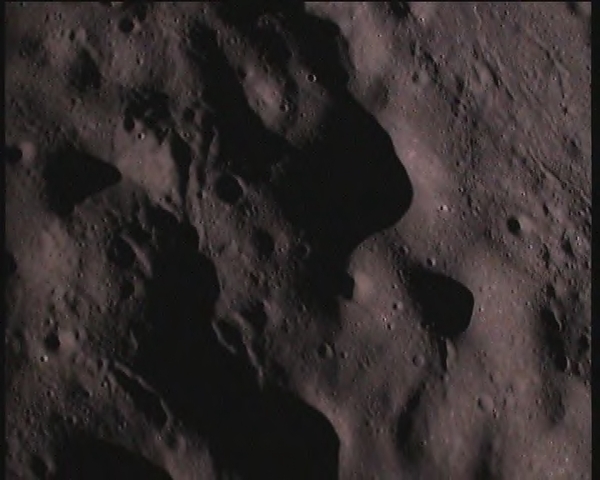
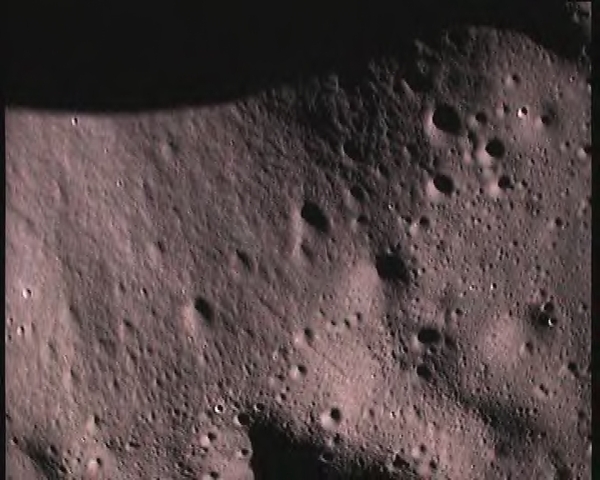
DinnerTV: Web 2.0 Summit 08 Videos
Posted on Tuesday, November 18, 2008
A great way to loose time (and an even better reason to loose my comcast cable subscription). All episodes. One of my favorites (on the cloud) is embedded below. And this article sums up the overall feel pretty well. Enjoy, its addictive...
A Google For Government
Posted on Friday, November 14, 2008
A Google for Government? Ha! Why not a Google for Galaxy?
Dinner TV: Where Games and SETI Collide
Posted on Wednesday, November 12, 2008
As a follow up to the previous post, I just found this informal dinner talk between Will Wright and Jill Tarter organised by SEED. Its embedded below, from the looks of it in the code served to you from the servers of Amazon's Web Service...![]()
The Web as Platform...for the Exploration of Outer Space
Posted on Monday, November 3, 2008
Can't wait to see NASA increase government's piece of the cake here (more on the pie chart at O'Reilly Radar and the originating post entitled '1,000 Web API's' over at ProgrammableWeb). I mean, if the New York Times is able to open up their platform (see for example their Open NYT blog and their developer site), shouldn't NASA be able to do the same? There is already a lot of NASA data out there on the web, but its scattered over as many different websites. Bringing everything under one easy-to-use platform (think: developer platforms from the likes of Google, Yahoo, Microsoft, Amazon etc.) would be a great achievement. And it would make perfect sense, given the nature and the amount of data NASA gathers through its sensors (images, videos, temperature readings, what have you...media equals data equals media these days right?). NASA as a service oriented agency providing the sensors and the resulting platform of data for scientists and anybody with an Internet connection to tap into for scientific research and participatory exploration (earlier post). I can't start to think what types of innovation would result from that. The ease of availability of data (for machines) being one of the biggest 'competitive' advantages in the web3.0 [sic] years ahead. Reminds me of a hack on an image I made back in the days of my thesis embedded below. 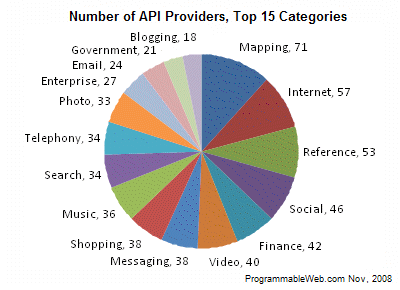
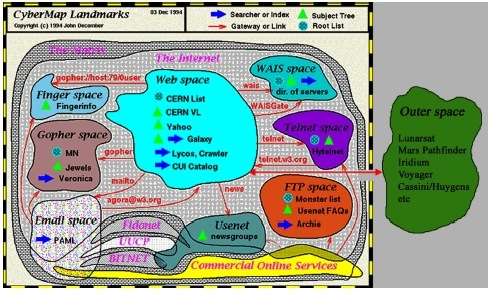
First Images of the Earth from Chyandrayaan-1
Posted on Monday, November 3, 2008
And quite exquisite ones as well (see earlier post). Click the images for full res. More from the Indian Space Research Organisation (ISRO) at this Press Release from last friday 31st October 2008. More on Chyandrayaan-1 at its own website. (all links via)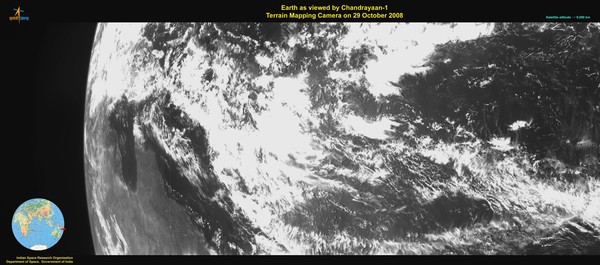
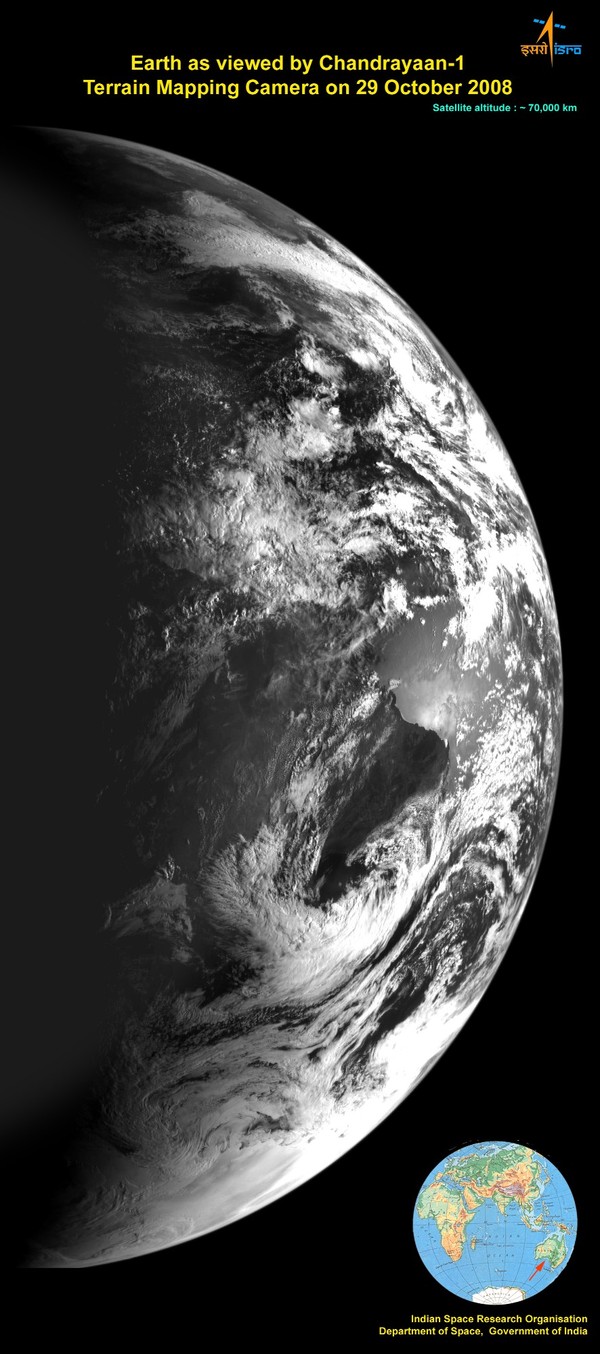
Building The Interface To the Planetary Sensor Web
Posted on Thursday, October 16, 2008
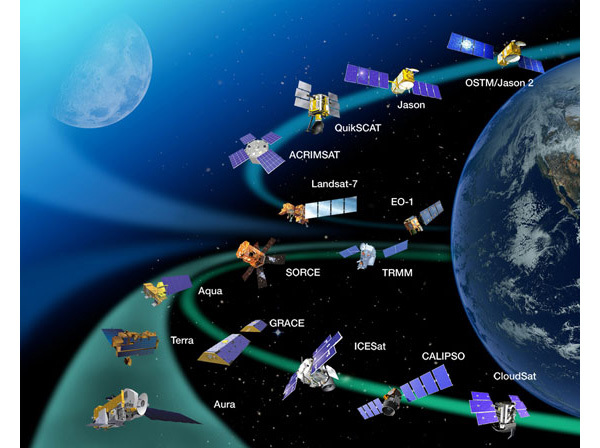
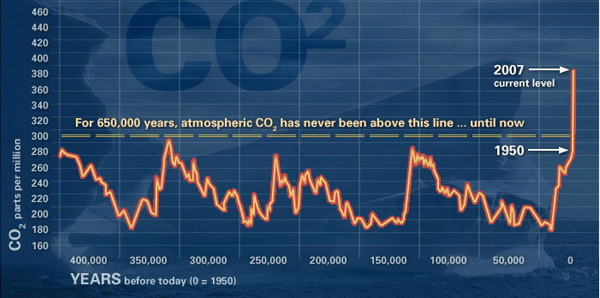
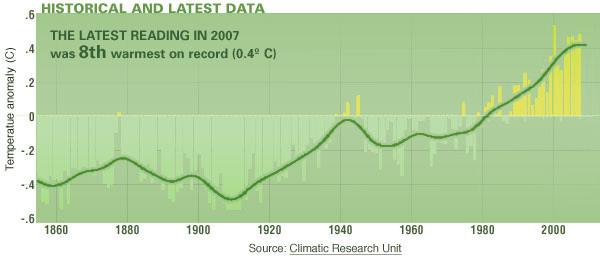
JPL launched it newly designed website today, including a dedicated site on global climate change with the telling subtitle 'NASA's Eyes on the Earth' (CNN has more). In these times of endless stock exchange graphs, stats and scares, its great to see a similar data vis design pattern emerge with the early steps towards a planetary sensor web user interface (if only we could swap the trend in above graphs with the NYSE). Sofar it seems satellite data is not really fed real-time (at least not in an all encompassing & comprehensive way) but I'm sure we'll get there, including open API's for everyone to leverage the sea of space based sensor data about the state of our planet (and beyond). On a related note, O'Reilly just released a Radar report on Where2.0 with a great introduction by Tim O'Reilly.
Some Great Videos From Michael Wesch
Posted on Sunday, October 12, 2008
Of 'The Machine is Us/ing Us' fame. Video 1. Video 2 (both embedded below). More of his interesting research at mediatedcultures.net. (via this excellent blog)
Nova Spivack Talks about Role of Media in Future Global Brain
Posted on Friday, October 10, 2008
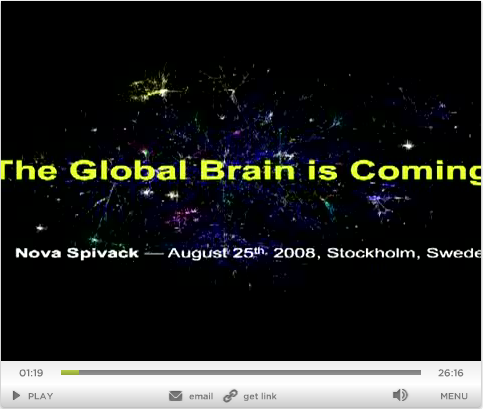
In reference to my previous post, this is what I call an INSPIRING start of a 3-day weekend ;-). Nova basically calls it my favorite talk out of all the talks I have given (more videos from GRID08). I hope whoever gets to decide on where to spend the money for SEC. 407 408 of the NASA Authorization Act 2008 takes the time to listen to his insights:
SEC. 407. PARTICIPATORY EXPLORATION.(a) In General- The Administrator shall develop a technology plan to enable dissemination of information to the public to allow the public to experience missions to the Moon, Mars, or other bodies within our solar system by leveraging advanced exploration technologies. The plan shall identify opportunities to leverage technologies in NASA's Constellation systems that deliver a rich, multi-media experience to the public, and that facilitate participation by the public, the private sector, and international partners. Technologies for collecting high-definition video, 3-dimensional images, and scientific data, along with the means to rapidly deliver this content through extended high bandwidth communications networks shall be considered as part of this plan. It shall include a review of high bandwidth radio and laser communications, high-definition video, stereo imagery, 3-dimensional scene cameras, and Internet routers in space, from orbit, and on the lunar surface. The plan shall also consider secondary cargo capability for technology validation and science mission opportunities. In addition, the plan shall identify opportunities to develop and demonstrate these technologies on the International Space Station and robotic missions to the Moon.
(b) Report- Not later than 270 days after the date of enactment of this Act, the Administrator shall submit the plan to the Committee on Science and Technology of the House of Representatives and the Committee on Commerce, Science, and Transportation of the Senate.
A Sobering Presentation from the Valley At The Start Of A 3-day Weekend
Posted on Friday, October 10, 2008
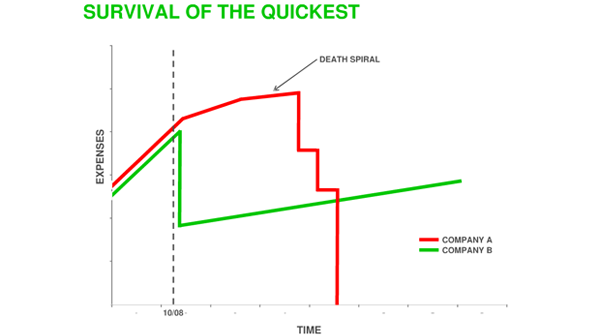
A presentation by Sequoia Venture Capital on how to survive the times ahead.
Software, The Final Endless Frontier
Posted on Tuesday, October 7, 2008
From a post by Vint Cerf in the series on Google's 10th anniversary:
A box of washing machine soap will become part of a service as Internet-enabled washing machines are managed by Web-based services that can configure and activate your washing machine. Scientific measurements and experimental results will be blogged and automatically entered into common data archives to facilitate the distribution, sharing and reproduction of experimental results. One might even imagine that scientific instruments could generate their own data blogs.I wonder when small sats finally turn into soap boxes. Vint continues:
These are but a few examples of the way in which the Internet will continue to surround and serve us in the future. The flexibility we have seen in the Internet is a consequence of one simple observation: the Internet is essentially a software artifact. As we have learned in the past several decades, software is an endless frontier. There is no limit to what can be programmed. If we can imagine it, there's a good chance it can be programmed. The Internet of the future will be suffused with software, information, data archives, and populated with devices, appliances, and people who are interacting with and through this rich fabric.Read the whole post here.
Nicolas Carr at The Colbert Report
Posted on Thursday, October 2, 2008
Besides the book, the interview refers to an article Carr wrote in the Atlantic entitled: "Is Google making us stupid" (via). I don't know about that, but Steve's mockery of continuous partial attention is something I see here a lot. Everybody is constantly checking their email and IM's on their iPhones: in meetings, at seminars, during lunch... The full Colbert episode is also available at Hulu but its US only, and the video expires in a week or 2.
Google's TechTalks Inspire NASA Ames
Posted on Sunday, September 28, 2008
Chris McKay (Planetary Scientist @ NASA Ames), Khalid Al Ali (Director of Research at Carnegie Mellon University (CMU) West), and Michael Sims (Research Scientist @ NASA Ames) came together in the NASA Ames Exploration Center last wednesday to talk about the latest developments in robotic surface exploration. Fascinating talk and photos. From what I hear, an audio(?) recording is forthcoming. I hope we get to see more of these talks down the road (and hopefully also the videos integral on the web, in the same spirit as the above mentioned TechTalks).
10 Bucks Well Spend
Posted on Wednesday, September 24, 2008
Following on from yesterday's syndication of Tim O'Reilly's keynote at the NY Web2.0, I just finished watching the documentary he has been pointing out on several of his keynotes: A Crude Awakening: The Oil Crash. Buy it on itunes from their website and have a peak into the future of post cheap oil society. Quite informative...
Tim O'Reilly's Call to Action
Posted on Tuesday, September 23, 2008
And it ain't throwing sheeps. From last week's Web 2.0 Expo in New York entitled "Web Meets World".
(via)
Your 47 Minutes of Zen
Posted on Wednesday, September 17, 2008
A video from Nova Spivack's panel at DEMO Fall '08 on the Future of the Web, among which former Division Chief of Computational Sciences at NASA Ames (and now head of Research at Google) Peter Norvig (older & excellent mp3 interview with Norvig). All good stuff!
(via)
Yahoo Hackday 2008 (today's pitstop #3)
Posted on Saturday, September 13, 2008
My First Yahoo Hackday. Not much hacking myself, mainly getting a glimpse of Yahoo hackculture at this stage, but Ames was well represented by NASA's Planetary Content hackers Matt Hancher (left) and collegue.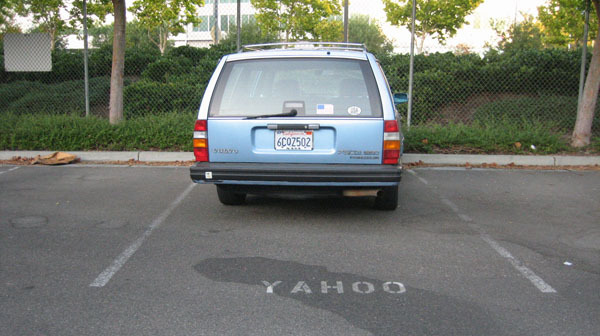
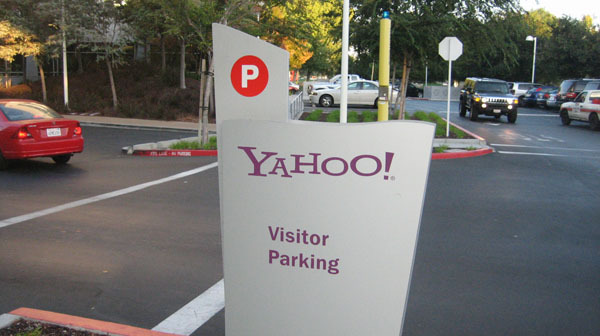
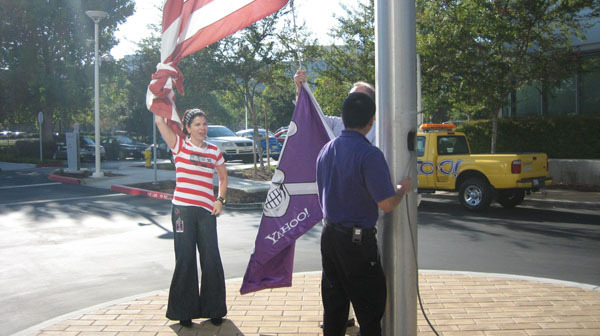

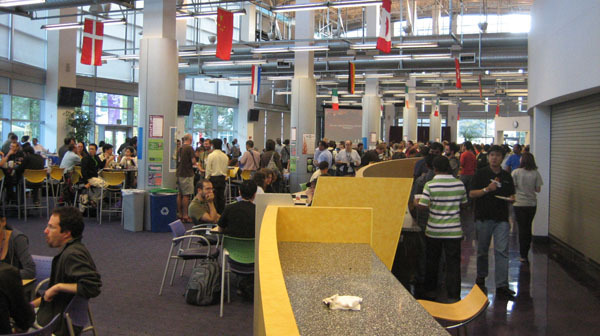
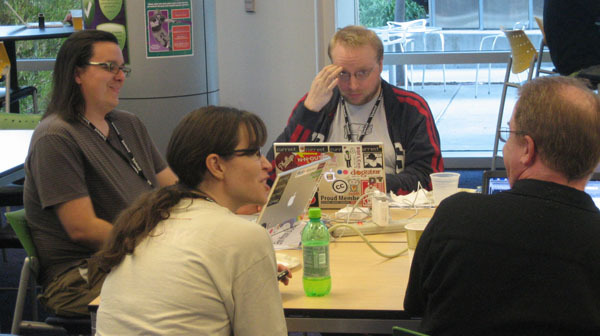
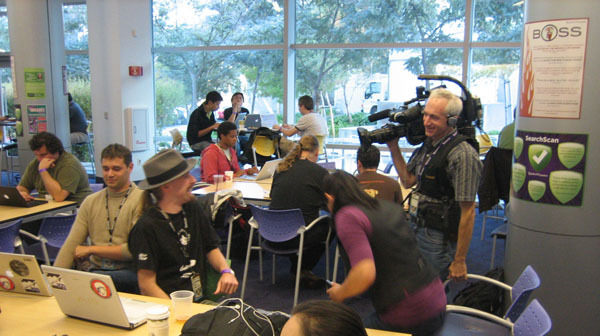
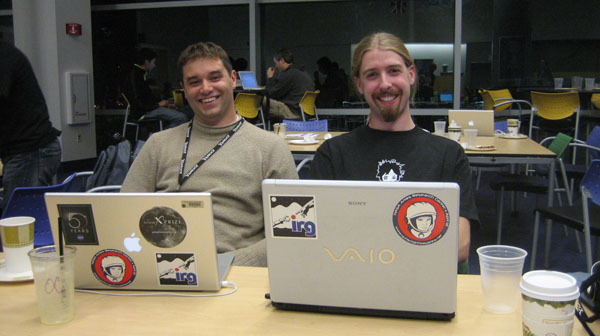
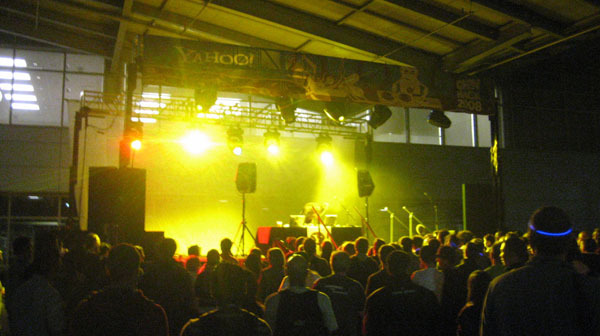
tobedetermined.org Extended Credo
Posted on Monday, September 1, 2008
Update: A post over at O'Reilly Radar by Nat Torkington reminds me of another quote I've used in the earlier days of this blog. It's a (famous) quote from William Gibson: The future is here, its just not evenly distributed yet. In his post, Nat refers to another quote from Gibson that brings the overarching point home:
One of the things our grandchildren will find quaintest about us is that we distinguish the digital from the real, the virtual from the real. In the future, that will become literally impossible. The distinction between cyberspace and that which isn't cyberspace is going to be unimaginable. When I wrote Neuromancer in 1984, cyberspace already existed for some people, but they didn't spend all their time there. So cyberspace was there, and we were here. Now cyberspace is here for a lot of us, and there has become any state of relative nonconnectivity. There is where they don't have Wi-Fi.
Having a 3-day weekend does have its benefits (like in: having an extra evening behind your computer?). Think I just stumbled upon something like an extended credo for this blog (beyond tobedetermined.org: A blog about outer space, cyberspace, their common future and all that is leading up to it... ). I started gathering some quotes that resonated with me over the years and ended up with this list (read from top to bottom, in that order):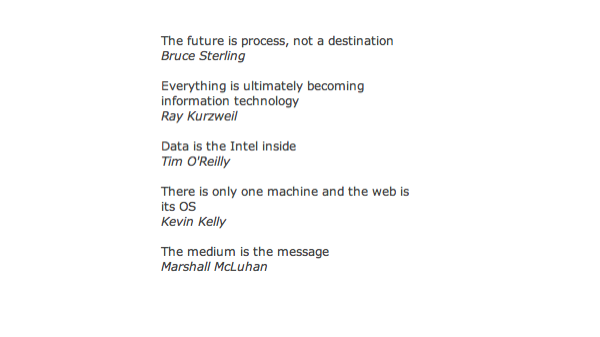
I am sure there are more out there that would fit this list, so if you have any suggestions pls let me know.
ESA runs a webcam...around Mars
Posted on Sunday, August 31, 2008
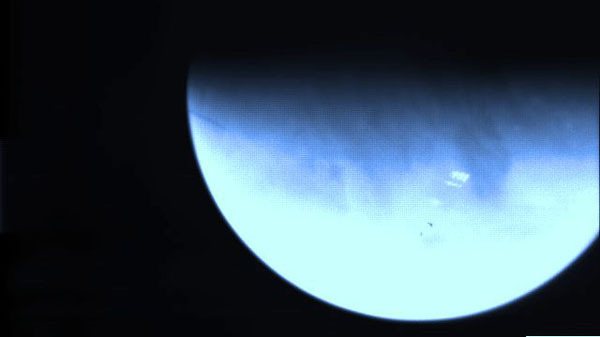
And they invite the public to participate in processing the images. See for more @ ESA's VMC website. Nice job by VMC team coordinator Thomas Ormston, Mars Express Spacecraft Operations Engineer.
Wow!
Posted on Thursday, August 28, 2008
Ubiquity for Firefox from Aza Raskin on Vimeo. More at Mozilla Labs (via).
Trading Routes 2.0
Posted on Thursday, August 28, 2008
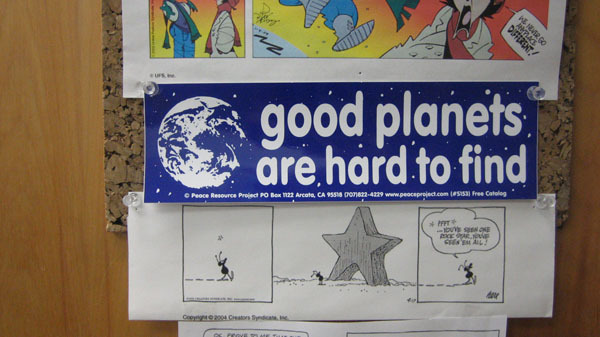
Haven't been very active with blogging recently. Partially this is due to my other backchannel recently opened on twitter where I every now and then post URLs I would otherwise probably post here (even more are at my del.icio.us or my FriendFeed). Anyway, life at NASA Ames continues at an ever speeding pace, moving ahead with our mission to properly weave space into the fabric of our digital "global brain". One link that stayed with me over the weekend is this GigaOM article talking about how new cables carrying internet traffic are indicators of future economic activity (how is that for a comparison to the stale 'Columbus' metaphor to space exploration):
This leads me to my conclusion: Building new cables is the equivalent to adding new roads, new shipping lanes, or flights. The undersea fibers of today are what sea trading routes were in the past—an indicator of future economic activity and a subsequent boom.
Welcome, Interplanetary Internet. Oh, and the image above? Well, there is a planet-finding mission called Kepler of which the Science Operations Center will be based here at Ames. This was on the door of their Deputy Principal Investigator David Koch.
On Rocks and Clouds
Posted on Thursday, August 21, 2008
Chris Kemp kicked of Code I (IT Directorate) here at Ames. This is going to be good!
Posted on Wednesday, August 13, 2008
In other news:
- A good interview with Jeff Stibel on the 'perceived' parallels between the Internet and the brain
- Cyber attacks preceeded bombs in Georgia. Which makes me want to go back to a commercial I saw one of the first weeks I arrived in the US: Airforce: Air : Space : Cyberspace. This completely brings home the topic of this blog. Moving up from Air into Space and beyond, you enter...Cyberspace. If you want a challenge: be a cyber warrior.
- Google Maps didn't have any info on Georgia (I noticed that myself as well, and wondered what was up). Now Google is saying they just didn't have data there.
- Is Google a media company? Many seem to think so, including Tom Foremski:
For the past four years I've been saying that Google, Yahoo and many other large Internet companies such as AOL, and eBay are media companies. They publish pages of content with advertising around it.The fact of owning or not owning the content is a red herring. Either way, Google publishes pages of content with advertising around it. How is that not a media company?
GOOG is not a technology company. What technology can you buy from Google? I can buy a database from Oracle--that's a technology company. I can buy microprocessors from Intel--that's a technology company. What technology can you buy from Google?
Google is a technology-enabled media company. It won't create its own content. It mostly scrapes its content from the Internet, or collects it from users of Youtube, etc, and sells advertising around it. How it gets its content is not important, it is still a media company.
Summer 2008
Posted on Friday, August 1, 2008
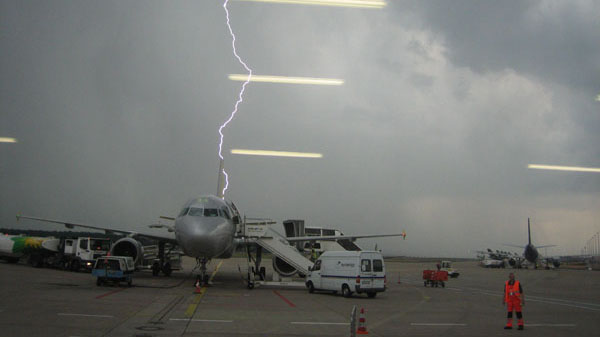
Back from a week of Internetless holiday on the island of Korcula (above photo was at Koln airport just before we were told we could board the plane ;-). Catching up here are a few relevant tidbits:
- The Economist's commentary on NASA's 50th anniversary provides a sharp dissection of NASA's past, present and future. Its the most sensible story on space and NASA I've read in a long while. As always, the comments are worth reading too, if only to see how space proponents bring their arguments into gear to downplay the article's 'hammer on the nail' analysis
- Sanfran article of the week about twitter, relationships, and the bay area working spirit
- Missed OSCON, but here's a 37min intro and Tim Oreilly's comments
- A great discovery: this TED video by kevin kelly. I especially like his McLuhan Reversal analogy. Have to watch it again.
S3 Outage Effects
Posted on Tuesday, July 22, 2008
Interesting. S3 goes out, and suddenly all over the web you'll see images disappearing, avatars evaporating and webshops go down.
Btw,for those who have the time to follow twitter feeds, and/or(?) are interested how we are gonna re-vamp NASA Ames' presence on the web (starting with the Ames page in the nasa.gov portal) we just added a new fly on the wall.
The Stone Age Didn't End Because of a Shortage of Stones
Posted on Sunday, July 20, 2008
Bruce Sterling comments inline on this passionate call by Al Gore for the US to become carbon fuel independent in 10 years.
Time to put some solar panels on my roof here in Palo Alto. Or wait, wasn't I first gonna spend 2 weeks flying around Europe for my holiday, buy the iPhone and upgrade my car (from what I hear SUV's come cheap these days).
Could this be the "Moonrace" of the 21st century?
We need you. And we need you now. We're committed to changing not just light bulbs, but laws. And laws will only change with leadership. On July 16, 1969, the United States of America was finally ready to meet President Kennedy's challenge of landing Americans on the moon. I will never forget standing beside my father a few miles from the launch site, waiting for the giant Saturn 5 rocket to lift Apollo 11 into the sky. I was a young man, 21 years old, who had graduated from college a month before and was enlisting in the United States Army three weeks later.I will never forget the inspiration of those minutes. The power and the vibration of the giant rocket's engines shook my entire body. As I watched the rocket rise, slowly at first and then with great speed, the sound was deafening. We craned our necks to follow its path until we were looking straight up into the air. And then four days later, I watched along with hundreds of millions of others around the world as Neil Armstrong took one small step to the surface of the moon and changed the history of the human race.
We must now lift our nation to reach another goal that will change history. Our entire civilization depends upon us now embarking on a new journey of exploration and discovery. Our success depends on our willingness as a people to undertake this journey and to complete it within 10 years. Once again, we have an opportunity to take a giant leap for humankind.
Edge 250
Posted on Thursday, July 17, 2008
Alan Turing's suggestion, to build a disorganized machine with the curiosity of a child, made more sense. Eventually, "interference would no longer be necessary, and the machine would have ‘grown up’." This was Google's approach. Harvest all the data in the world, rendering all available answers accessible to all possible questions, and then reinforce the meaningful associations while letting the meaningless ones die out. Since, by diagonal argument in the scale of possible infinities, there will always be more questions than answers, it is better to start by collecting the answers, and then find the questions, rather than the other way around.And why trace the connections in the brain of one individual when you can trace the connections in the mind of the entire species at once? Are we searching Google, or is Google searching us?
More at 'Engineer's Dreams' by George Dyson (Edge 250)
Yup
Posted on Thursday, July 17, 2008
Wading through +2k unread posts in my list of RSS feeds (Bruce Sterling's Beyond the Beyond).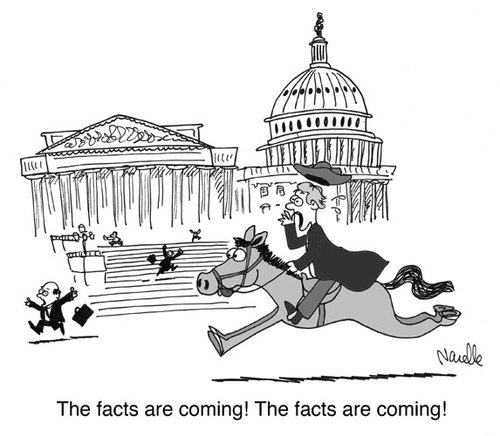
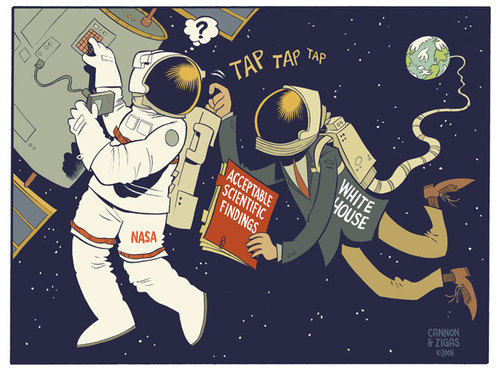
Its You They're After
Posted on Saturday, July 12, 2008
The best analysis on Google's Lively I've read sofar comes from RealityPrime: Its not so much about giving people a nice virtual world to play with, its providing a new interface to harvest new and previously untapped user behaviour. Which reminds me of an excellent article I was send the other day on the near future of advertising, a must-read.
Robots Get Better Every Day
Posted on Wednesday, July 9, 2008
A couple of quotes from an article in the Washington Post entitled 'U.S. Finds It's Getting Crowded Out There' (via):
The cost of manned space exploration, which requires expensive measures to sustain and protect astronauts in the cold emptiness of space, is a particular target."The manned space program served a purpose during the Apollo times, but it just doesn't anymore," says Robert Parks, a University of Maryland physics professor who writes about NASA and space. The reason: "Human beings haven't changed much in 160,000 years," he said, "but robots get better by the day."
Another one:
In its assessment, Futron listed the most significant U.S. space weakness as "limited public interest in space activity."
Hmm, it looks like us humans are a real show stopper when it comes to pushing the borders of reality further into outer space. Perhaps we should consider targeting robots instead of humans with the US civil space PR machine. Once they are on equal par with us, they'll probably be much more enthused and equipped to go into outer space. And after all, our race already had its 15 minutes of fame wouldn't u say? An add campaign targeted at robots...hmm...: "Space, The Final Webservice"
The One Computer
Posted on Friday, June 27, 2008
Kevin Kelly re-iterates his earlier thoughts (a must-read) in the latest edition of Wired (via). Still makes sense to me. And guess who's heading all of this?
What Union Square Ventures Likes To Invest In
Posted on Thursday, June 26, 2008
'Merging of cyberspace and real space' (amongst others). Below slide is taken from the same Techcrunch post. Nice signal overshoot.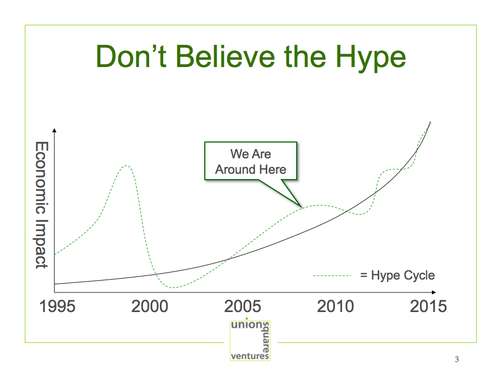
24/7 Data Center Breathing
Posted on Sunday, June 22, 2008
From On Clouds, the Sun and the Moon:
Follow the Moon: And with so much focus on energy costs, data center power consumption and cooling (not to mention the environment), there’s also a cloud computing approach known as Follow the Moon. It posits that a cloud provider with physical data centers in several different geographical locations can run the applications that are active from the day side of the world in centers on the night side of the world, taking advantage of lower power and cooling costs.
Martian Skies
Posted on Saturday, June 21, 2008
Nicolar Carr points to a photoblog with a post of great photos from Mars. Worth your precious Internet time I promise.
As we come to rely on computers to mediate our understanding of the world...
Posted on Wednesday, June 11, 2008
Nicolar Carr looks ahead. Searchblog responds. I definitely like Nicolas' point of view. Whereas the conservatism standpoint never seems to win, he makes a good point about the influential nature of media beyond what they carry (the medium is the message, or first we shape the tools, then the tools shape us). The deep reading he talks about seems on the web more to revolve around 'deep experience'. For example my first encounters with Google Earth definitely carried some element of 'deep experience' that would not have been possible weren't it for the Internet. I'm sure there's more on the way where that came from.
Phoenix Twitters
Posted on Monday, June 2, 2008
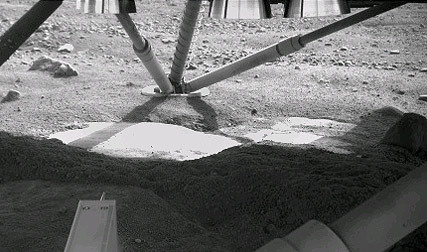
NASA Watch gives us the twitter of all twitters: MarsPhoenix. From an interview in Wired:
...can imagine a future academic writing the clause, "identity creation through character limitation," but the personal touch, even if borne of necessity, caught on with the Twitter community.
Writing from the first person turned out to be mainly a solution to the 140 character limitation on twitter. Nice how evolutionary solutions play into the impersonification of spacecraft.
World Wide Telescope Released
Posted on Thursday, May 15, 2008
Yep, its here (given the page design you'd mistake it for a Mac site just for a second). Ever since I upgraded to Mac OSX 10.5 (aka Leopard) last week my Parallels XP virtual machine is in a permanent state of reboot so I haven't had a personal interaction with WWT yet, but from the reviews of it over at OgleEarth and The Earth Is Square, it seems to be a pretty nifty application.
Can't wait to get my NASA Macbook Pro exchanged for a proper PC...
The Geoweb Is Evolving
Posted on Wednesday, May 14, 2008
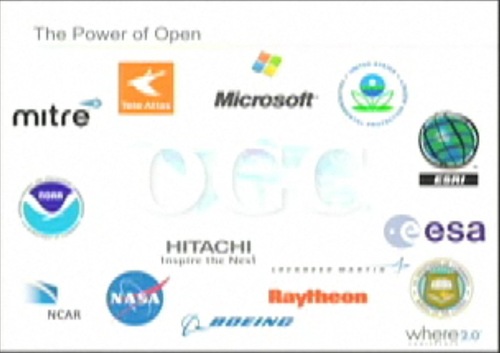
Straight from Burlingame at the Where2.0 conference, John Hanke and Jack Dangermond talk about Google and ESRI working together. Note that there's two space agencies in above image (considering NOAA is not) and a couple of NASA contractors.
Some views to enjoy (until I get back to posting regularly)
Posted on Tuesday, May 6, 2008
web2.0 Expo day 2
Posted on Thursday, April 24, 2008
Today is the second day of the Web2.0 Expo here in San Francisco. It keeps getting better. And busier. Below is a (very) brief impression: morning sessions (including this one on Yahoo answers and their open source platform), the Expo Hall (times 4), and a demonstration marketing for a new mindmapping2.0 tool. The afternoon keynotes are coming in a separate post.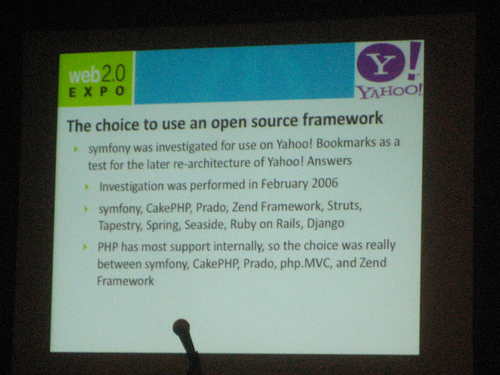

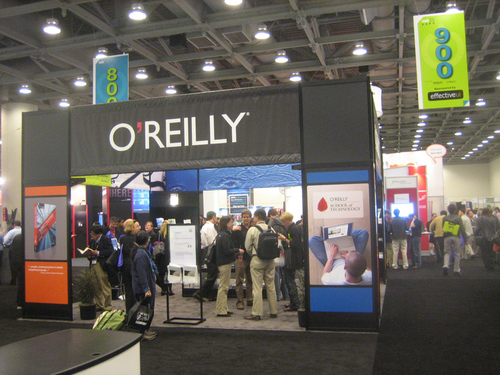



Cloud Services
Posted on Tuesday, April 22, 2008
I've been doing quite some reading on cloud services and web2.0 vs SOA architectures recently. Along the way I came across this informative video by Jeff Bezos from Amazon. He makes a good correspondence to Nicholas Carr's 'The Big Switch'.
Watch live video from HackerTV on Justin.tv
When is the last time you bought music online?
Posted on Monday, March 24, 2008
Came to mind after reading this discussion on TechCrunch following Arrington's reaction on a post in the NYT arguing for artists to receive a cut in the sell of a large social network Bebo hosting a lot of music. Makes sense that the artists should get their share. But then again, its highly unlikely it will ever happen. Unless the artists just unite and create a platform themselves.
On the comments section, there needs to be some innovation in how these discussions are displayed. Surely just listing them under one another is not the only way we can visually interface these threads of discussions.
Cloud computing
Posted on Sunday, March 23, 2008
Nicolas Carr keeps with his story of The Big Switch. This comes from a piece he wrote on the Advertising Age website:
One change that's already obvious is the blurring of the line between software and media. Consumer software, until recently sold like a package good, is becoming the next great media business. The success of a software program is coming to be judged not by unit sales but by the ability of the provider to attract an audience, hold that audience's attention with interesting data and tools, and deliver relevant ads to it.The whole story is well worth the read. Btw, I am not getting paid to include this link or any of the earlier references to that book. Its free publicity. Which all combined seems to help to get him into the WSJ bestsellers list. He must have touched a nerve in IT land.
Richard Dawkins @ UC Berkeley
Posted on Friday, March 21, 2008
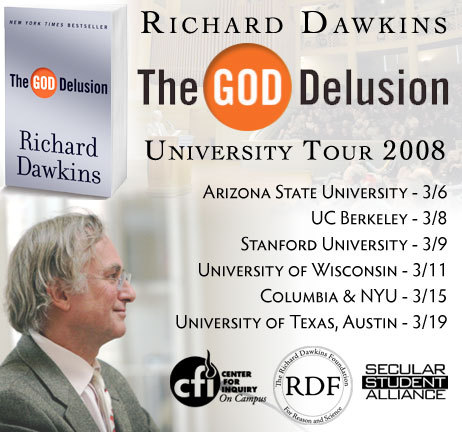
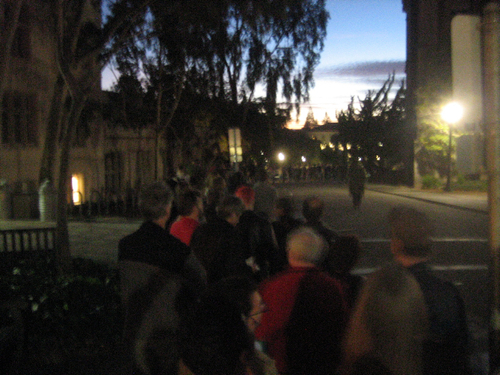
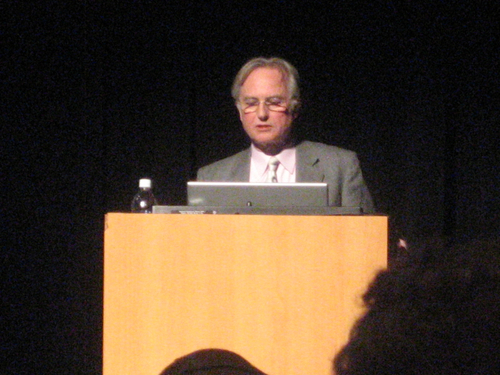
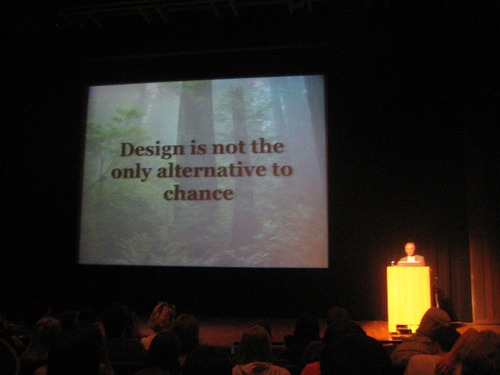
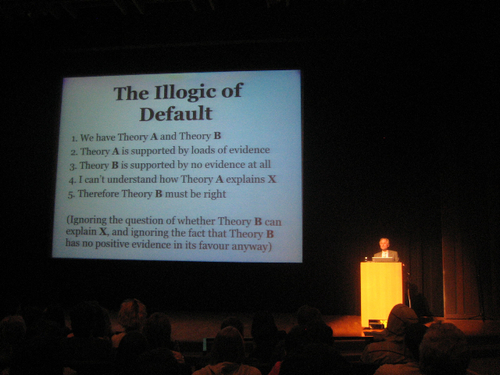
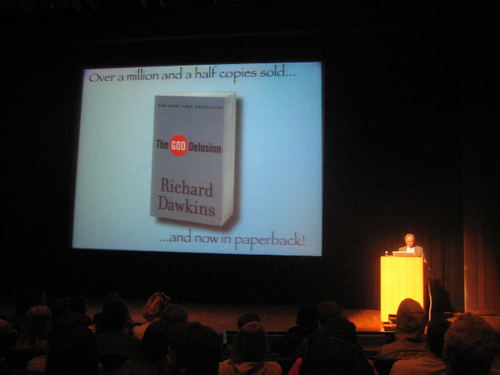
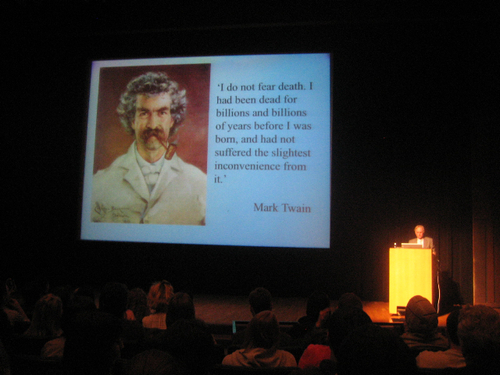
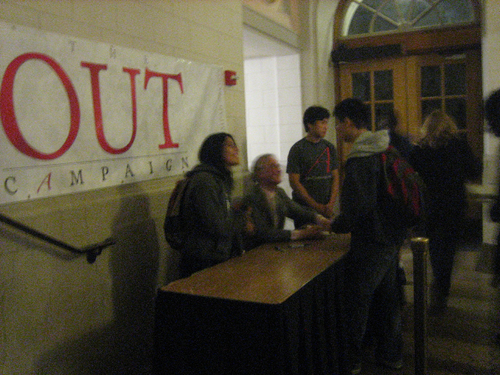
There goes another one from my wishlist. 2 weeks ago I went to see a lecture by Richard Dawkins in the Wheeler Auditorium at UC Berkeley. Although the God Delusion is not my cup of tea (I don't have a religion to loose), my admiration of him comes mainly from his evolutionary work like the Selfish Gene and others. Arriving that saturday evening, things were looking a bit grim at first, I was expecting not a big turn out, but when I arrived there was a large crowd and a long row. Good to see he has a big following in the US. With a bit of luck I managed to get into the auditorium on a standby ticket.
Next on my list: the computer history museum, lunch at Apple and Google HQ, and a couple of others. Keep you posted. Oh, and another one, the Columbia supercomputer at NASA Ames (image below), been there as well wednesday, thanks Creon.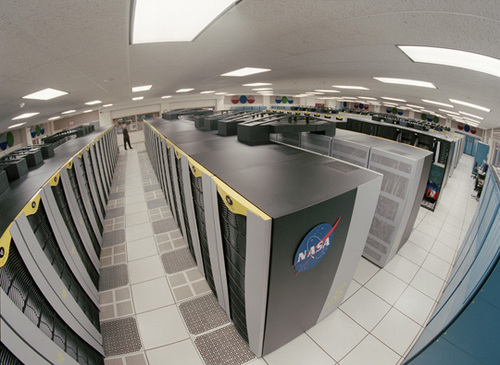
A.C. Clarke died today
Posted on Wednesday, March 19, 2008
...(bbc news)
update: Google's Chief Evangelist Vint Cerf also says goodbye to Clarke in this post. It includes a nice video of Clarke recorded end of last year.
A story of planets and links
Posted on Wednesday, March 12, 2008
Space To The Rescue
Posted on Monday, March 3, 2008
- Need a good
excusereason to go to New York? Read this NYT review of the MOMA exhibition 'Design and the Elastic Mind'. Makes me wanna go! More at MOMA (via Google LatLon) - TED was on. Missed it. Next year. Here are a lot of good videos from it. Lots of buzz about Microsoft's new move vs Google Earth/Sky: World Wide Telescope. The TED video is here. Indepth reviews at OgleEarth and GoogleEarthBlog. Looking forward to a test drive, which will have to wait untill they release it this spring.
- Just learned that Google is running a www.google.com/space subdomain these days with the following overall statement:
There's nothing we love more than ambitious research with world-changing potential, and space exploration and research have long produced much of the scientific community's most ambitious, even audacious work.
We honor the work that's been done in the past, and want to foster and support that work today and in the future. By supporting space-related research and exploration, we hope to inspire a new generation of innovators to enter the fields of science, technology, engineering and mathematics. We believe that the same imagination and passion that fuels space research and drives those who meet the challenge of space exploration will also help advance research and development in fields closer to our own.
That's certainly a statement I can get my head around, especially coming from an IT/media company ;-)
Btw, I learned about the subdomain here at Ames where Chris Kemp and Matthew Hancher (NASA's Planetary Content team Project lead) showed us the Google Street View equivalent on the Moon: Apollo panoramas...uhm...lunalocated (?). Quite impressive. Story telling is a big part of the overall picture, as both reviews (above) of the upcoming Google Sky competitor are right in mentioning. The possibility to re-live Apollo adventures in their appropriate context is excellent. Its still a bit text-heavy for now, but I am sure that that's gonna change as the platforms evolve. Btw2, for some reason this most recent release of Google Moon (think it was this post d.d. 13th September 2007 where it was announced) didn't make it up the list for me, which makes me wonder: is it time for a dedicated Google Space Blog?
Craig Venter @ The Long Now
Posted on Wednesday, February 27, 2008

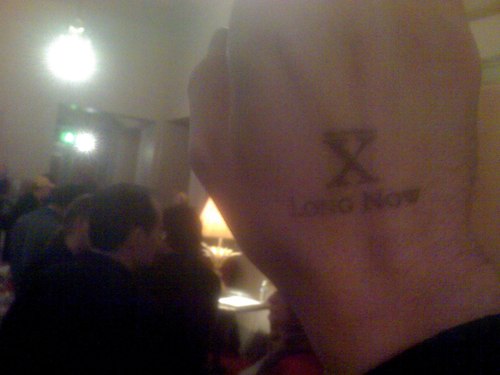
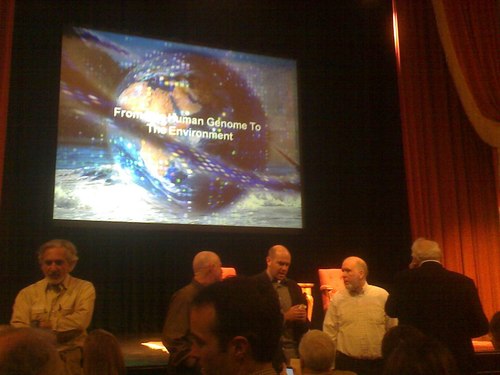
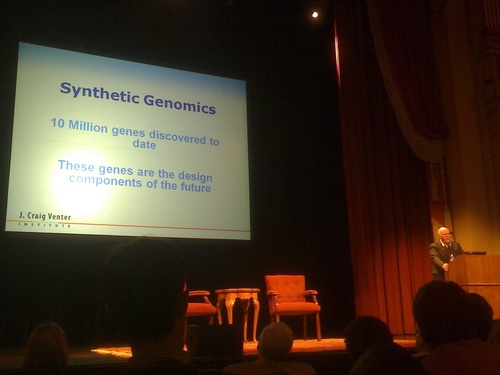
After watching online seminars for over a year now, yesterday I finally got a chance to visit a Long Now seminar in person down in San Francisco. And guess what..!? I was on their guest list ;-) Ever since I learned about The Long Now Foundation over a year ago, I've been a fan. So when I was offered a chance to become a charter member last year, I didn't hesitate. Even got me one of those metal plates the size of a credit card. Plus my name on their guestlist. #518 I am.
So here I was, first choice in seating, amongst all those people I've been learning about by reading a wide variety of blogs over the years: Kevin Kelly, Peter Schwartz, John Brockman, Stewart Brand, Chris Anderson etc. Having arrived in the US only a few days ago, I was clever enough to take my camera battery charger with me while jumping in my car here in Mountain View to head over to SF, only forgetting to realise it only has a European plug. With the battery depleted before arrival in San Francisco (driving the 101 makes for perfect filming scenery ;-), I was left with only my Sony Ericsson P990i phone camera to make some snapshots of the lecture and the audience. Overall, Craig Venter was pretty straightforward in his view on the coming age of biotech. Or, as Stewart Brand put it in his short summary emailed around after the event:
To really read DNA accurately and understand it thoroughly, you need to be able to write it from scratch and make it live, Venter explained.
His sequencing the first diploid human genome (with the genes from both parents) last year showed there is much more genetic variation between humans than first thought. His current goal is to fully sequence 10,000 humans and bring the price for each sequence down to $1,000. With that data, his says, "We'll begin to really learn what's nature and what's nurture."
"Microbes make up one half of the Earth's biomass." Venter's shotgun sequencing of open-ocean microbial samples revealed that every milliliter of ocean has one million bacteria and archaea and ten million viruses even in supposedly barren waters. Taking samples on a round-the-world sailing trip showed that every 200 miles the genes in the microbes are 85% different.
"Microbes dominate evolutionary diversity," Venter said. Some 50,000 major gene familes have been discovered. Humans and other complex animals have a small fraction of that in our own genes, but the "microbiome" of our onboard microbes carry the full richness. Only 1/10th of the cells in a human are human; the rest are microbes. There are 1,000 species in our mouths, another 1,000 in our guts, another 500 on our skins, and those with vaginas have yet another 500 species.
Analysis has shown that a tenth of the chemicals used in our body come to us via our gut microbes. "We are what we feed our bacteria and what they give us."
In an effort to determine what is the minimum gene set for life, Venter's team took a 500-gene bacteria and began knocking out genes. They got the viable set down to 400 and realized that the only way they are going to understand the complexity is by mimicking it. They would need to synthesize a working genome artificially, first on a computer and then with assembled base pairs and "boot it up" in a living cell, making a new, unique species. They devised techniques that repaired errors during synthesis, and they demonstrated that a genome from one kind of bacteria could be implanted in another and come to life there, changing one species into another. "It was true identity theft."
"This software builds its own hardware," Venter marveled.
He emphasized that synthetic biology does not re-do Genesis, but it does offer a kind of Cambrian explosion, building on 3.5 billion years of evolution to go in an infinity of possible directions. The range of possibilities is indicated by an existing organism that can take 1.75 million rads of radioactivity in 24 hours, which explodes its genome. It can reassemble the shattered genome and live on. It can go dormant for millions of years, and live on. That means life may already have migrated between planets.
Venter proposed that our current energy and climate situation requires truly disruptive technology. One project he's working on would use altered microbes to metabolize coal in the ground and generate methane, for a tenfold increase in carbon efficiency. Another project proposes a "4th generation biofuel," where engineered algae directly convert CO2 into hydrogen in bioreactors.
"Ten million genes are the design components of the future," Venter concluded. "With combinatorial genomics and casette-based construction, we can make millions of genomes per day."
During the Q & A I asked Venter why he spends so much of his time speaking in public, 150 talks a year. He said he sees that as part of his scientific work, to prepare the public for the big changes coming. He wants to avoid repeating the mistakes made with genetically modified crops (GMOs), where there was insufficient transparency and regulation, and irrational opposition by environmentalists, which crippled a crucial field.
The public should feel it is included in every stage of genetic science and emerging biotechnology.--Stewart Brand
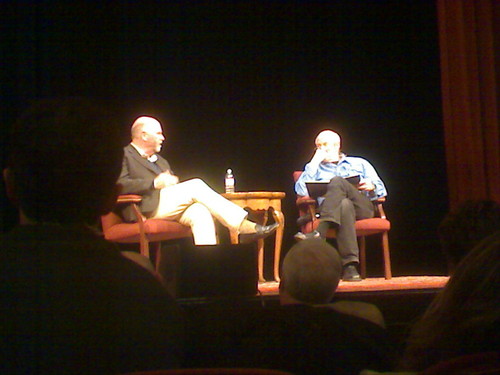
Time to get on the bus
Posted on Wednesday, February 27, 2008

Ok, so its time to give a brief update on my (physical) whereabouts. Since last thursday I moved from Amsterdam to Mountain View, Silicon Valley to work with Chris Kemp and his collegues over at NASA Ames starting next monday March 3rd. Weehoo! Finally, a long held dream is coming true, taking part in the upcoming merger of outer space and cyberspace, right at the heart of where all things space are happening. Couldn't be better!
As for this blog, looks like I will be using it from now on to give you a personal insight in my personal and professional experiences here in the Valley. Sofar, these include a great arrival and first few days enjoying the Bay Area rainy season (yes, it can rain here...), a visit to the Vertical Motion Simulator on NASA Ames premises last friday (for photos have a look at this flickr album), my first NASA vrimibo with Ames director Pete Worden, Chris Kemp and several of my upcoming collegues (vrimibo is short for 'vrijdag middag borrel', Dutch for the traditional friday afternoon drink), a first counter-clockwise drive around the Bay Area, and writing off the first item on my wishlist of things-to-do-when-I-get-to-the-Bay-Area: attending a Long Now seminar in San Francisco (on which more in a follow-up post).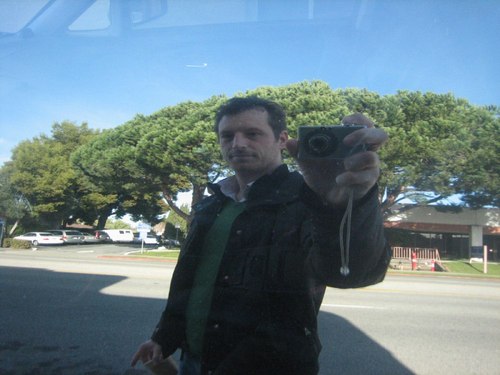
US Satellite shoot-down a success
Posted on Monday, February 25, 2008

Enough has been written about the succesful shoot-down of the defunct NRO satellite last wednesday, so let me just chip in with above photo I found as part of a DoD photo essay of the event. Its a beautiful shot, almost surreal, reminiscent of the V2 and alike. Looking around, I am surprised to find the DoD New Media website is also surprisingly up to speed on web2.0 technologies, as below embedded video of the press briefing by General James Cartwright shows. Some of the clips run a slick CNN-like leader with the name 'The Pentagon Channel'...Interesting proposition...;-)
And the 14 Challenges go to...
Posted on Sunday, February 17, 2008
The Grand Challenges for Engineering in the 21st Century. These challenges have been announced Friday February 15th by a Committee including names like Kurzweil, Page, and Venter. Outer space is one of them, but only via the somewhat non-descriptive Challenge to 'Engineer the Tools for Scientific Discovery'. Cyberspace on the other hand gets its own Challenge to 'Enhance Virtual Reality'.
IYA 2009
Posted on Tuesday, February 12, 2008
Not sure what the aliens are doing in below poster, but during 1 revolution around the Sun its International Year of Astronomy (aka IYA).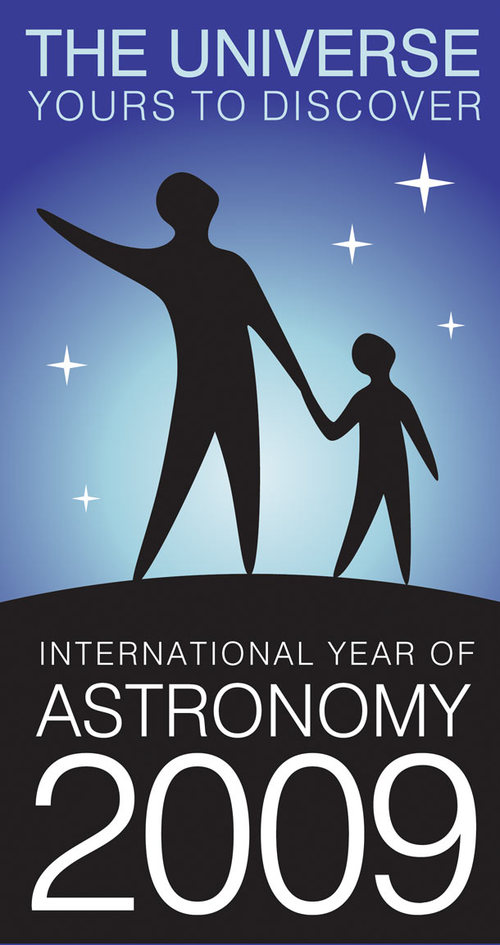
SpaceCollective.org
Posted on Monday, February 11, 2008

Techno utopianism lives on. Its been a while since we heard from Kurzweil, but I recently came across this website called spacecollective.org, set up by former country man Rene Daalder. From a first peek, it seems to be along the lines of what this blog is all about, that is, evolution of technology and the role of space in this evolution. Spacecollective.org seems to have a healthy critical stance, definitely worth a visit. I like the fact it originates from someone in the film industry, one of the main story telling industries out there and a long time passion of mine. Like the Peppers used to sing:
Space may be the final frontier
But it's made in a Hollywood basement.
Immersive Video
Posted on Sunday, February 10, 2008
Via OgleEarth, 360 degrees immersive video delivered to you through the Internet. Impressive. And shareable, like the ones here below (hint: drag the arrow inside the videoscreen).
Realtime news becomes programmable "LEGO"
Posted on Saturday, February 9, 2008
A good post over at O'Reilly Radar on the evolutionary nature of news agencies and the semantic web, carrying amongst others the following copy:
The end of benefits from decreasing the time it takes for news to hit the market. He describes the quest for zero latency in news, from the telegraph and early stock tickers and the news business that Reuters pioneered through today's electronic trading systems. (Dale Dougherty wrote about this yesterday, in a story about the history of the Associated Press.) As we reach the end of that trend, with information disseminated instantly to the market via the internet, he increasingly sees Reuters' job to be making connections, going from news to insight. He sees semantic markup to make it easier to follow paths of meaning through the data as an important part of Reuters' future.
and
What I think does ultimately matter is the ability of professional media to build specialized interfaces and vertical data stores that are suited to their niche, hopefully harnessing data and services from the consumer internet, and mashing them up with specialized, perhaps private, data stores. Put that together with metadata for programmable re-use, and you may really have something.
The Medium is the Mind
Posted on Saturday, January 19, 2008
Another good reason why to read below book, the following quote comes from the author's blog:
"The medium is the mind," I write toward the end of The Big Switch, arguing, as others have before, that the tools we use to gather, store, and analyze information inevitably exert a strong influence over the way we think. As the internet becomes our universal medium - what the director of the Annenberg Center for the Digital Future terms "a comprehensive tool that Americans are using to touch the world" - its technical characteristics also begin to shape, slowly but inexorably, the workings of our memory and our other cognitive processes.
A good way to spent a couple of days with the flu
Posted on Thursday, January 17, 2008
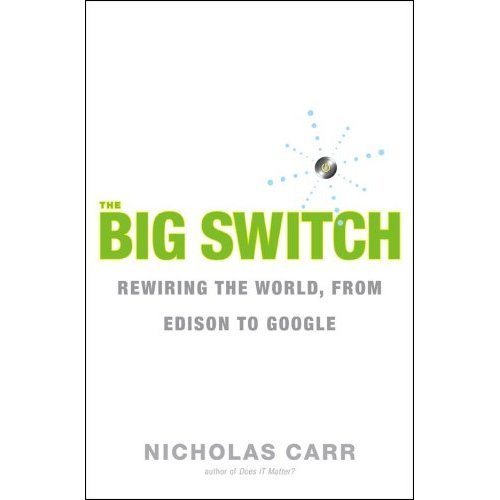
Read The Big Switch. Really, you won't regret it. Gave me the same inspiration as reading The Google Story a couple of years ago. What the future of the Internet has in store for us...
Space Metaphors 2.0
Posted on Thursday, January 10, 2008
Following an earlier mention of space metaphors, yesterday I found this video of Jonathan Harris at TED earlier in 2007. Very nice work! Half way through the video you'll understand the reason for posting it under the title 'space metaphors' (via VanElsas)
Solar Cycle 24
Posted on Thursday, January 10, 2008
Some topics passing by:
- In case you missed it, Solar Cycle 24 just started
- MDA (Canada's biggest satellite business) gets sold to US defense contractor
- The Arts Catalyst blog has recently emerged. From their blog:
The Arts Catalyst commissions art that experimentally and critically engages with science. We bring together people across the art/science divide and beyond to explore science in its wider social, political and cultural contexts. We produce provocative, playful, risk-taking projects to spark dynamic conversations about our changing world.
- A lot of good text over at Edge, following this year's question 'What have you changed your mind about? why?'. Sofar, this entry by Douglas Rushkoff stood out:
The Internet
I thought that it would change people. I thought it would allow us to build a new world through which we could model new behaviors, values, and relationships. In the 90's, I thought the experience of going online for the first time would change a person's consciousness as much as if they had dropped acid in the 60's.
I thought Amazon.com was a ridiculous idea, and that the Internet would shrug off business as easily as it did its original Defense Department minders.
For now, at least, it's turned out to be different.
Virtual worlds like Second Life have been reduced to market opportunities: advertisers from banks to soft drinks purchase space and create fake characters, while kids (and Chinese digital sweatshop laborers) earn "play money" in the game only to sell it to lazier players on eBay for real cash.
The businesspeople running Facebook and MySpace are rivaled only by the members of these online "communities" in their willingness to surrender their identities and ideals for a buck, a click-through, or a better market valuation.
The open source ethos has been reinterpreted through the lens of corporatism as "crowd sourcing" — meaning just another way to get people to do work for no compensation. And even "file-sharing" has been reduced to a frenzy of acquisition that has less to do with music than it does the ever-expanding hard drives of successive iPods.
Sadly, cyberspace has become just another place to do business. The question is no longer how browsing the Internet changes the way we look at the world; it's which browser we'll be using to buy and sell stuff in the same old world.
Social Systems
Posted on Monday, January 7, 2008
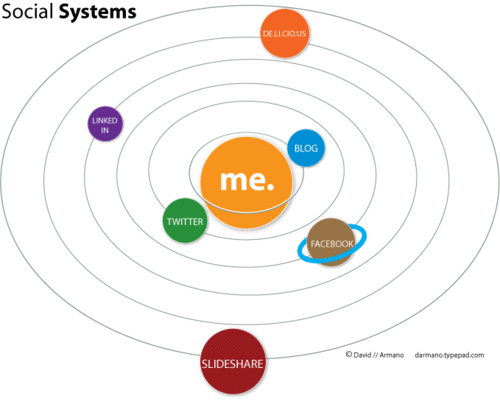
Space makes for great metaphors, but sometimes they can seem just a little bit off. The image above I read, but what about this text:
The related concept of a "social graph" is difficult to explain, but social systems is easy. Many of us are now managing multiple social ecosystems. If you think of these as planets—some rotate in closer proximity to us. We "warm" them with our attention frequently. Others may orbit at further proximities—but they are still in our social systems. When we abandon a social ecosystem that we can no longer sustain, it drifts away from our orbit and dies. Many of us have had these experiences.
The blogpost does link to another interesting post about Influence Riples though. The pond metaphor seems to be better suited here:
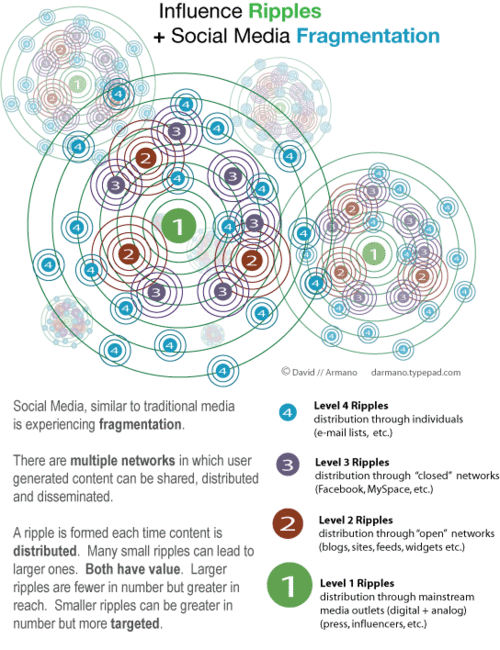
This post's comments also includes another metaphor:
The ripples metaphor is fun, but it is passive and therefore has metaphorical limits.I prefer a bonfire metaphor.
Traditional push-marketing is like a huge organised bonfire. Marketers go to all the trouble of gathering tinder and firewood and inviting people to watch. Then they light the bonfire and stand back as the flames roar and the firewood crackles. Those invited get to enjoy the heat and the spectacle, those a little further away, to enjoy the dancing flames. Those much further away probably don't know there even was a bonfire. And once the bonfire has burnt itself out, all there is left are a few glowing embers and lots of ash.
Social marketing on the other hand is like a network of hilltop bonfires. Lots of different people prepare a limited number of small bonfires. Anyone can start a bonfire and then others on other hilltops can light their own bonfires and so the message spreads. Many people get to enjoy a bit of local heat with their friends and to see the flames flickering on many hilltops. They may even get to feel that they are part of something bigger. And the reach of the bonfire is potentially endless. It only depends upon how many people are willing to light their own bonfires to spread the message.
The metaphor is useful in a number of ways. Firstly, it shows that many small bonfires can reach much further than a large bonfire. Secondly it shows that anyone can light a small bonfire to spread the message to others. Finally, and most importantly, it shows that all these many small bonfires need to be built before the message can spread. If you wait until you see another hilltop bonfire befire you build your own it will be too late. The preparation necessary before a message can spread effectively is one aspect of social media that many commentators forget, in the rush to laud the role of the influencer in propagating social memes.
Back in the real world of influence, it seems to me that traditional marketing and social marketing need each other. Traditional marketing builds category need and awareness (to use the funnel analogy), whilst social marketing enlists those with an interest to spread it further and builds intention to buy. This complementarity is implicit in the p (adoption = traditional marketing) and q (imitation = social marketing) variables in innovation diffusion models in common use for over 50 years!
Keep up the metaphorically enlightening work.
It also links to the following insightful presentation:
Happy 2008 Everybody
Posted on Monday, December 31, 2007
A quick last post before the fireworks. While making dinner I was listening to this talk by Douglas Engelbart at the Accelerating Change Conference 2004. Great talk, especially the way he talks about tools and how they changed society over the centuries and will continue to change our societies in the future. Nice thought to start the new year ;-)
Setting Sun on Mars
Posted on Sunday, December 30, 2007
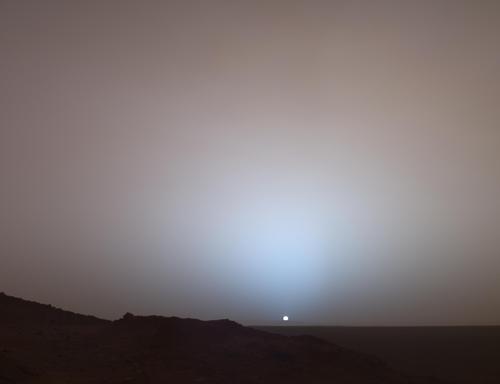
Its the winning photo of a contest over at JPL. Look at the full res image and let it sink in. Quite profound.
Reality Mining
Posted on Thursday, December 20, 2007
Nicolas Carr diggs up another good story: Reality Mining. Some quotes from the TR article:
All this sort-of Web 2.0 stuff is nice, but you have to type stuff in.
and
You can really see things in a way that you never could before--a God's-eye view. One of the examples I've been stuck on recently relates to how transformative Google Earth has been. Imagine having something where you can see all the people moving around on a map. Think about SARS in Hong Kong. What if in a particular apartment building, nobody left for work that day? You could identify a major health problem in 12 hours instead of two weeks. Another example is the social health of communities. It's known that social integration, or how well people mix, correlates with whether or not a community is thriving. With reality mining, you can actually see social integration, as it happens or doesn't happen. Once everyone can see it, then you can start to have transparent political discussions. Why isn't the mayor putting more sidewalks and crosswalks in this area? Could more community events make the area more livable?
The Bible According to Google Earth
Posted on Wednesday, December 19, 2007
Via OgleEarth comes the following:
Sydney art collective The Glue Society produced a work that consists of retouched satellite imagery to depict biblical mythology. Says Glue Society’s James Dive: “We like to disorientate audiences a little with all our work. And with this piece we felt technology now allows events which may or may not have happened to be visualized and made to appear dramatically real. As a method of representation satellite photography is so trusted, it has been interesting to mess with that trust.”
More at Creative Review. Reminds me of an exhibition on Solar Science Debra Solomon, me and Ricky Seabra developed a couple of years ago for ESA as ArtRaceInSpace Ltd. Nice to see Google Earth is entering the domain of contemporary art. Its gonna be a smiley day today. Anybody up for geo-referencing these scenes in Google Earth? ;-)
The Crucifixion
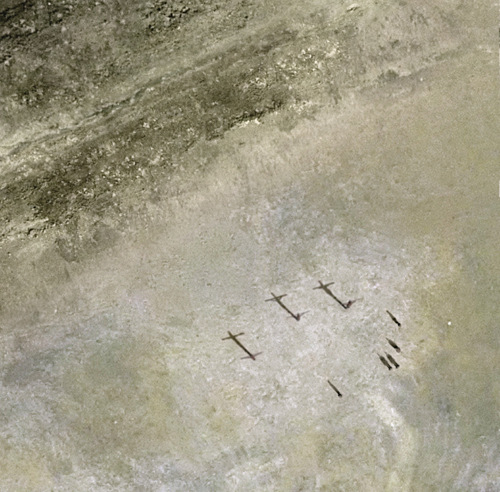
Adam and Eve in the garden of Eden
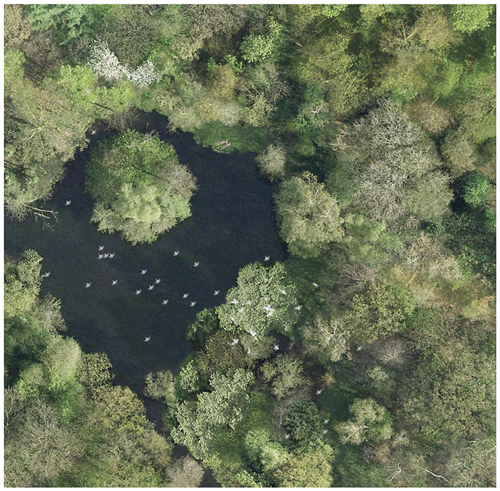
Noah's ark
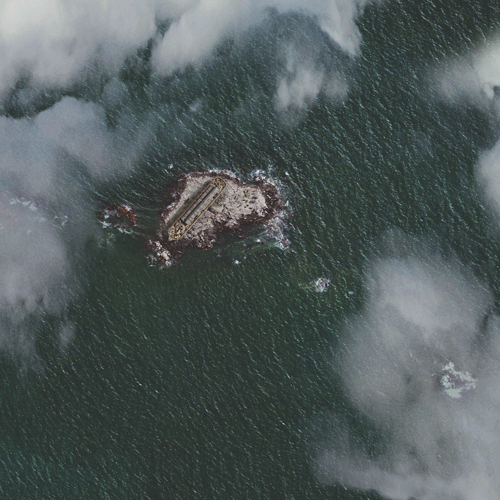
Moses parting the Red Sea
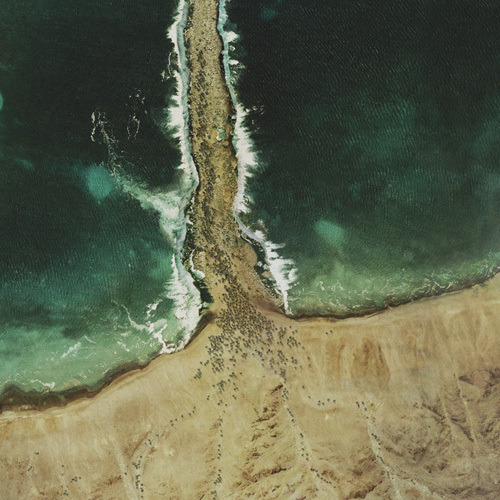
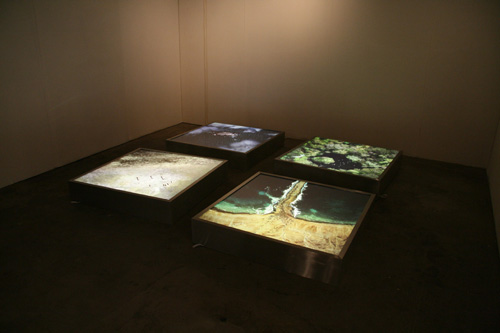
NASA OS
Posted on Monday, December 3, 2007
NASA launched its re-designed portal NASA.gov over the weekend (more at NYT and Wired). First thought: Wow! Great to see a space agency portal evolve into an open platform for space. Second thought: Leopard's Time Machine. Haven't installed the recent OSX update myself yet but at first glance the background of the new NASA portal seems to have a lot in common with that of Time Machine ;-) (earlier post). I'm currently reading Marshall McLuhan's Understanding Media - The Extensions of Man which, thinking of the Extensions of Man out there (aka technology, aka satellites), applies nicely to my Macbook. I guess in the not too distant future we'll be able to pick our favorite live satellite stream as the background to the NASA portal (like this one from SOHO). Too bad exposé doesn't work on the NASA portal because I find myself hitting the top right corner of my screen every time I want to have a look at the background. Some NASAwatch reader comments on the redesign are here.
Another inspiring release came out this week from NASA: the proceedings of the Participatory Exploration Summit held earlier this year @ Ames.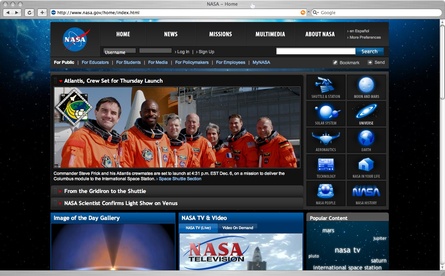
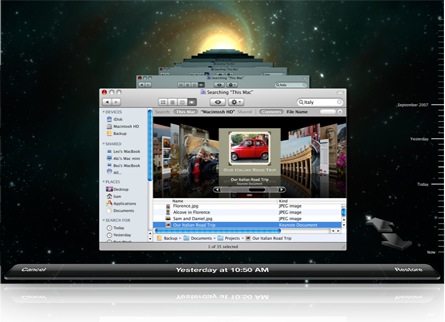
Google Earth and the Evolution of the User Interface to the Internet as platform
Posted on Wednesday, November 28, 2007
After wondering about GE's evolution myself yesterday, Techcrunch is now running a somewhat more blunt story of Google Earth heading towards extinction question mark:
Google has announced two new features for Google Maps that mimic features in Google Earth, begging the question: is Google Earth on borrowed time?The first new feature is the additional of terrain in Google Maps. The terrain fly over feature has long been available in Google Earth, but now you can fly over a map and see the contours of the land, all without the need to download Google Earth.
The second new feature mimics the community contribution feature of Google Earth. “Our Maps” brings wiki-style collaboration to Google Maps, with users able to annotate places and share those notes with friends or the greater public.
Google acquired Keyhole in October 2004 and it was immediately obvious as to why: Google wanted the satellite imagery to support their move into serious mapping. Keyhole provided Google Earth, a downloadable program that gave a then unprecedented view of the earth through the use of satellite imagery, but Google isn’t a software company, Picasa and a few small efforts aside. Google has integrated many of the functions from Keyhole into Google Maps whilst continuing to sustain Google Earth, but for how much longer? As Google Maps takes on more and more of the functionality of Google Earth the appeal of Earth must diminish. It also makes sense that Google would rather grow and sustain a web product over a software download. Google Earth will still be with us for some time to come, but how long is now up to Google, and I’m betting that Google is already looking at ending support sometime in the next year or two as Google Maps becomes everything Google Earth now is, but online and without the download.
Looks like Avi has the most sensible comment in there which deals with the topic at hand:
...As CPUs and browsers become more powerful, the features of the two applications will merge, as I’m sure was the plan all along.But since browser evolution has been so excruciatingly slow, I think it’s far more likely that we’ll see Google Earth become the defacto 3D web browser vs. Duncan’s prognostication.
ISU2
Posted on Tuesday, November 27, 2007
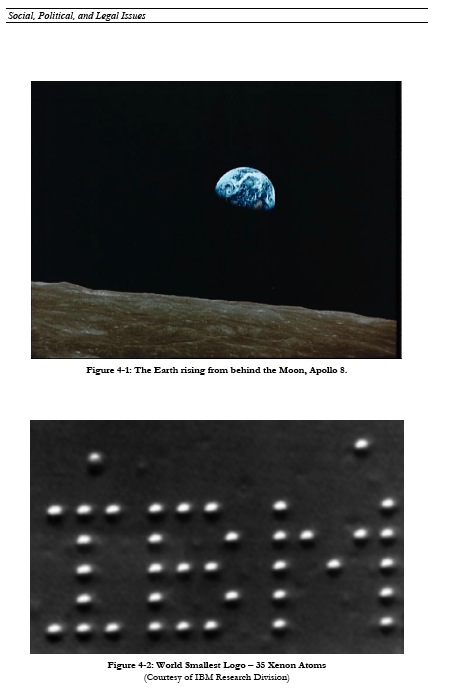
Erik Laan points me to this post about the ISU2 working meeting held at Ames Research Center yesterday and today:
The ISU-2 Working Meeting is being hosted by NASA Ames Research Center to bring together key individuals to brainstorm the concept of the International Singularity University (ISU2) and to answer certain fundamental questions and plan for a "Founders Conference" expected in Spring 2008 and an inaugural Summer Program in 2009 in the Bay Area.International Singularity University (ISU2) which would educate attendees on the history, current status, trends and projected futures of these technologies. ISU2 will facilitate students to form networks, study the implications of exponentially advancing technologies (nano, bio, AI, etc), the cross-disciplinary interactions, and legal, policy and societal implications which will result. ISU2 would be modeled on the concepts and practices pioneered by the International Space University (ISU) during its past 20 years of operation (1987 - 2007).
Date: 26-27 Nov 2007
Location: NASA Ames Research Center, Moffett Field, CA, US
Web Site Address: http://www.arc.nasa.gov
Way to go Ames! I am an alumni of ISU1, that is, the International Space University, where I participated in the '06 summer session Team Project dealing the impact of Micro & Nano Technologies for space so I am thrilled to see the ISU formula being applied to a topic that is close to my heart. In fact, I think I'd gladly follow the ISU-2 summer session cause it'll have a lot of interesting ground to cover. And Silicon Valley is the right place to be when it comes to the Singularity. ISU1 summer session 2009 is already scheduled to be hosted at Ames so '09 promises to become a truly remarkable summer over in Mountain View.
Google Space Agency
Posted on Monday, November 26, 2007
A quick backlog of links related to the Google NASA coop. They're working on it down at Ames in what is called the 'Planetary Content Team' (nice title):
The Planetary Content Team at NASA's Ames Research Center develops software that makes it easier for scientists and engineers to publish and access Earth and planetary imagery and data via the Internet. This includes both educational/outreach content aimed at the general public as well as technical data aimed at the scientific community. Headquartered in the Intelligent Systems Division at Ames, the team also includes partners in other areas of the agency and elsewhere.
They do both the NASA Google Moon work (Google maps only sofar but they're working on a Google
“NASA’s objective is for Google Moon to become a more accurate and useful lunar mapping platform that will be a foundation for future Web-based moon applications, much like the many applications that have been built on top of Google Maps,” said Chris C. Kemp, director of strategic business development at NASA Ames. “This will make it easier for scientists everywhere to make lunar data more available and accessible.”That's gonna come in handy when the robots are going to land on the Moon in the decades to come.
View Larger Map
Remap our intuition
Posted on Monday, November 26, 2007
A new video with Will Wright talking about Spore at TED earlier this year. Great stuff. Some interesting quotes and discussion @ 12:10 -> "remap our intuition" - "computer simulations can recalibrate your instinct across vast scales of both space and time" - "better calibration on long term thinking".
Digistuff
Posted on Monday, November 26, 2007
Alexander van Elsas points to a flickr set with some nice quotes. They're not all that great but enough are interesting to wade through. Here are a few of my favorites.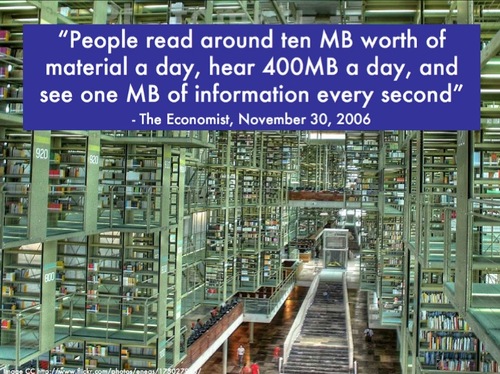
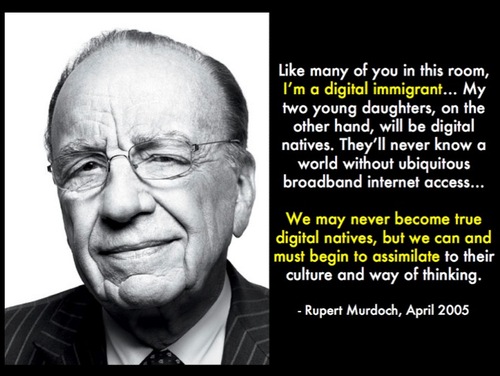
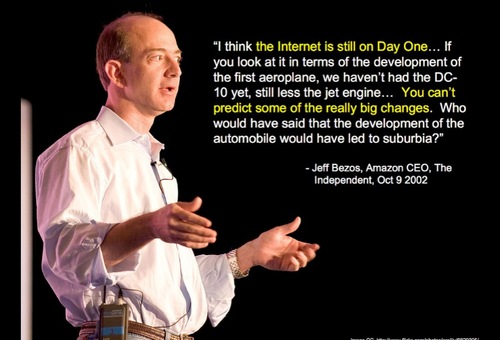
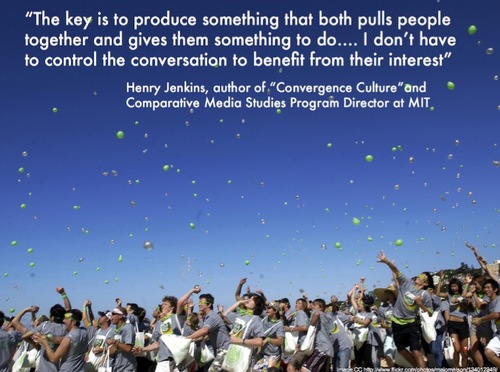
Thanksgiving 2008
Posted on Thursday, November 22, 2007
No thanksgiving on this side of the pond but a nice thursday evening in Amsterdam. A nice post by Nicolas Nova (one of my favorite blogs) on an article in the Economist on the fading fad of futurism:
Think small, think short—and listen
So there you are on the moon, reading The World in 2008 on disposable digital paper and waiting for the videophone to ring. But no rush, because you’re going to live for ever—and if you don’t, there’s a backed-up copy of your brain for downloading to your clone.
The most heeded futurists these days are not individuals, but prediction markets, where the informed guesswork of many is consolidated into hard probability. Will Osama bin Laden be caught in 2008? Only a 15% chance, said Newsfutures in mid-October 2007. Would Iran have nuclear weapons by January 1st 2008? Only a 6.6% chance, said Inkling Markets. Will George Bush pardon Lewis “Scooter” Libby? A better-than-40% chance, said Intrade. There may even be a prediction market somewhere taking bets on immortality. But beware: long- and short-sellers alike will find it hard to collect.Reminds me of a quote from CNBC back in 2000: '"time is money, so real-time is real money". Where is my online prediction market?
Some thoughts following the Space Explo Conference
Posted on Tuesday, November 13, 2007
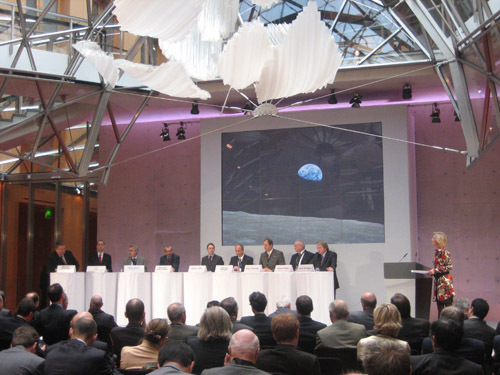
Update 15 November: I was told at ESTEC today that videos of the conference will indeed be posted lateron once they are finished with the editing.
I went down to Berlin last week to attend an ESA/DLR conference on the future of Space Explo in Europe. A lot was said, presentations were abundant, and the various stakeholders (in particular politicians, space agencies and industry) gave their view on what Europe should be doing in the years to come on space explo. One of the main outcomes of the conference: the European Space Exploration Strategy has been reworded to the European Space Exploration Programme...he, these things can make a world of difference.
Interestingly enough, the M word, as in Moon, is still hard to pronounce by Mr. Sacotte of ESA as the agency has decided it should focus on the Mars. Seems this is a position they took when NASA was fully engaged with Mars exploration back in the early 00's. However, since then, Bush has redirected the NASA strategy towards bringing humans back to the Moon, and it seems hard for ESA to bring its strategy in line with this redirected global explo agenda. So while all countries pulling any weight in the space explo arena, China, India, the US of A, all have their focus on the Moon, Europe seems to be struggling with their lock-in in thinking about the Mars (the English pronounceation of native German speakers brings some funny mashups, as in talking about the Moon vs talking about the Mars). Germany however isn't fooled and recently announced its plans to develop a national lunar probe, something that was re-iterated at the conference by DLR Director of Space Programmes Mr. Dollinger.
There was a point where I got intruiged about the way they talked about the usual dichotomy between robotic (unmanned) and human exploration. Usually, this debate quickly ends in the trenches where the proponent on either side digs him/herself in with the usual arguments, leading nowhere. A first smart remark in this context I remember from US astronaut Jeffry Hoffman (of Hubble repair fame) who made the comment at ISU about the complementariness of humans and robots (I don't remember his complete argument, but given that he went up to space to repair a robotic explorer kind of paints the picture of his understanding). At this conference, there was the same question on the table. On itself an interesting question and space is one of the few places where this comes up all the time due to the shear costs involved in sending humans up. This time, it felt as if the conference participants, all human to my knowledge, where there to make a strong case for human exploration...because all of us attending were human. It seemed there was a stance in the robotic/human debate about us against them. Its the first time I interpreteted the debate this way, but it makes for an interesting perspective on where things might be going. The drive to explore doesn't change, its the means that are under scrutiny. Another argument in this context, one that I made together with an ISU collegue last year at a presentation was the following: the most efficient space suit is one without a human inside.
Another important topic which seemed to come up every 5 minutes during the conference was the need for communication of why Europe needs to take part in this global exploration agenda. Well, I guess its true then. The 'Artist as Space Explorer' space & the arts exhibition was nice in that respect but I had a strong deja vu of some 7 years ago when I was involved in a similar type of set up for ESA and the exhibition was mainly used as decoration around the bar with free champagne. Not that different here. Still, it appears there is a little seed taking root at ESA. Hope they'll let it grow...
If this were the web2.0 Summit held in San Francisco last month, the presentation videos would have been online by now. But this is a meeting of much less importance so no videos yet (space exploration...wasn't that something with Apollo?). I really hope they put some videos of the conference online, but given ESA's track record of keeping the walls high and dry, I have my doubts. I'll certainly address it when I get to ESTEC this week. Also in terms of putting the presentations online. If you're interested to put some faces to names, have a look at the flickr photoset I uploaded with the main talking heads. Below pictures were from a presentation by astrophysicist Hans-Joachim Blome about the Cultural Dimension of Human Spaceflight and Exploration. He managed to stay out of the usual paths and gave a glimpse at exploration from a scientific evolutionary point of view. I hope to receive his presentation later this week so I can post it here. 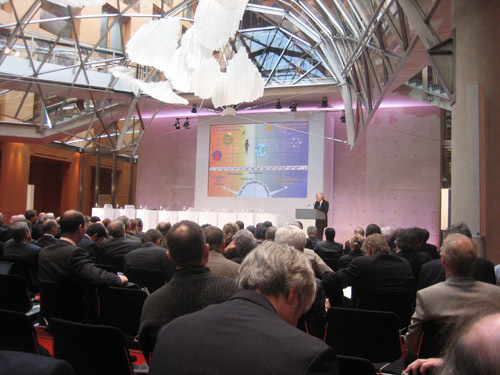
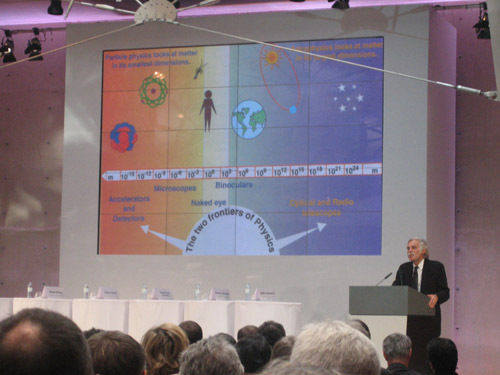
Facebook takes the dive
Posted on Friday, November 9, 2007
Yikes, this is getting pretty weird: Facebook Is Marketing Your Brand Preferences (With Your Permission). More at Battelle. And the best analysis yet, over at Rough Type: "The medium is the message from our sponsor". He also has some more on McLuhan.
Targeted advertising...or machine learning...?
Posted on Tuesday, November 6, 2007
Which of the two was it again? Who's teaching who? This insightful article Can Facebook feed its ad brains? on the imminent Facebook ad platform (and related industry) gives some clues. It still amazes me that this is the business model on which most of today's web2.0-ish Internet ventures thrive. Highly relevant advertising. Actually, when I think of it, the 'what other users liked who bought this book' feature over at Amazon is quite ok. Not that I immediately go out and buy all those books, but it provides a bit of context, and in that sense its not all that unuseful. These emerging data patterns still strike me as the Internet's equivalent to thoughts emerging, although I also immediately hear myself saying: "don't metaphor me in".
I had a very brief chat on Skype late last night with a friend over in Australia who was just about to go to work in the morning and who had this to say about it:
the 'machine' is the mechanism: the mechanism is the people. The 'machine taking over' is ultimatley a submission unto the hive of the people - it is a social demise as well as the literal manifestation of technology - and an avoidance of the self, the self will and self power of thought
DinnerTV: Its getting there, the Social API
Posted on Saturday, November 3, 2007
Aka OpenSocial. Below video gives a good intro.
DinnerTV: Web2.0 Summit videos
Posted on Friday, October 26, 2007
And yet another good one, this time about the Semantic Edge, the platform of platforms (recursion recursion...we didn't did invent language, and now we're only mapping it. its a nice user interface for sure). More after the weekend, first its time for a couple of days on the Edge of the Alps .
DinnerTV: Web2.0 Summit videos
Posted on Friday, October 26, 2007
Another good one, Google, Microsoft and TeleAtlas talking about one of the web's edges, i.e. mapping. Btw, if you experience some problems with scrolling through the videos (which is not allowed!?), you can also subscribe to the videos via iTunes and scroll through them that way.
DinnerTV: Web2.0 Summit videos
Posted on Thursday, October 25, 2007
They're all interesting and they keep adding new ones. The discussion between Tim O'Reilly and Craig Venter is especially worth the time invested. To add to that, what about this term: "user generated biotechnology" ;)
Web2.0 summit
Posted on Sunday, October 21, 2007
For a quick update on what's happening with Web2.0, have a look at the bloggin' over at O'Reilly Radar on the Web2.0 Summit that took place last week. Here are a couple of interesting posts in my opinion:
- Web2Summit: Backstage with Rob Currie of Dash
- Web2Summit: Radar Networks Unwinds twine.comWeb2Summit: Backstage with Meg Whitman
- Web2Summit: Backstage with Mark Zuckerberg
- More on Techmeme and Financial Markets
Here are the videos. And this is another good post @ O'Reilly: CFP Where2.0 2008
DinnerTV: 30min. of the Google Guys @ Zeitgeist 2007
Posted on Sunday, October 21, 2007
Zeitgeist 2007 (below is the Youtube video). @ 9:54 Larry Page talks briefly about Google's involvement in the X-Prize, @ 17:32 Esther Dyson hints at inner space (i.e. healthcare) being a more interesting market than outer space:
Outer space is really cool but I am not sure how much Google can do with it.(via SearchEngineLand)
Vint Cerf on the Status of the Interplanetary Internet
Posted on Sunday, October 21, 2007
Found at SpaceDaily:
Internet preparing to go into outer space (nice title!)
After expanding across Earth, the Internet is now set to spread into outer space to reach parts no network has gone before, one of its co-creators predicted Wednesday.
Vinton Cerf said the proposed "interplanetary" Internet would allow people an ability "to access information and to control experiments taking place far away" from Earth.Expanding into the solar system would bring new rules and regulations too, he told an annual Seoul forum, saying he and other experts were working on a set of standards designed to guide space-era Internet communications.
"Finally, the Internet can take us where no network has gone before," said Cerf, who is Google's vice president and chief internet evangelist,
He said he and a team of engineers at the California-based Jet Propulsion Laboratory would complete a key part of the project -- establishing standards for space communications like those for Internet -- in three years.
Cerf told a separate news conference that new standards were needed because of the huge distances and time delays involved in communication across space.
He went on: "This effort is now bearing fruit and is on track to be space qualified and standardized in the 2010 time frame.
"Eventually we will accumulate an interplanetary backbone to assist robotic and manned missions with robust communication."
Evo Devo IntelliDeso...Mutating Pictures
Posted on Friday, October 12, 2007


Dawkins' book 'The blind watchmaker' has an extensive discussion of how evolution walks through the solution space of an evolving artificial species. Above images from Mutating Pictures are a nice example of this when you take it to the web for people to do the selection (via Google Blogoscoped).
Virtual just another layer on top of physical
Posted on Friday, October 12, 2007
Tim has an interesting post up at O'Reilly Radar where he talks about the announcement of IBM and Linden Labs (creator of Second Life) that they're working together on interoperability of virtual worlds:
I look also for the 3D web to interoperate with location-based services. We shouldn't think of this interoperability as being just for virtual worlds. Ultimately, virtual is just another layer on top of physical. GIS folks don't think of maps per se, they think of map layers -- hundreds or thousands of levels of data overlaid on the world. Many of these layers are abstract and virtual. Aren't street addresses actually virtual? Might not other classes of data be anchored to the real world in some way? A company has a physical address, but they also have an address on the telephone network, an address on the web, and many others. Just as a skyscraper reaches into the sky from a single street address, housing thousands of souls at work or at sleep, might there not be virtual towers anchored to physical locations, embracing and extending our world?
There's quite a future ahead of us here. It's silly to try to recreate the wheel (or to own the wagon) when by working together we can build something that is so much bigger. Open standards are a winning strategy.
DinnerTV: Facebook meme
Posted on Monday, October 8, 2007
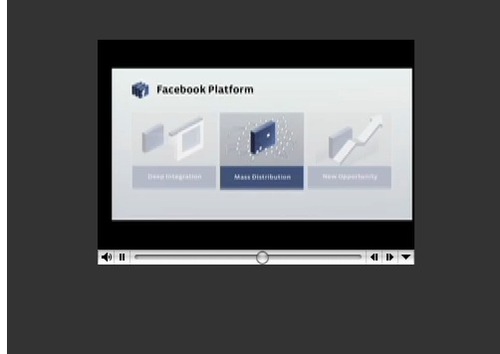
A few weeks of relative unplugged quality time and whoop, you're missing the 'next big thing' on the Internet. It took a while, but I finally spent some time reading up on the Facebook meme. Mmm, interesting, a pagerank Social Graph view on people instead of websites...For a good intro, read this, make an account here, and have a look at this video with Mark Zuckerberg talking about the Facebook platform for developers (not sure if I like his version of the Steve Jobs style though...).
Sign up now: your 7-day excursion to on the Moon
Posted on Sunday, September 30, 2007
Doing some overdue reading on developments in the space explo arena, I am struck by below slides depicting an assessment of possible Lunar sorties in NASA's latest Lunar Architecture update (Sep'07). They give a pretty good first grasp of the distances involved when future astronauts r gonna have a great time driving around the Lunar surface with their Moon buggies. Looking forward to joining them near real time from behind my computer (with only a 1.5 sec lightspeed delay). Another report text worth a look at is the Global Exploration Strategy (May'07) as it provides an interesting (albeit somewhat romantic) view of space explo in an effort to globally coordinate space exploration agendas into a global exploration strategy. Harnessing the collective space intelligence...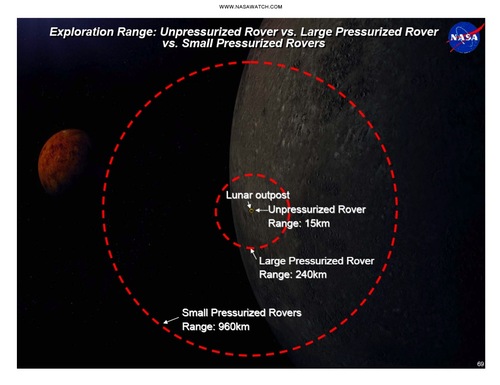 ;br>
;br>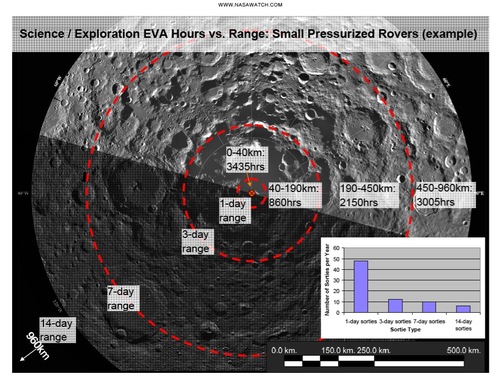
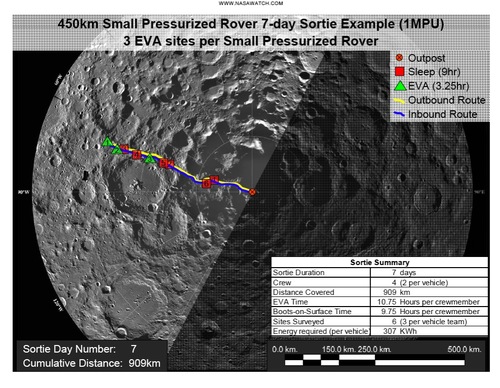
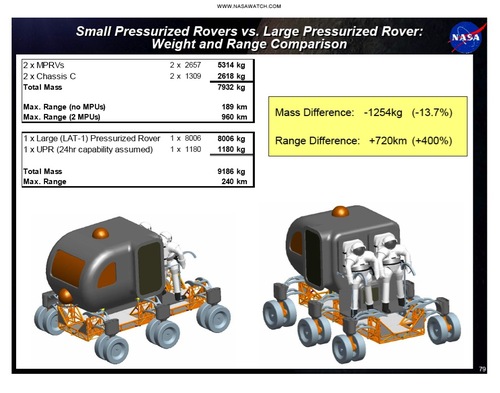
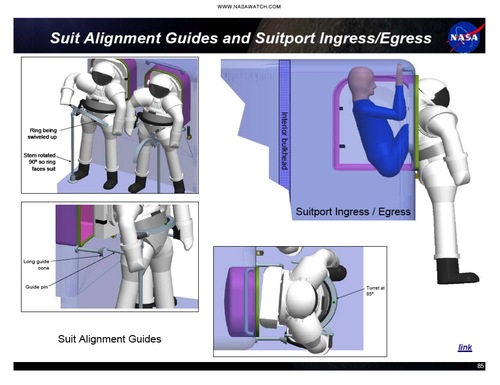
Finally: a peak inside online mapviewing behaviour
Posted on Thursday, September 27, 2007
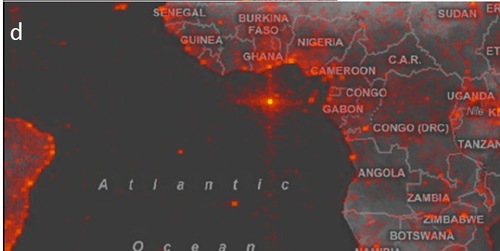
What are we looking at in online interactive mapping systems such as Microsoft's Live Search or Google Earth/Maps? Interesting stuff to wonder about. All Points Blog thinks so too and links to a paper by Microsoft researcher Danyel Fisher entitled Hotmap, Looking at Geographic Attention (above image shows one of many intruiging images from the paper, this one depicting a bright spot at Latitude/Longitude (0,0)).
Evolutionary benefit from Space Explo
Posted on Thursday, September 20, 2007
Reading up on the Google Lunar X Prize at the BBC I come across this quote from Peter Diamandis, X Prize founder (and ISU founder):
"We are confident that teams from around the world will help develop new robotic and virtual presence technology, which will dramatically reduce the cost of space exploration," said Dr Peter Diamandis, chairman of the X-Prize Foundation in a statement.Working in the space business, one question that keeps me busy these days is trying to understand which of the technologies to be developed for the "space race to come" will influence society on the long run. Computer chips have gained evolutionary benefit from both the military (nuclear missile guidance systems) and the '60 space race (Apollo descent stage). If history accounts for anything, it is pretty clear spin offs from endeavours such as space exploration will play out in society in unexpected ways. With the X-prize's emphasis on robotic exploration and telepresence technologies, I bet you there will be more of this fusing into society in the decades ahead, the question is only how exactly. By the time space exploration gets anywhere, I doubt we will experience the world as we do today.
Powers of Ten: still your best guide on what's coming
Posted on Tuesday, September 18, 2007
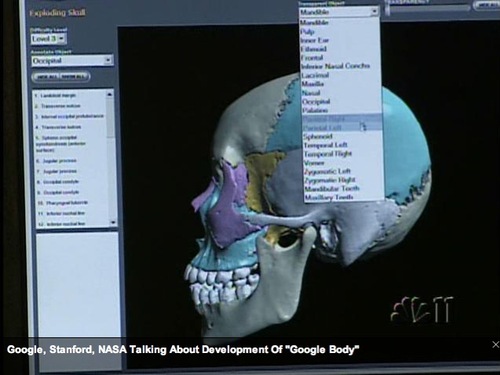
With Google Sky just released, the news of an upcoming Google Body (slideshow) makes me tempted to make a graph with all Powers of Ten from the 1977 movie and see at what level scientific research, government research agenda's and corporate interests are playing out (and not to forget: the military agenda!). Seems this Powers of Ten paradigm (often quoted as inspiration for Google Earth) is still your best bet at trying to understand and predict human progress these days, not only in terms of research but also in terms of accessibility of these non-human scales to average citizens through tools such as Google Earth.
This weekend I had another brief encounter with Google Sky after my initial confusion a few weeks ago from lack of reference while scrolling the skies. This time it was a lot better, although I still think an actual 3D representation, at least of the Solar System, would be way cooler than the MyFirstPlanets representations currently moving around Google's heaven (have you seen the demo tour in Celestia yet?). The current sky implementation feels more like a representation of how old civilisations once thought stars were holes in the black heaven sphere with fire behind it making them shine like they do. Its a good beginning, but they definitely need to catch up with 21st century cosmology.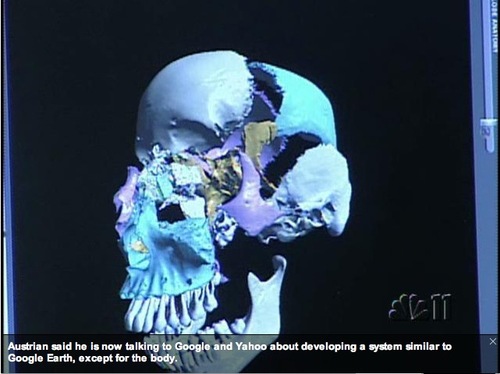
DinnerTV: South Park meets World of Warcraft
Posted on Thursday, September 13, 2007
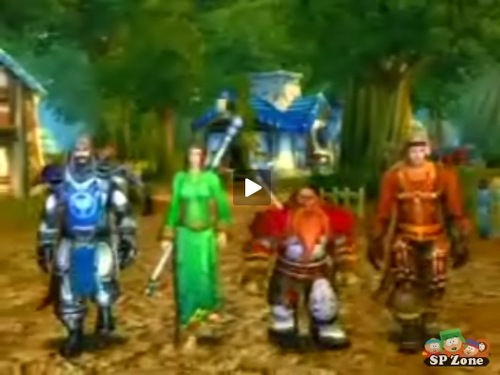
I just read that one of the best pieces of television in a looooooooooong time has just won an Emmy (in Dutch). I've watched it over and over again, and for once this episode remains funny even after seeing it more than 10 times. Strangely enough, I've never found a good version on the Internet to share with you...until now. If you can handle the somewhat lower resolution and the annoying logos flying in and out of the screen in this 'official' online version (is YouTube going to be like this? I hope not!) then enjoy: South Park meets World of Warcraft (be sure to check the full screen button).
Today's NASA Slogan: All Your Space Are Belong To U.S.
Posted on Sunday, September 9, 2007
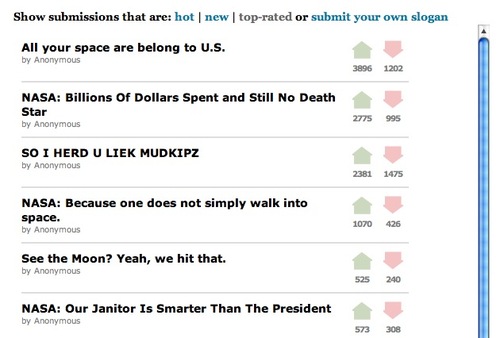
Wired is running a crowdsurfing NASA slogan contest to see if its readers can come up with a better slogan than the recently selected "NASA explores for answers that power our future". Starting out as a gimmicky blogpost (read a long list of proposed-slogans-as-comments here), the large number of entries have moved the contest to a more sophisticated system (the NASA Slogan Reddit Tool!) where people can cast votes on the various entries. Above image shows the top-6 of today, Sunday September 9th 2007.
Sofar, many of the proposed slogans go back to NASA's glorious past, poking fun at present-day achievements. With the CEV vehicle (aka Orion) resembling Apollo all the way down to the parachuted landing (water or land, what does it really matter?), having a slogan referring to the successes of the past seems to me to match NASA's own state of mind (yep, its the the wisdom of crowds allright). In that sense, having a slogan bringing back the glory days of NASA isn't all that far fetched if you ask me...I mean, how inspirational is this graph: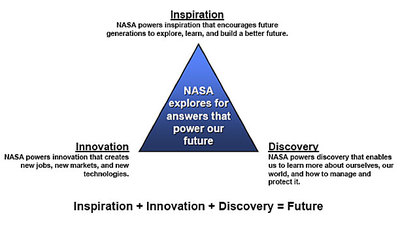
compared to this image: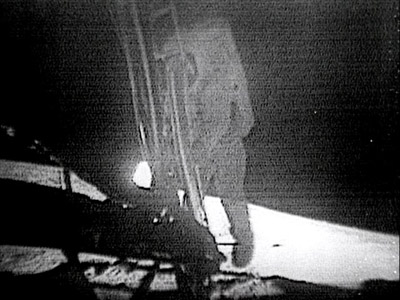
Would be nice to have the WIRED contest run indefinite while NASA's Vision for Space Exploration unfolds, having something like a NASA Slogan Zeitgeist over the coming decades. Btw, if you're interested, some more background information on NASA Strategic Communications can be found in this powerpoint pdf.
Geoweb In The News
Posted on Sunday, September 9, 2007
'The world on Your Desktop' in The Economist, a fair read (with a good introduction over at OgleEarth) plus a first commentary on the article at TechConsumer (both via OgleEarth).
Google Earth and Google Sky Currently Don't Connect
Posted on Friday, August 31, 2007
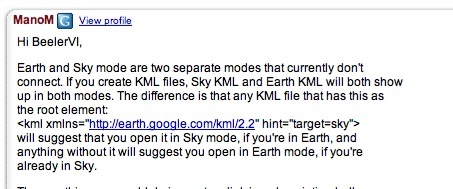
Currently..? Above screendump shows a response by Googler ManoM on the KML Developer pages which caught my eye while doing my weekly checkup on new discussions and topics. Still no time to do a proper scope of all the new stuff that came out with kml2.2 and Google Earth 4.2 but this provides an interesting lead when I'll find that time.
Art2.0?
Posted on Sunday, August 26, 2007

Nice how the EPFL lab below uses above image of Magritte for their lab (aptly named 'pic home.bmp').
NASA2.0 & OBE
Posted on Saturday, August 25, 2007
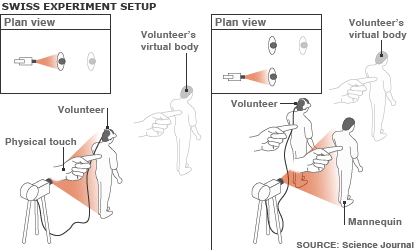
Another good move by NASA: NASA partners with Internet Archive to put space archives online. More over at CNET NEWS. Meanwhile, in Lausanne, a team of researchers recreated an Out-of-Body Experience in the lab...sweet.
Signs of Singularity: The Floraweb Is Coming
Posted on Friday, August 10, 2007
Are you ready for the Floraweb? Then watch below video ;) (via O'Reilly Radar):
DinnerTV: Vint Cerf on the architecture of the coming Geoweb
Posted on Monday, August 6, 2007
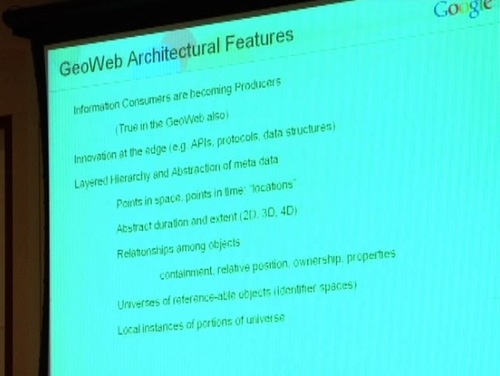
Thought provoking videos have come from the Geoweb2007 conference in Vancouver end of July (via). My shortlist:
Vint Cerf (a must-see)
Jack Dangermond (fresh view for me)
Michael Jones (always interesting)
I was especially struck by the conceptual insights of Vint Cerf where it comes to the architectural design of something as intangible as the virtual Geoweb. And of course his opening remarks to keep the Geoweb conceptually open for the eventual SolarSystemweb are music to my ears ;) Quote of the day comes from Michael Jones:
A map has become a searchable information landscape
RoadmapHuman
Posted on Saturday, July 28, 2007
From AllPointsBlog comes the following quote:
The biggest threat facing the two competitors [NAVTEQ and Tele Atlas] in the future may be user-generated map content – a mapping equivalent of YouTube, as it were.
Following on below post, and reading these two articles in Newsweek and SignonSanDiego about how TeleAtlas and Navteq go about their business, I can't help but metaphor you in by comparing their on-the-road employees with the likes of GoogleBot, Technorati Searchbot, Tailrank Robot etc. Isn't it funny how we start mimicking behaviour from the virtual world into the real world. I wonder what other behaviour we might see emerging in the real world which has its origin online?
Humans r Sensors
Posted on Saturday, July 28, 2007
OgleEarth has an inspired and inspiring post up today on the coming human sensor web. If you have some time to spare, do check out his post and surf around on the links he provides in this article. You'll be in for an inspired weekend brief. Like always, Google Earth CTO Michael Jones has many interesting things to say on future prospects and more philosophical insights into where it all might be leading. Surfing on OgleEarth's original post, I found this audio recording (28min.) of a recent talk he gave at the Cambridge Conference (15-20 July). Sounds like a geospatial del.icio.us and Digg are in the making. I wonder though if there are any plans to share any future ad revenues Google would be making from all the user generated content and stories submitted by its users, and if so, how that would be done...
LinkedIn, Facebook, Hyves (the worst UI of all times)...
Posted on Thursday, July 26, 2007
Where is my social network of networks?
Operating systems
Posted on Thursday, July 26, 2007
Just found this quote at A VC
...But what's important here is that the web is going to be an operating system...
Hmmm, gotta think this one through. Its been going around for a while (e.g. with Google Gears), but I hadn't made the jump yet...(via Battelle)
Twitter As The Sixth Sense?
Posted on Wednesday, July 25, 2007
I have some vague but strong memories of reading a book as a kid where on another planet a civilisation evolved to a state where they could communicate via telepathy. In my memory, this way of communication felt surprisingly natural, so natural even that I hardly took notice of the fact that it was actually way off from the way we normally communicated on this planet in the 20th century...
Fast forward to 2007: mixing up web2.0 with space explo (or the other way around) is being discussed at the participatory explo workshop at Ames. Reading this 26June Wired article 'How Twitter Creates a Sixth Sense', I can totally dig it. Consider walking around your local supermarket and getting twittered by your favorite Moon explorer having a picnic on the Moon with a view of the Earth. Now that's what I call stretching the mental picture. Preferably the Astronaut2.0 will also send me some live images of the Earth, but that's another story...Btw, do machines twitter? (via MarketingFacts)
Catch up time
Posted on Tuesday, July 24, 2007
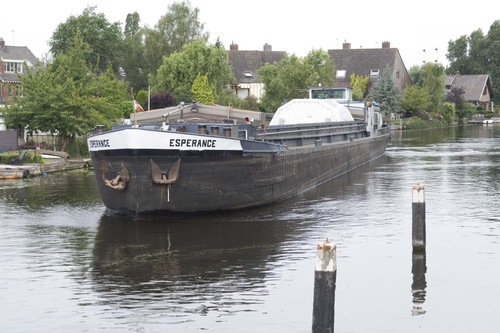
Bloggin' has been sparse these last few weeks, partially because of my latest dive into UGO development. Assuming you read OgleEarth and Google Earth Blog, you are pretty well covered on interesting news coming out these last few weeks. Just a few things worth (re)blogging:
- The Automated Transfer Vehicle (ATV) was transported from ESTEC to Kourou for launch to the ISS next year. There is a nice photo report at ESA, amongst which above photo. A Billion+ craft going through the Dutch canals ;)
- The first Metaverse Roadmap (MVR) is out. An inspiring read!
- NASA has now its own layer inside Google Earth. Still rather rudimentary, like the ESA layer, but a good start. (via Google LatLong blog)
- Barnabu blog posted two space related kml's showing the Moons and the planets in a solar system context (via GEB). Its latest addition, the Cosmic Microwave Background Radiation
- OgleEarth has been ogling Mars. And again. Looking at the word 'ogling' a couple of times, its about time to have a better understanding of what to ogle actually means. As a Dutchman I usually assume I have a comprehension of the English language, but most of the time I know I miss the subtleties of knowing the real English use of a term. For my own understanding, here is the Merrian-Webster dictionary explanation:
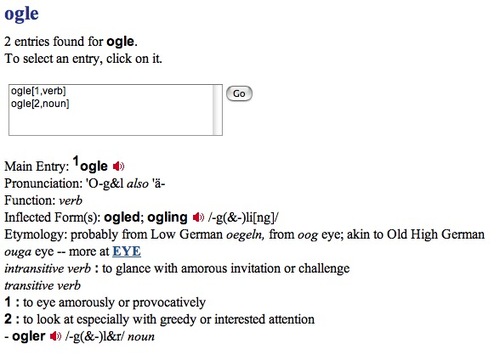
Aha! How about OgleMars.com Stefan? ;)
Where do you NOT want to go today?
Posted on Thursday, July 5, 2007

Don't think windows is quite ready yet to get us into outer space ;) The same thing I have seen several times on LCD screens in the public transport here in Amsterdam...nothing more telling than an ad space crashing like that...you just want to press that OK button and get on with...(via edparsons.com)
Virtual Worlds Presentation by Mitch Kapor
Posted on Tuesday, July 3, 2007
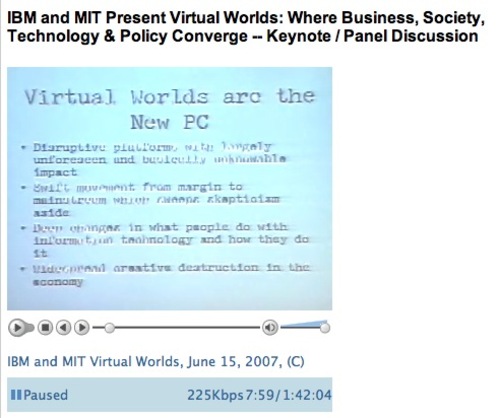
Over the weekend I stumbled on this 1:42:04 video of Mitch Kapor (of Lotus fame and an early investor in SecondLife) giving a presentation and leading a panel at the MIT Virtual Worlds laboratory June 15 (just 2 weeks ago!). Interesting watch/listen! I am still a bit skeptical about all this virtual world stuff, but like he says, this seems more to do with the feeling of knowing there is something going on but that its hard to articulate what it exactly is. For everybody interested in getting a good introduction about virtual worlds, do watch/listen the whole video.
The panel discussion is also worth noting. I especially like the comment by Robert Gehorsham (with Forterra) at 1:22:23 into the video about the self-imposed limitation of 'only' rebuilding real3D into a virtual platform. Somebody throws in: 'locked into assumptions'. Good point. Lets use virtual worlds to flex our limits within the Powers Of Ten, not stick with the human scale only (there is enough of that around already). Here are two other interesting scribbles from watching the video: reality acquisition devices & ROI on mystical experiences. And not to forget, the quote of the day: Please don't metaphor me in!. Btw, there is a new 6min talk by MS Virtual Earth PM over at TED.com
Human-Machine-Nature interfaces
Posted on Monday, June 25, 2007
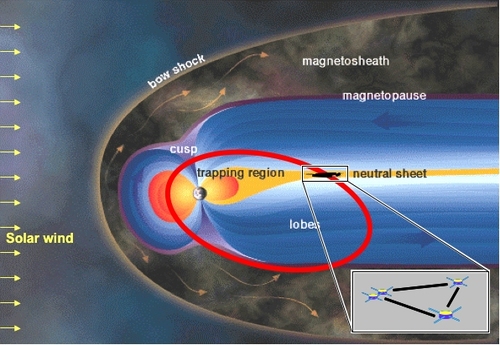
Quite some news recently about human-machine interfaces coming out. In particular the non-intrusive ones like this collaboration between Graz and University of London (check out this video ;). Not related, but OgleEarth is back at blogging, and he brings back some cool footage from ISDE5. Like he says, a possible hint at where things might be going with digital globes. Now what i'd like to see is a near real time vis of the Cluster data in one of these domes...magnetosphere storms as they happen...These four ESA satellites are up there now, so how difficult could that be?
Oh, and a quick note about an interesting conference coming up:
- The 11th International Conference on Information Visualisation from 2-6 July, interconnected with this Vizualisation summit
Light posting ahead
Posted on Saturday, May 12, 2007
Haven't been very active on this blog lately, which is mainly due to my full focus on the development of my UGO project, making me less susceptible to reading my section of the blogosphere on all the news coming out on a daily basis. I haven't finished my first build yet, so this light posting will likely continue for the coming days/weeks untill I finalise a first UGO app. In the meantime, some interesting developments worth noting:
- Search Engine Land (definitely a good read)
- a joke
- Anil Dash post
- News.com
And of course there is the news of a new WorldWind JAVA release.
Some other news items I found
Posted on Monday, May 7, 2007
Some other new items I came across these last few weeks:
- An update on the Google NASA colab
- An upcoming technology that might change how you view photos (check out this video, even if its only for the fine choice of Bach music)
- Mouse brain simulated on computer
Updated blog feed
Posted on Tuesday, May 1, 2007
Mmm, turns out I already had a FeedBurner account with several subscribed readers to this blog (re: earlier post). Strange how things like feeds can get this complicated...;) Anyway, to keep things organised I decided to delete the new account and merge its feed with the already existing one. For those of you who subscribed to the new one in recent weeks, please visit my blog's webpage and (re)-subscribe one more time to the FeedBurner link on the right.
To check if you have the correct feed, the correct FeedBurner account should now have the following URL: http://feeds.feedburner.com/tobedetermined (for Safari on OSX this should read: feed://feeds.feedburner.com/tobedetermined)
Thanx again...
Ray Kurzweil
Posted on Monday, April 16, 2007
in case you missed it, this video gives a 23 min run-down of Ray Kurzweil's thinking. Its from February 2005, so its lagging a couple of paradigm shifts, but nonetheless...
Expanding Digital Universe
Posted on Tuesday, April 10, 2007
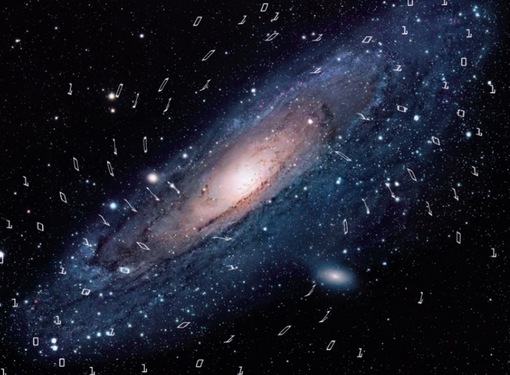
Naive as it may seem, I kind a like this cover image in the report: The Expanding Digital Universe: A Forecast of Worldwide Information Growth Through 2010. The Guardian reports... (via).
Flying to the moon
Posted on Saturday, March 17, 2007
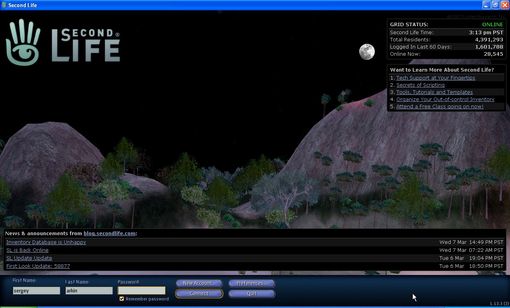
Click to enlarge
Still trying to get back into Second Life after I lost my password...the help line doesn't do much...let alone trying to get a new free login...hope they solve their my problem before NASA gets back to the Moon in First Life.
Dropping the bomb
Posted on Monday, March 12, 2007
One of the nice extra's of working in the space sector (and currently collaborating with Russian Submarine Launched Ballistic Missile (SLBM) designer SRC Makeev) is the opportunity to sometimes get a little sneak preview into the Russian industrial military complex. One of my collegues from Samara recently wrote me an email announcing his absense in our collaboration because he was going to a conference in a higly secretive town called Sarov:
Yes, I'm back from Sarov, one of the "mail boxes" (i.e. closed secret towns). When I say closed I meen that it's really closed - the whole town is surrounded by fence, with only few check-points. You need a special permission to enter and also another permission to leave! Foreigners should apply 3 months before visit.
In Sarov he managed to visit the Nuclear Weapons museum. All items in below photo are nuclear warheads, with a particularly large one in the back. The second photo shows my collegue in front of the worlds largest fusion bomb. I don't know, but it has a weird kind of 'Tintin' or 'Melies' feel to it. Imagine dropping a bomb like that...
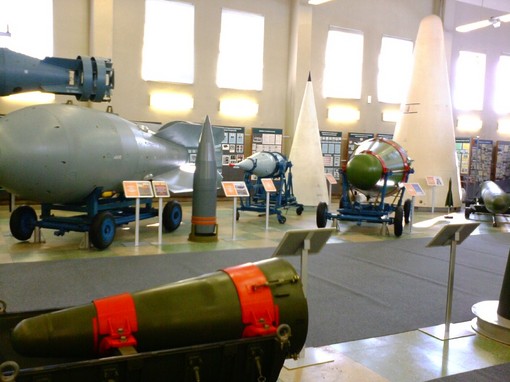
Click to enlarge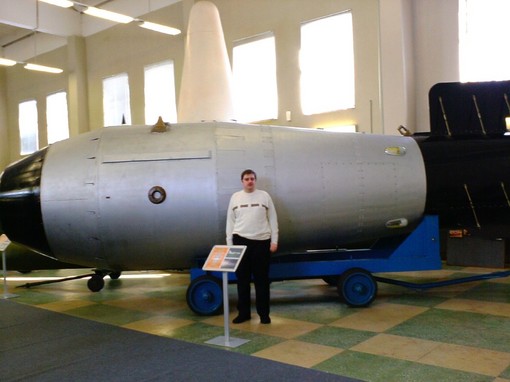
Click to enlarge
The Earth pulse
Posted on Monday, March 5, 2007
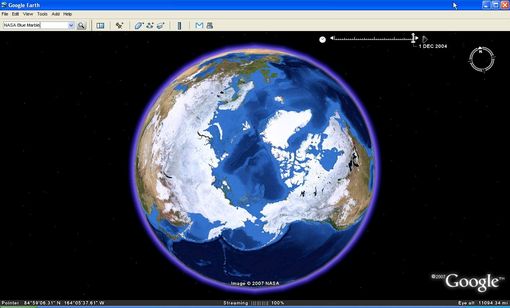
Its not my normal routine to blog about Google Earth kml files. For one because Google Earth Blog and OgleEarth do a much better job than I ever could, and (2) because there are so many being released these days that it is hard to keep up (don't want to end up in the categories section of the geographic web...and now with kml search, that's no longer needed anyway).
This one I have to blog though. Reading through the kml specifications, I came across this time-lapsed serie ![]() of NASA Blue Marble imagery. Still puzzling over the idea of 'pattern recognition' as prophetised by Jeff Hawkins of Numenta (previous tbd post ::: just found out they released their first release of the Numenta platform for Intelligent Computing (NuPIC)), this serie of images displaying the appearance of the Earth through 1 orbit around the Sun gives food for some good pattern recognition thought. See for example the pulsating ice sheet coverage as seen from the North Pole (image above). Its quite extraordinary that everybody running a computer and an internet connection these days can have a look at these out-of-this-world patterns. And this is only just the beginning. Anytime soon now, we can all have a go at making our own personalised 'unconvenient truth' documentary ;)
of NASA Blue Marble imagery. Still puzzling over the idea of 'pattern recognition' as prophetised by Jeff Hawkins of Numenta (previous tbd post ::: just found out they released their first release of the Numenta platform for Intelligent Computing (NuPIC)), this serie of images displaying the appearance of the Earth through 1 orbit around the Sun gives food for some good pattern recognition thought. See for example the pulsating ice sheet coverage as seen from the North Pole (image above). Its quite extraordinary that everybody running a computer and an internet connection these days can have a look at these out-of-this-world patterns. And this is only just the beginning. Anytime soon now, we can all have a go at making our own personalised 'unconvenient truth' documentary ;)
But...but, where's the singularity?
Posted on Sunday, March 4, 2007
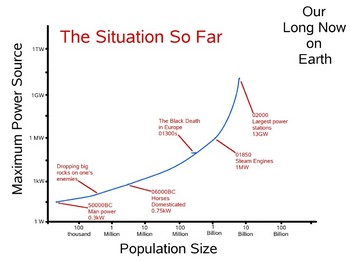
Vernor Vinge recently gave a talk at the Long Now foundation: What if the Singularity does NOT happen.
....It's 2040 and nerds in old-folks homes are wandering around, scratching their heads, and asking plaintively, "But ... but, where's the Singularity?"...As part of his excursion into possible future scenarios for humankind in case the singularity does not happen, he explores the importance of human space flight as a way to secure our long term future. His conclusions sofar:
Humankind's presence in space is essential to long-term human survival.
That is why I urge that we reject any major humans-in-space initiative that does not have the prerequisite goal of much cheaper (at least by a factor of ten) access to space.
Makes sense. Not so sure though if I agree with the idea of human spaceflight as being essential for our future survival, but that doubt is more to do with the notion of 'humans-in-space' compared to that of 'humankind's presence in space'.
traceroute Rosetta
Posted on Tuesday, February 27, 2007
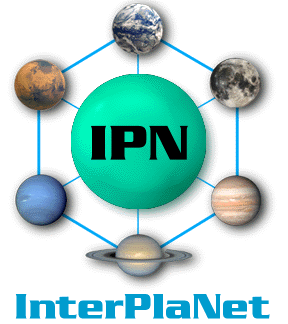
Related to my previous post on Rosetta's view of Mars, I just read on Slashdot about the plan Vint Cerf is working on to expand the Internet into the Solar System:
Communication between a rover operator on Earth and a rover on Mars, via a relay orbiter, can't use standard Internet protocols end-to-end. That problem is at the root of a lot of the design work we're doing for the IPN... As part of the NASA Mars mission programme, the project aims to have by 2008 a well-functioning Earth-Mars network.An excellent read I must say, the Slashdot discussion, especially because only at the very bottom of the page does it actually start talking sense, the rest is just geeks getting off on geekjokes. Thought this one was quite to the point:
Parts of this planet we live on don't even have access to a broadband Internet connection, and now they want to plug Mars on the network? Talk about priorities...But then again:
parts of this planet are even more worthless than the lifeless Mars. Leave the stragglers behind..keep pushing forward. -they don't call it the human race for nothing
The idea to expand IP into the Solar System has been around for a while, and to me it obviously makes perfect sense. Evolution you might say. It has been working in Low Earth Orbit onboard an SSTL satellite for quite a while already (video @ Cisco), and Cisco is seriously interested to get deeper into the game.
KML search capability: hurricane+katrina
Posted on Tuesday, February 20, 2007
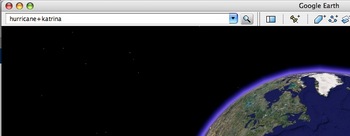
Click to enlarge
OgleEarth and Directions Magazine have the news of a KML search capability recently announced by Google on their maps API blog.
Leaving the discussion on the licensing of Google Earth @ work for a moment, here is an intruiging thought I like from Allen Doyle discussing the release:
But, hey! It's a start. The buzz is there. It's easy to post KML files. How hard would it be to post the entire metadata holdings of a large geospatial data provider like NASA or NOAA in KML? I bet a service like GCMD could post theirs in a week. At Where 2.0, we could be watching demos of Google Earth finding, and displaying, realtime remote sensing data.Makes me wonder what an HTM would have to say about the patterns?
Btw, below is what Google Earth now comes up with searching for 'hurricane+katrina'. Fairfield Inn by Marriot? Not exactly what I was looking for...although...mmm, maybe...if it were realtime data ;)
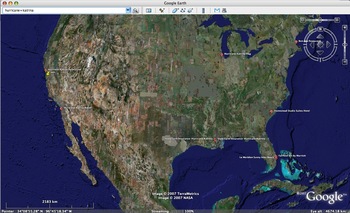
Click to enlarge
On Intelligence
Posted on Sunday, February 18, 2007

Every now and then I gather a list of books I come across while doing research on the Net and order them via Amazon. The latest batch included a book called 'On Intelligence' by Jeff Hawkins, published in autumn 2004 (Amazon). I started to read it a couple of days ago and it completely captured my imagination. Finished it in 3 reads. If you are interested in state-of-the-art thinking on how the brain conjures up something like intelligence, and how this could potentially be implemented in machines, this is it.
Some of the most thought provoking points for me stem from his discussion on the potential of an Artificial Intelligence (AI) intelligent machine, or HTM (Hierarchical Temporal Memory) as he calls his model (.ppt), to make sense of the world through some as yet undefined exotic senses. For example, if he is right that the neocortex basically works on patterns, an intelligent machine based on HTM can learn to make sense of (and predict) global weather patterns using as exotic sense a widely distributed sensor web. Basically, any pattern can be used in this sense, be it Google user statistics, stock market fluctuations, satellites studying Solar Weather, genetic sequencing, hell, even the web itself is probably one big pattern if you have the right senses for it...we could be in for some pretty unexpected extensions of our reality, if we know how to translate them back to our human senses that is...
Doing some further background reading, I came across a couple of interesting video presentations by Jeff on his theory, potential applications and his future plans. In addition, I found this remarkably recent (feb '07) Business2.0 article on his current whereabouts at Numenta, the for-profit company he spun off from the Redwood Center for Theoretical Neuroscience to implement the model he described in his book 2 years ago. And here is a recent Science article about the same topic (Oct. '06).
- Jeff Hawkins presentation at the 2005 MIT Emerging Technologies conference (48 min.)
- Jeff Hawkins presentation 'How the cortex works' (Sep. '05, 54 min.)
- Jeff Hawkins presentation at IBM Almaden Institute (May '06, 64 min.)
- Business2.0 blogpost with brief video interview
Chinese ASAT test analysis in Google Earth
Posted on Sunday, February 18, 2007
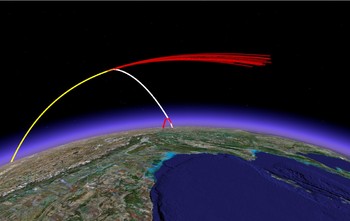
Click to enlarge
Catching up on my blog role after a week of virtually no second life activities (is that proper English?), I come across a post at OgleEarth on the Chinese Anti-Satellite test I blogged about last month. Turns out researchers at MIT's Science, Technology and Global Security Working Group did exactly what I was looking for: a visualisation of the satellite kill in Google Earth.
Apart from the kml file displaying above scene in Google Earth (which as yet appears to be a static visualisation only), they also issued a report on the same website which gives some further analysis of the event. It is here that I am happy to find the first (well, actually 2nd ;-) online evidence of the use of Google Earth for actual visualisation in the realm of space engineering and analysis beyond mere pretty images (see images at bottom of this post).
Scanning through the document, it seems the program they made the analysis with is a recently released stand-alone program to calculate ballistic missile trajectories which has a direct output to Google Earth. From their website:
GUI_Missile_Flyout is a stand-alone program running under Windows for simulating ballistic missiles with 1, 2, or 3 stages in a framework with a round, rotating Earth. Users can easily input all the necessary parameters in an intuitive graphical user interface (GUI). A modest number of quantities can be interactively plotted on the Interface but the complete trajectory can be saved as either an Excel or Matlab file for further analysis. The trajectory can also be directly displayed in Google Earth for visualization. The GUI can be used to optimize gravity turn parameters to maximize range or aim at a specific target (entered, as is the launch site) through latitude-longitude pairs. In addition to an introduction to using the program, this paper describes the integration of the three-degrees-of-freedom equations of motion and approximations made to the aerodynamic (such as a parameterized drag coefficient, Cd).Incorporating the option to directly output to Google Earth readible format is something that has been occuring on a frequent basis in the traditional GIS field but I haven't heard of it yet in the space arena. I wonder for example what STK's strategy is in this respect? They have their own AGI viewer, but as with all the different GIS viewers, who is interested to have all these different systems installed when Google Earth can handle them all at once, and on top of that is also cross-platform (which most sophisticated analysis tools are certainly not yet).
If you use this program for a publication, please reference: Geoffrey Forden, “GUI_Missile_Flyout: A General Program for Simulating Ballistic Missiles”, submitted to Science and Global Security. December 2006.
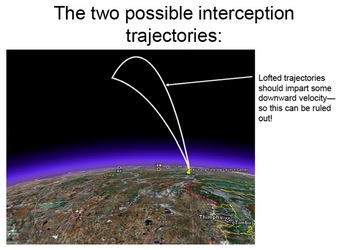
Click to enlarge
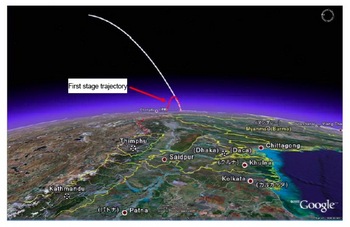
Click to enlarge
Nature's own GPS satellites
Posted on Sunday, February 11, 2007
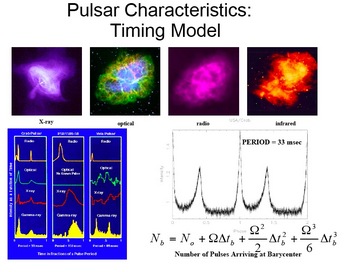
Click to enlarge
Doing some research for a project I am collaborating on with Jeremy Hight, I just learned about DARPA's X-Ray Pulsar-based Navigation and Timing (XNAV) project, a likely candidate for future space navigation beyond the GPS/Galileo web. Seems the whole Solar System will become a location aware arena in the not too far future...
For a good intro, have a look at this DARPA project powerpoint. Some more information can be found at NewScientist (Sep. '06), and The Space Review (Dec. '06).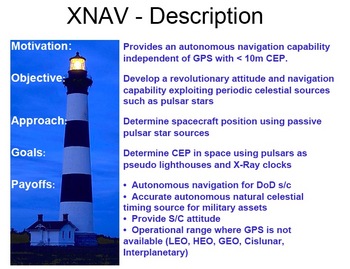
Click to enlarge
The Space Economy
Posted on Friday, February 9, 2007
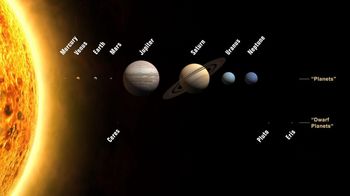
Click to enlarge
How to market a +30 year product/programme like the US Vision for Space Exploration (VSE)? Luckily for us some folks over at NASA are thinking about it:
“As I see it, questions about the Vision boil down to whether we want to incorporate the Solar System in our economic sphere, or not. …The ultimate goal is not to impress others, or merely to explore our planetary system, but to use accessible space for the benefit of humankind.”
Dr. John Marburger
The President’s Science Advisor
Speech to the 44th Robert H. Goddard Memorial Symposium
March 15, 2006
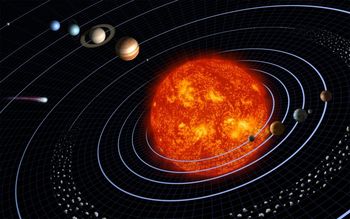
Click to enlarge
Google is coming to town
Posted on Friday, February 9, 2007

Well, not exactly Amsterdam, but the Netherlands at least: Google opens datacenter at Eemshaven (near Groningen) (in Dutch).
You, Science and Recursion
Posted on Monday, February 5, 2007

Part of the video in my previous post corresponds to what Kevin Kelly talks about in this very interesting 1-hour presentation on the history and future of the Scientific Method:
Kevin Kelly
The Next 100 Years of Science: Long-term Trends in the Scientific Method (mp3)
Friday, March 10th 02006.
One of the main points he makes here is the importance of so-called 'recursion' for the Scientific Method. I haven't completely grasped his idea yet (need to listen to the podcast again), but it kind of gives a name to a phenomenon I was wondering about myself a couple of weeks ago. As an engineer, I know surprisingly little about marketing but as far as I can see, basically, with the markets now having become global, there is no 'outside' anymore when it comes to marketing. When we market, we (hypothetically) market to the entire world, that is, the entire human population. Which also includes ourselves...exactly this idea of recursion: the process looks back on itself. So does this mean the nature of marketing will change, and if so, what are the 'meta-models' that will come out of this recursion...? Seems to me virtual globes and alike convincingly portray this recursiveness (like the Apollo 8 did back in the '60) and therefore could play a role in this process. Seems also to have to do something with conciousness, but to make that claim I first need to read Godel, Escher, Bach ;)
Btw, more podcasts from Seminars About Long Term Thinking at The Long Now Foundation are available here.
Web2.0: the ghost and the machine
Posted on Monday, February 5, 2007
(via O'Reilly Radar & Dutch Cowboys)
Space Arms Race, Here we Come!
Posted on Wednesday, January 31, 2007
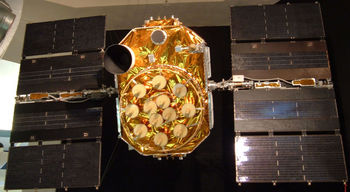
Click to enlarge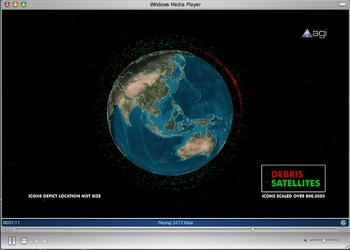
Click to enlarge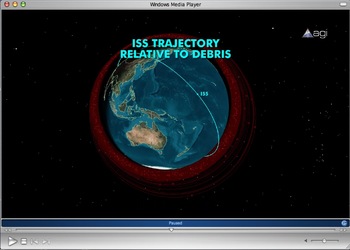
Click to enlarge
[Update Friday 2nd Feb 02:00 CET: The new space race has apparently already started. More news, including a STK visualisation of the debris cloud resulting from the kinetic kill, at AGI's Center for Space Standards & Innovation (CSSI) (via Spaceports blog)]
Excellent title of this space blog entry at the Lifeboat Foundation, following the Chinese Anti Satellite (ASAT) weapons test earlier this month:
Space Arms Race, Here we Come!It’s true - when one nation moves into space weapons, others are forced to follow just to keep up. It’s the Red Queen scenario, where you have to keep moving forward just to stay in the same place. Because preventing the weaponization of space is likely impossible, it looks like we will have to come to terms with it. One beneficial side effect of a space weapons could be the development of better space systems in general, which could eventually be used to create autonomous colonies.
The latter could actually be true. If so, what could be the emerging technologies out of this new weapons race, or out of the upcoming peaceful Moon race variant as described in this 2004 Space.com article:
Strategic target“The moon is the first step beyond low Earth orbit that any spacefaring nation is going to try to master,” said Mike Duke, a geologist at the Colorado School of Mines in Golden, Colo. The Europeans have passed that mark, he added, so their lunar missions are described as technology demonstrations.
Meanwhile, the Japanese are trying to display their technical prowess in instrumentation. “They need to demonstrate a reasonable launch capability to be considered a player in that arena. They’ve had some problems, so maybe the lunar mission is a driver to keep the rocket folks focused,” Duke said.
Duke said China and India have arrived at a place in their development where they can do lunar missions and gain in stature among spacefaring nations.
“I’m afraid that I don’t see that any of these really involve the moon as a strategic target for exploration, though everyone is looking for that strategic handle,” Duke said.
“I'm not sure what to make of it all in the grand scheme of things,” said Paul Spudis, a planetary scientist at the The Johns Hopkins University Applied Physics Laboratory (APL) in Laurel, Maryland.
A number of factors are stirring multi-nation lunar interests, Spudis said. For starters, in the quest to get beyond low Earth orbit, the moon is an easy first target. Then there’s the idea that, somehow, the moon’s history is intimately tied to that of the Earth. Lastly, there is the simultaneous emergence of space capabilities among industrialized countries, as well as coincidence.
“Which predominates? I’m not sure,” Spudis said. “I’d like to think that there is emerging recognition of the strategic value of the moon. But although I do think that is present, it’s not the principal driver,” said Spudis, who was a member of the President’s Commission on Implementation of United States Space Exploration Policy, which advised the White House on how best to move forward on a moon, Mars, and beyond human and robotic exploration strategy.
“In fact, as far as the [Bush] Administration goes, it is the principal driver of the vision, not a human Mars mission … in contradistinction [contradiction] to the intense belief of many who work at NASA,” he said.
Pointing to several nations that are hammering out lunar exploration plans, Spudis said he senses that India’s program is an attempt to promote space science and technology, and demonstrate that they are, indeed, a 21st century, industrial nation. China has similar goals, he said, but is focused more on servicing their “international inferiority complex” to help underscore “that they too are a great nation.”
The emerging technologies from some earlier military involvement in space included what...V2? Sputnik? microprocessors (as discussed in an earlier post)? Keyhole (aka Keyhole)? GPS? Its probably a bit too early to discuss now, but I can see it become part of this conference in the future.
Btw, I am curious to see the trajectory of the Chinese interceptor in Google Earth, anyone has a line to the Chinese military?...the American military perhaps? If so, drop me a note or leave a comment!
Communications & travel
Posted on Wednesday, January 31, 2007
From an interesting piece by Clay Shirky:
Jaron Lanier is the Charles Babbage of Our GenerationHere we arrive at the furthest shores of speculation. One of the basic promises of virtual reality, at least in its Snow Crash-inflected version, is that we will be able to re-create the full sense of being in someone's presence in a mediated environment. This has been a human desire at least since Shamash appeared to Gilgamesh in a dream. Re-stated in technological terms, this version of virtual reality is a belief that communications will finally become an adequate substitute for travel. We have been promised that this will soon be achieved with current technology since ATT demoed a video phone at the 1964 World's Fair.
I believe this version of virtual reality will in fact come to pass, someday. I do not, however, believe that it will involve a screen. Trying to trick the brain by tricking the eyes is a mug's game. The brain is richly arrayed with tools to detect and unmask visual trickery -- if the eyes are misreporting, the brain falls back on other externally focussed senses like touch and smell, or internally focussed ones like balance and proprioception.
Though the conception of virtual reality is clear, the technologies we have today are inadequate to the task. In the same way that the theory of computation arose in the mechanical age, but had to wait first for electrics and then electronics to be fully realized, general purpose virtual reality is an idea waiting on a technology, and specifically on neural interface, which will allow us to trick the brain by tricking the brain. (The neural interface in turn waits on trifling details like an explanation of consciousness.)
In the meantime, the 3D worlds program in the next decade is likely to resemble the AI program in the last century, where early optimism about rapid progress on general frameworks gave way to disconnected research topics (machine vision, natural language processing) and 'toy worlds' environments. We will continue to see valuable but specific uses for immersive environments, from flight training and architectural flythroughs to pain relief for burn victims and treatment for acrophobia. These are all indisputably good things, but they are not themselves general, and more importantly don't suggest rapid progress on generality. As a result, games will continue to dominate the list of well-populated environments for the foreseeable future, rendering ineffectual the category of virtual worlds, and, critically, many of the predictions being attached thereunto.
Space & the Internet
Posted on Sunday, January 28, 2007
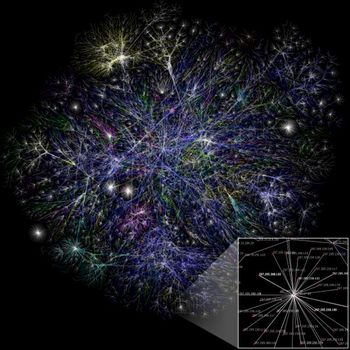
NASA Administrator Michael Griffin is picking up steam in his speeches he is delivering all around the US and abroad on NASA's plans for the future. Here are two of his recent talks, one in Houston Texas, and one at the World Economic Forum in Davos, Switserland. In the latter, I found a quote which resonates with a topic I am starting to get more and more curious about:
I am sure that many of you would agree with me that the greatest revolution in our productivity and way of life has been the development of the personal computer, internet and various handheld communication devices. Thirty-five years ago, engineers like me used three pieces of wood and a piece of plastic that moved -- the slide rule -- to make calculations. Thirty years ago, 1,000 transistors could fit on a silicon chip; today, it's 100 million. The cost of such chips has dropped by a factor of 100,000. Few people know that the development of the first microprocessors was born of a competition between Fairchild and Intel in the 1960s, to build components small enough to fit in NASA spacecraft. This straightforward NASA technical requirement spawned a whole new industry that grew in ways few, except perhaps Gordon Moore, could predict. Necessity is the mother of invention, and I believe that we are at our most creative when we embark on bold ventures like the space program.
The main point here is the relationship between the space endevour and the origins of the chip industry. With this year's 50th anniversary of the first satellite in orbit (Sputnik), it seems the most influential societal outcome of space exploration sofar has been the rise of the computer. I more and more like the term 'emerging technologies' in this respect. On a side note, the launch of Sputnik also stirred the creation of the US 'Advanced Research Project Agency (ARPA)', which later during the Apollo days set up the precursor of the Internet known as ARPANET. I am interested to find out if there has been some more indepth study into this relationship.
Just in: Google's virtual world
Posted on Thursday, January 25, 2007
Update: seems this meme touches a nerve, cause it is spreading to where I normally don't see any discussions on Google Earth or Second life, such as the blog by John Battelle.
The rumor continues...Google's Metaverse (via Google Earth Blog). Best comment sofar by Tom Churn:
If you work in this industry, you’re already living in Google’s Virtual World. At least, for about 10 hours a day…
As always, Brownian Emotion has an interesting perspective on things, like:
Rumors persist that Google is in the process of turning Google Earth into a virtual world. Well, I hate to burst anyone’s bubble, but GE already is a virtual world. It’s a virtual earth. It has all of the features of a virtual world (spatiality, point of view, presence, information modeling), minus a few we’ve come to expect from a game or socially-oriented space (seeing yourself, seeing other people, and directly interacting togther).
Reading his post, I was thinking the same thing as I just read on OgleEarth: it maybe so that for planet Earth Google Earth is a mirror world and not a virtual one, but what about all those other worlds out there? What about Mars for example? Is there any (evolutionary?) logic in allowing people to build a virtual world ontop of Mars imagery...I mean...no one is going to get there anytime soon except for some robotic explorers, so apart from the imagery, there is not really the chance of mixing up the 'real' world with a customly-designed virtual one. The only question is: what is the added value of building a virtual world as a mashup on another planet, instead of creating a completely user-generated SL type of virtual world?
Google Earth Panorama Viewer
Posted on Thursday, January 25, 2007
One more thingGUI: the Google Earth Panorama Viewer. This one is definitely here to stay and evolve to even more immersiveness. Its beautiful, even in its current 'crude' state. Created by Digital Urban, it has been making quite some furore in the blogosphere (like OgleEarth, Google Earth Blog and MAKE blog). Check out the above video (I am not so sure about the music...you might wanna turn it off ;-) and have a look at this tutorial and some other panoramas at the Digital Urban blog.
It ties in with the Gigapan camera project I learned about while over at NASA Ames last year in combination with Brownian Emotion discussing a possible next step for Google Earth, where these panoramas would be viewed not outside Google's Earth as a separate sphere but inside of it :
As a exercise, imagine yourself inside the Google Earth, assuming it’s hollow and the imagery you usually see sits on a thin glass shell that can be viewed from inside as well as outside the Earth. If you’re in the center of the sphere, what you’re seeing is essentially the same as a virtual panorama. The same mouse controls that let you spin the Earth now let you spin the panorama from the inside, grabbing that shell like you’d grab the ground. The main difference between this and flying up above the Earth, apart from the imagery and the source, is just the point of view of the observer.
Jeff Han's multi touch
Posted on Thursday, January 25, 2007
Its been around for a while already (in Internet terms that means what, a couple of days?), but for those of you who haven't seen it: a new video showing the next generation multi touch screen (via OgleEarth amongst others). Here is the article that goes with it.
Gibson on space travel
Posted on Thursday, January 25, 2007
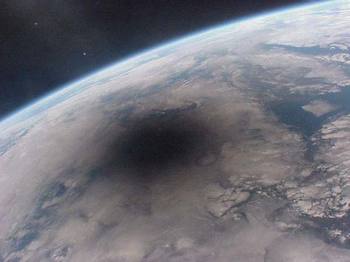
If the ideas of contemporary science fiction writers is anything to go by, here is an interesting interview with William Gibson from back in 1999, where amongst other things, he says the following:
While we were dreaming about spreading our chromosomes, the species was spinning this prosthetic nervous system for itself, and that's what's driving social change now. It's not legislation, it's not population pressures. Where we're going is the result of emerging technologies, and that's terribly rich ground for a science fiction writer.The above image of a Solar eclipse as seen from space is one of the last images made from the MIR station before it was brought down in 2001. In the interview, Gibson specifically refers to it, saying:
I was really deeply moved by one of the last photographs to come out of that station, an image of the Earth seen during the solar eclipse. I thought to myself, "we've never had that camera angle before.
Btw, if the space.com website is any hint at what the main internet portal to outer space will be like (its one of the more popular space related websites at the moment I believe), there is still lots of work to be done...the design is just...well...terrible...!
Tobedetermined finds...Agents of Evolution
Posted on Wednesday, January 17, 2007
- Futurist Peter Schwartz introduces an interesting term new to me in this article: Agents of Evolution
- O'Reilly Radar: Measuring a virtual world and If Google were a restaurant
- How about one of the above cameras onboard the ISS?
- Back to the 50's: China destroys old weather satellite
- Google wants YOU! in Google Earth: Google's Australia Day 2007 aerial photography. Turns out, Microsoft is planning to do the same, with the oh, so Microsofty catchphrase 'Look Up and Smile this Australia Day'
- The archives: Google's Master Plan
Geostationary playground
Posted on Tuesday, January 16, 2007
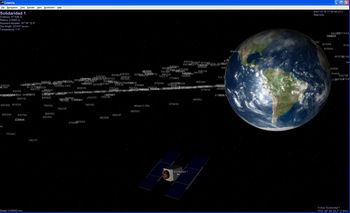
Click to enlarge
Thinking about how 3 dimensional outer space could be represented inside virtual globe environments, I spent some time flying around the Solar System in Celestia. Incorporating some of the satellite plugins available at the Celestia Motherlode, I managed to get the Geostationary ring become visible with all its +100 telecommunication satellites. The nice thing about Celestia is that it allows you to lock onto any object you happen to pass by, so zooming into the individual satellites now visible, I circled the Earth by hopping from one satellite to the next. Funny enough, it actually did gave me a feel of being 'out there', looking down at the Earth from 35,786 km altitude.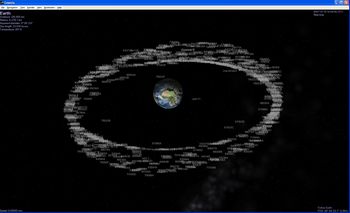
Click to enlarge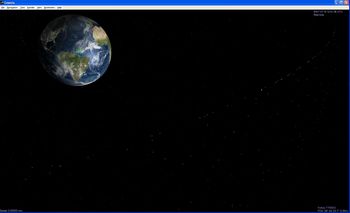
Click to enlarge
Google Earth zeitgeist
Posted on Friday, January 12, 2007
How about a Google Earth zeitgeist, served to you as a kml overlay, or, while we're at it, why not as a dedicated layer inside GE? One where we get to see the most popular places looked at in Google Earth, categorised by lat/lon, altitude and some other specifics? One advantage: there is no need to filter out such terms as sex and alike.
Another idea I just had, how about airlines providing GE-ready GPS trails of the flight you just got off from. You provide your email address while on the plane, and once you land its automatically send to your email box. Nice for some post-flight recollection of what exactly you saw in that twilight zone state when you opened your eyes those 5 seconds and looked out the window before finding another 'comfortable' position to fall back to sleep in. This happened to me on a flight to San Francisco last year where I have vague memories of seeing polar bears fly next to the plane when we passed over the American continent half way up the artic.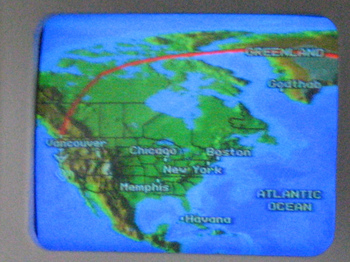
A live flight tracking is already available.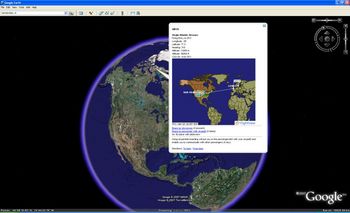
Click to enlarge
With a GPS trail, it could look something like GoogleEarthBlog's trip back from Las Cruces.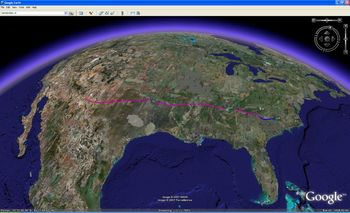
Click to enlarge
tobedetermined finds...
Posted on Monday, January 8, 2007
- Just in: Google teams up with a large group of universities, research institutions and private companies to become the archival experts for the Large Synoptic Survey Telescope (via OgleEarth). Makes sense to me ;)
- Backlog: OgleEarth shares some interesting reflections in this post on the possibilities following December's collaboration announcement between Google and NASA.
- This year is the 50th anniversary of the launch of the first articificial satellite Sputnik in October 4th 1957 (Listen to the sound of Sputnik as it passed over in those days). This weekend's M special of the Dutch newspaper NRC handelsblad is all about the Internet. Their introduction (my translation):
1 billion Earthlings connected to the Internet
50 years ago the Russians launched their Sputnik. The Americans got scared shitless and developed an invulnerable military information network which saw the birth of the Internet. Today, the net belongs to the massess. - ESA news: First 3D map of the Universe's dark matter scaffolding
- Google Earth Blog has the story of a French company Pict'Earth offering a remote control plane with camera capturing realtime images for Google Earth. OgleEarth picked up the story and expands on it
- Webcasts are available from the 2nd Space Exploration Conference in Houston 4-6 December last year. Unfortunately they're coded in Realplayer, so no offline viewing/listening
Terraforming cyberspace
Posted on Friday, December 29, 2006
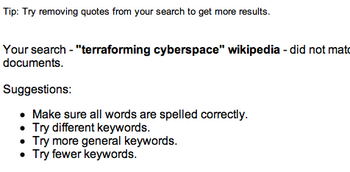
What, such a nice term with no wikipedia entry: terraforming cyberspace ? Isn't that what is going on inside Google Earth, Microsoft Virtual Earth and Second Life? Or is it 'terraforming Earth for the agents' (e.g using the DARPA Agent Markup Language)?. Following this line of thought, I stumble upon an interesting Google Earth overlay displaying the global status of the Grid via this press release: Grid computing 'Mappa Mundi' unveiled in Florida
Visitors to Supercomputing '06 in Tampa, Florida this week will be the first to see a new interactive map that shows nine of the world's largest computing Grids. The map, developed by researchers from GridPP in the UK and the European particle physics laboratory, CERN, in Geneva, uses Google Earth to pinpoint Grid sites on six continents, showing more than 300 sites overall. Like the medieval 'mappa mundi', which showed what was known of the world at the time, this is one of the first attempts to show the whole scientific Grid world.More via physorg.com. And from the article on 'terraforming cyberspace':
Tomorrow’s world will be filled with agents embedded everywhere in the places and things around us. Providing a pervasive web of sensors and effectors, these agents will function as cognitive prostheses— computational systems that leverage and extend human intellectual, perceptual, and collaborative capacities, just as a steam shovel is a sort of muscular prosthesis or eyeglasses are a sort of visual prosthesis. Thus, the focus of AI research is destined to shift from artificial intelligence to augmented intelligence.
Now in order for the agents to offer augmented intelligence, they will first of all need to know the location and all that surrounds it...GPS gives it location...virtual globes its situational awareness...
Welcome to the real world
Posted on Sunday, December 24, 2006

Being relatively new to the blogging game, I am stupéfait about the sophistication of the Google ad machine...take the red pill and have a look at this introduction about Google Analytics. If you ever wondered about monetization of the database of intentions...
The home computer in 2004
Posted on Saturday, December 23, 2006
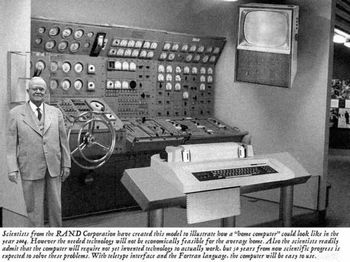
"Scientists from the RAND Corporation have created this model to illustrate how a 'home computer' could look like in the year 2004. However the needed technology will not be economically feasible for the average home. Also the scientists readily admit that the computer will require not yet invented technology to actually work, but 50 years from now scientific progress is expected to solve these problems. With teletype interface and the Fortran language, the computer will be easy to use."
Where do you want to sail to today...? (from urbanlegends.about.com)
Zooming out in Google Earth
Posted on Saturday, December 16, 2006
' 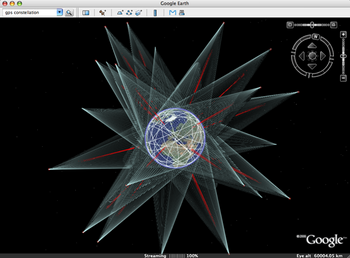
How long before Google Earth levels (and surpasses?) STK, the arcGIS of space...?
Above image is a screendump of one of the ![]() beautiful layers provided by Google Earth Community (GEC) member Paul Seabury (via Google Earth Blog). This
beautiful layers provided by Google Earth Community (GEC) member Paul Seabury (via Google Earth Blog). This ![]() particular one shows the GPS constellation in orbit around the Earth, together with a footprint of each individual satellite. Which reminds me of an earlier mash-up thought experiment I did by superimposing a Google Earth screendump with an image of the NASA J-Track 3D Java applet (see below). To get a feel of what that could be like, see instructions on the J-Track 3D opening page, click individual satellites to highlight their orbits, and drag the viewpoint around. Its a very light application and the combination of zooming and tilting the scene really 'gives handles' to the Geostationary orbit.
particular one shows the GPS constellation in orbit around the Earth, together with a footprint of each individual satellite. Which reminds me of an earlier mash-up thought experiment I did by superimposing a Google Earth screendump with an image of the NASA J-Track 3D Java applet (see below). To get a feel of what that could be like, see instructions on the J-Track 3D opening page, click individual satellites to highlight their orbits, and drag the viewpoint around. Its a very light application and the combination of zooming and tilting the scene really 'gives handles' to the Geostationary orbit.
Its a limitation of Google Earth I regularly run into: the limitation in the ability to zoom out. Currently, the furthest one can zoom out is to 'eye altitude 62355.98 km' (how does that work again?), not even enough to view the complete Geostationary ring, as is apparent in below image of ![]() Paul's Geostationary satellites layer (note zoom level of the two images is nearly identical).
Paul's Geostationary satellites layer (note zoom level of the two images is nearly identical).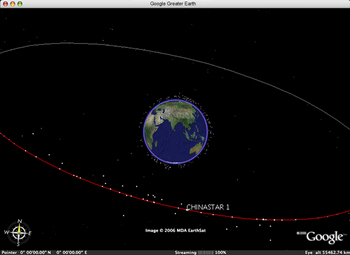
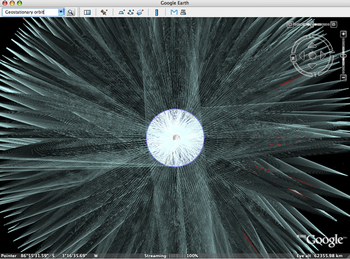
Arpanet of the future
Posted on Saturday, December 16, 2006
Here is a video I posted before about the early days of the Internet (Arpanet). Watching it again, its funny to see how the original ideas apply to the upcoming web as discussed in this Web2.0 Summit videocast between Eric Schmidt and John Battelle.
DinnerTV: Kurzweil, Gelernter, Dawkins & more
Posted on Saturday, December 2, 2006
- Ray Kurzweil and David Gelernter debate machine conciousness (2:43:30)
- Richard Dawkins on "The big Question: Why are we here?" (23:34)
- Geoserver Tech Talk at Google (54:10)
- NASA To the Moon and beyond (03:56) (is that animation done in Second Life or what?) (via brownian emotion)
Virtual space exploration update
Posted on Saturday, December 2, 2006
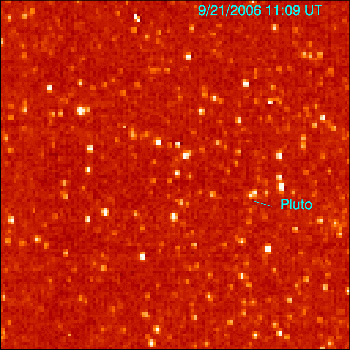
Seen at a distance of 4.2 billion kilometers, NASA's New Horizons mission captured a glimpse of its final target Pluto late September. Last week, NASA's Mars Reconnaissance Orbiter (MRO) mission located the landing site of the Mars Exploration Rover Opportunity (via Nasa Watch). By now, MRO's HiRISE team is flooding Mars images over the Internet.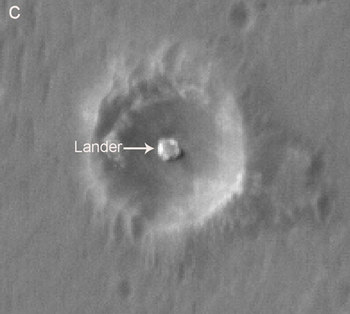
tobedetermined finds...
Posted on Tuesday, November 28, 2006
- Swedish space art
- web3.0 here we go...and here too.0
- ISU's Space Odyssey Institute to launch at the ISU Summer Session in Beijing
- ISU's 11th Annual International Symposium "Why the Moon?"
- Point to the sky and the SkyScout will tell you what you are looking at
- The SpaceNavigator, a new 3D mouse for virtual globes like Google Earth
Satellites, humans, and the Internet of Things
Posted on Monday, November 20, 2006
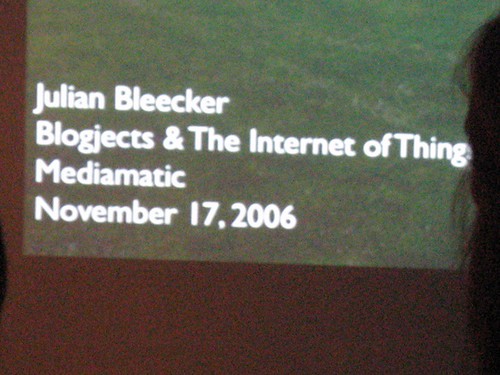
Julian Bleecker was here in Amsterdam for the RFID workshop at Mediamatic. Friday evening he gave a public talk on 'blogjects & the Internet of Things'. Made me think: what are satellites other than blogjects? (more on blogjects at Julian's techkwondo) And what about humans as presented here at Neven Vision? 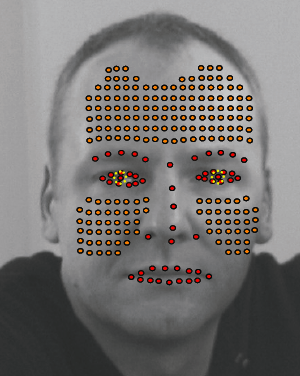
'...scroll over him with your mouse cursors...and...right-click!!'...Indeed, a good point by Julian: what do we learn that is useful from WoW 1008?
'realtime view of the Earth' widget?
Posted on Sunday, November 19, 2006
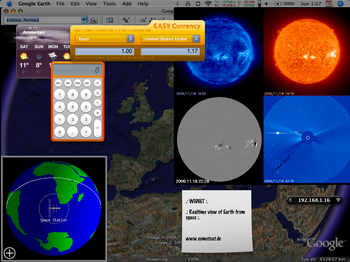
Just in: a demo video of Microsoft Virtual Earth 3D (which comes out blank on my macintosh btw) (via OgleEarth). Where do you want to go today? What about here:
(more at the SOHO website)
online identity: tobedetermined
Posted on Saturday, November 18, 2006
Just found out my name brings up my 'name' website if you do the Google on me...handy...reminds me of an interesting presentation on 'identity2.0'. Something else, how about these webstats for NASA...pretty impressive ;) (via Alexa)
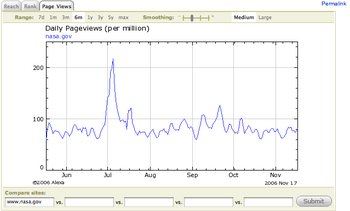
tobedetermined finds...a Google data center
Posted on Tuesday, November 14, 2006
I'll sometimes bring back an image/video which was in one of my earlier posts I lost when my blog (March-July 06) was accidentally erased from the server while over at the ISU Summer Session Programme 2006 in Strasbourg. This one is from an earlier article in the NY times.
citizen journalism
Posted on Tuesday, November 14, 2006
A word I picked up recently is 'citizen journalism'. Its a meme in creation...lets have a look at the steady rise of search results on 'citizen journalism' in Google.
Google: you tube
Posted on Wednesday, November 1, 2006
An excellent post on recent developments at YouTube by John Battelle.
And its getting better. Here is a related article that I found in the comments to above blog post.
An interesting read...
Posted on Wednesday, October 25, 2006
I haven't had much chance (or better: chose not to spent the time) myself lately to dive into the Virtual Worlds (VW) of World of Warcraft (WoW), Second Life, Multiverse, etc (except for Google Earth maybe, but that's different...sofar...probably that will chance in the future). Come to think of it, I did once install Second Life on my macintosh about a year ago, and flew around for a couple of nights...interesting experience I remember, standing up, and then smoothly go into flying mode...but beyond that it didn't really do it for me...yet...or better: chose not to dive into it further...yet...
I did recently finish Snowcrash, a book by Neal Stephenson, frequently quoted as being an inspiration for Google Earth (then Keyhole) developers, and an influential book for everybody thinking about (or dealing with) virtual worlds.
Anyway, getting to a point, I try to stay up to speed on the blogs I follow (see on the right here), and I notice there is more and more news and stories coming out on VWs, especially Second Life, but also on all other activities taking place in the virtual worlds arena. One example is this article, which I found via one of the key blogs on this topic, 3pointD.com.
Of course, the subject of this blog is the future merger of the virtual world of the computer and the 'virtual' world of outer space...and when I think of it, it makes perfect sense...but its far from being there, which is ok cause it leaves some room for definition...
Btw, here I found another interesting text on the subject, an interview of Space.com with William Gibson, dating back to 1999.
Something else to check: emerging technologies...
The future is process, not a destination
Bruce Sterling
Everything is ultimately becoming information technology
Ray Kurzweil
Data is the Intel inside
Tim O'Reilly
There is only one machine and the web is its OS
Kevin Kelly
The medium is the message
Marshall McLuhan

